生理学研究所大学院「感覚認知機構論」(小松英彦先生)の1コマ
生理研明大寺研究棟1F講義室・2013年10月25日(金)10:00-12:00
錯視の感覚認知メカニズム
"Visual Illusion: Its Mechanisms of Perception and Cognition"
北岡明佳(立命館大学文学部心理学専攻)
Akiyoshi Kitaoka, Department of Psychology, Ritsumeikan University
since October 19, 2013 Handout
静止画が動いて見える錯視 フレーザー・ウィルコックス錯視群
Motion illusion in a static oimage: Fraser-Wilcox illusion group
特定の繰り返しのパターンに沿って動いて見える錯視である。 It is an illusory motion along repetitive patterns.
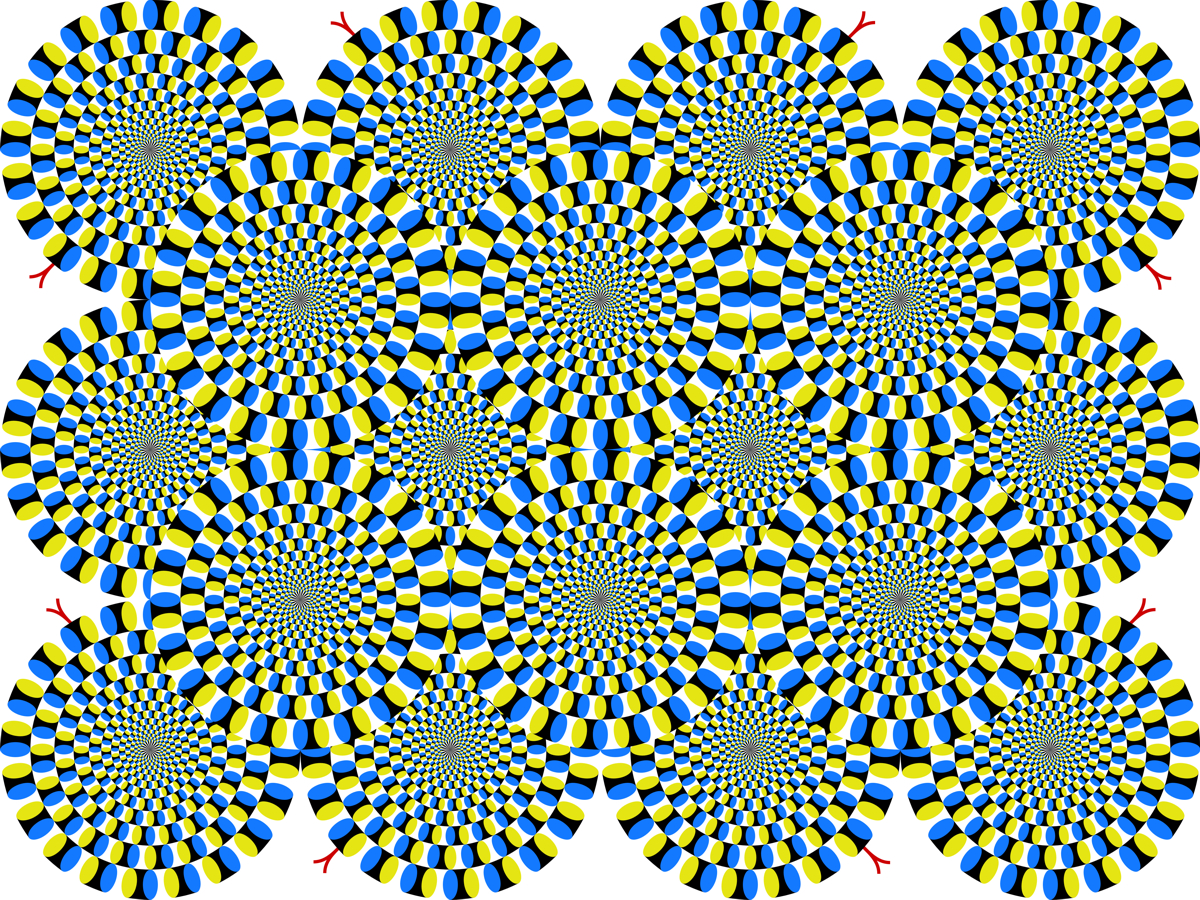
「蛇の回転」
(リメーク)
"Rotating snakes"
(a remke)
Copyright Akiyoshi Kitaoka 2013 (February 16)
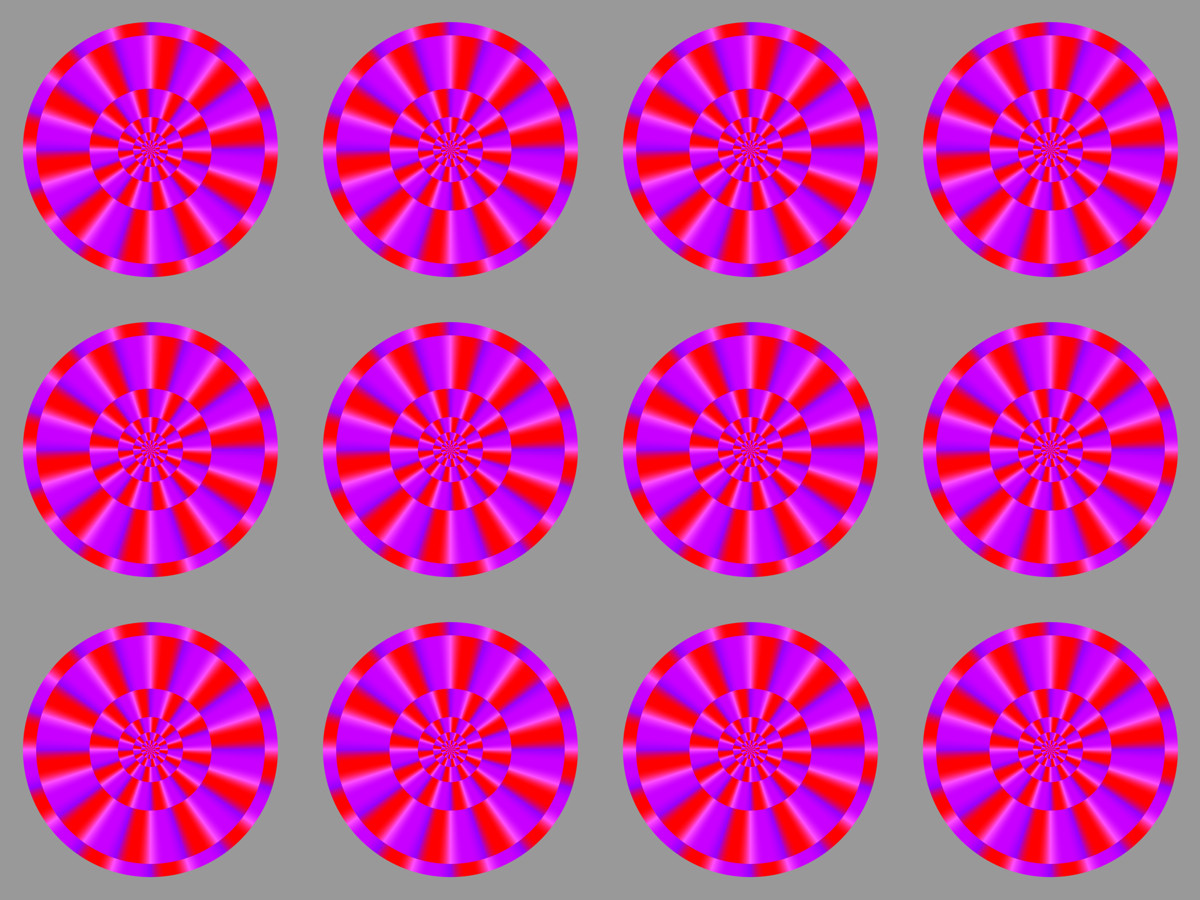
"Rotating red-and-purple disks"
Each disk appears to rotate clockwise on a bright display, while it appears to rotate counterclockwise with a printed image under dark illumination.
Copyright Akiyoshi Kitaoka 2013 (February 6)
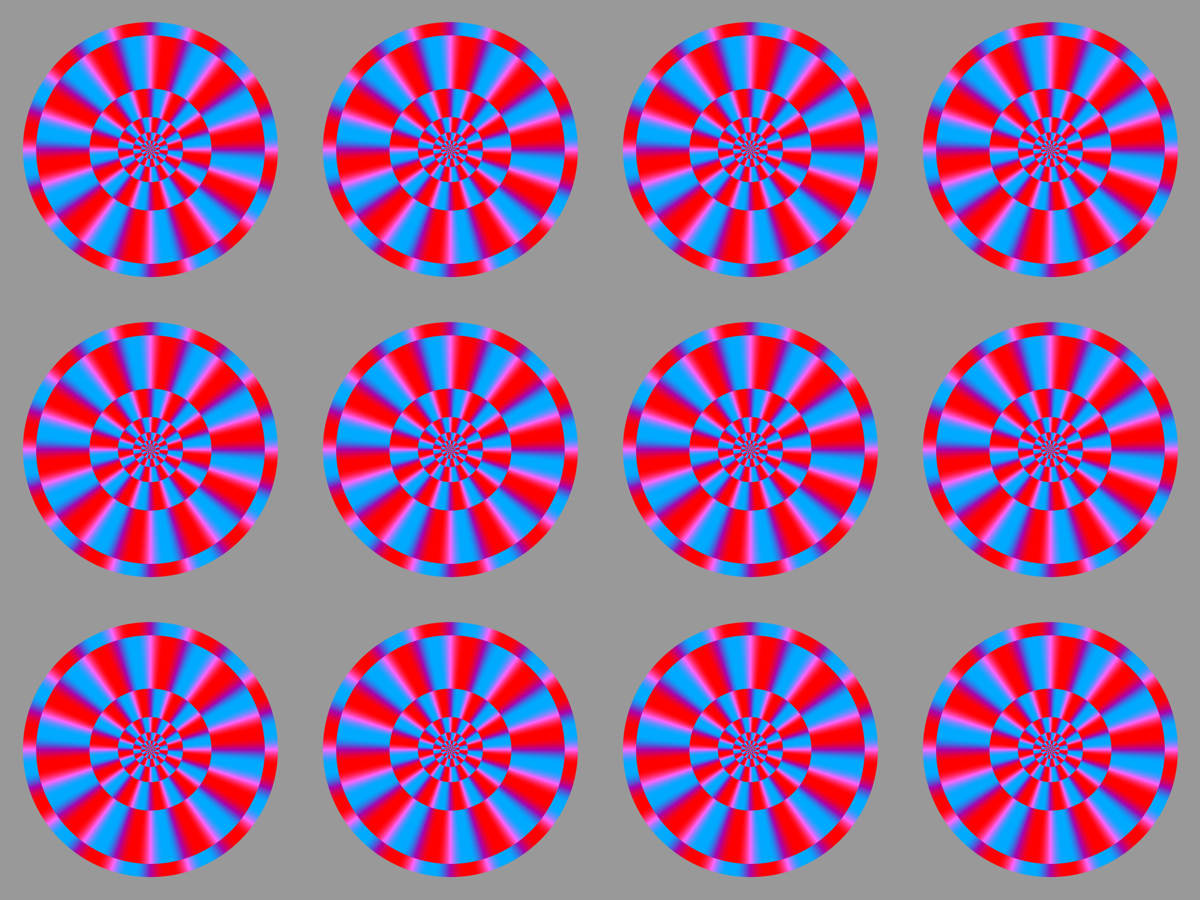
"Rotating red-and-cyan disks 2"
Each disk appears to rotate clockwise on a bright display, while it appears to rotate counterclockwise with a printed image under dark illumination.
Copyright Akiyoshi Kitaoka 2013 (February 6)
Conclusion in advance
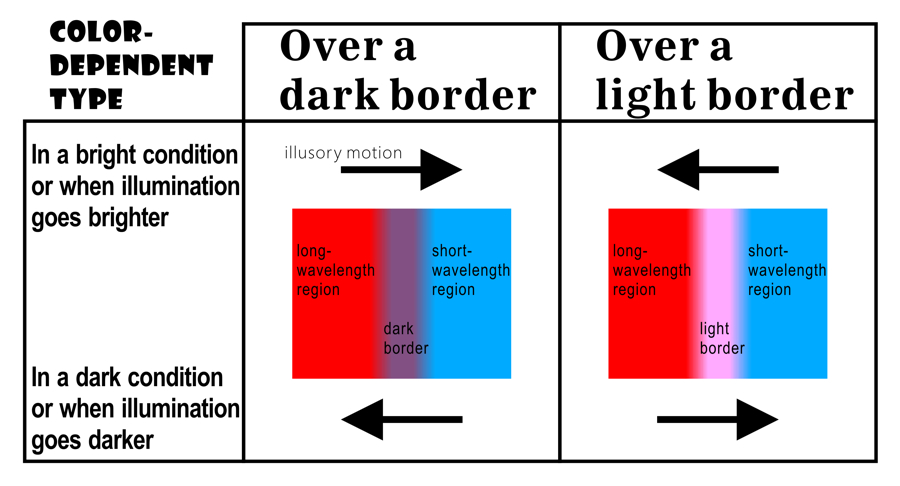
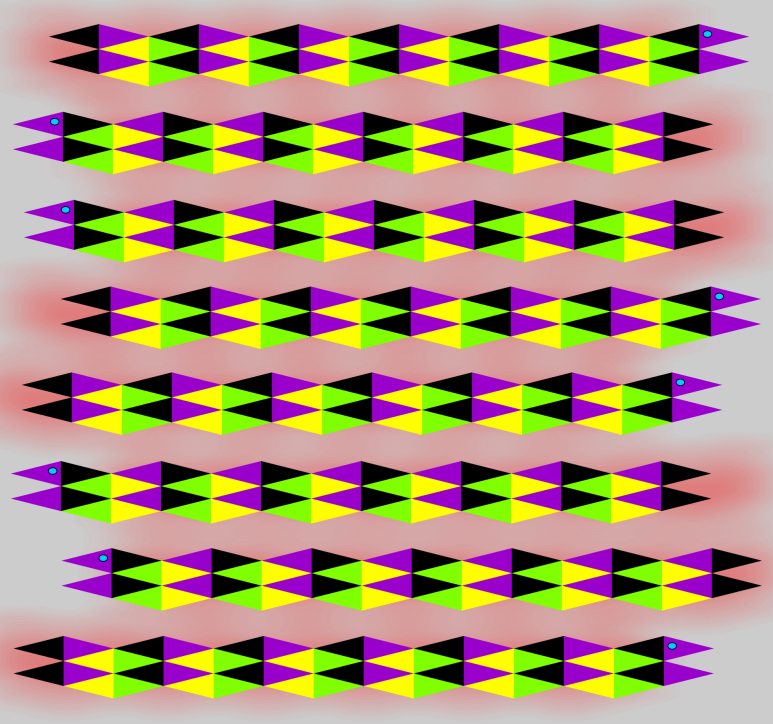
"Moving snakes with a cloud of dust"
Snakes appear to move horizontally.
Copyright Akiyoshi Kitaoka 2009 (June 7)
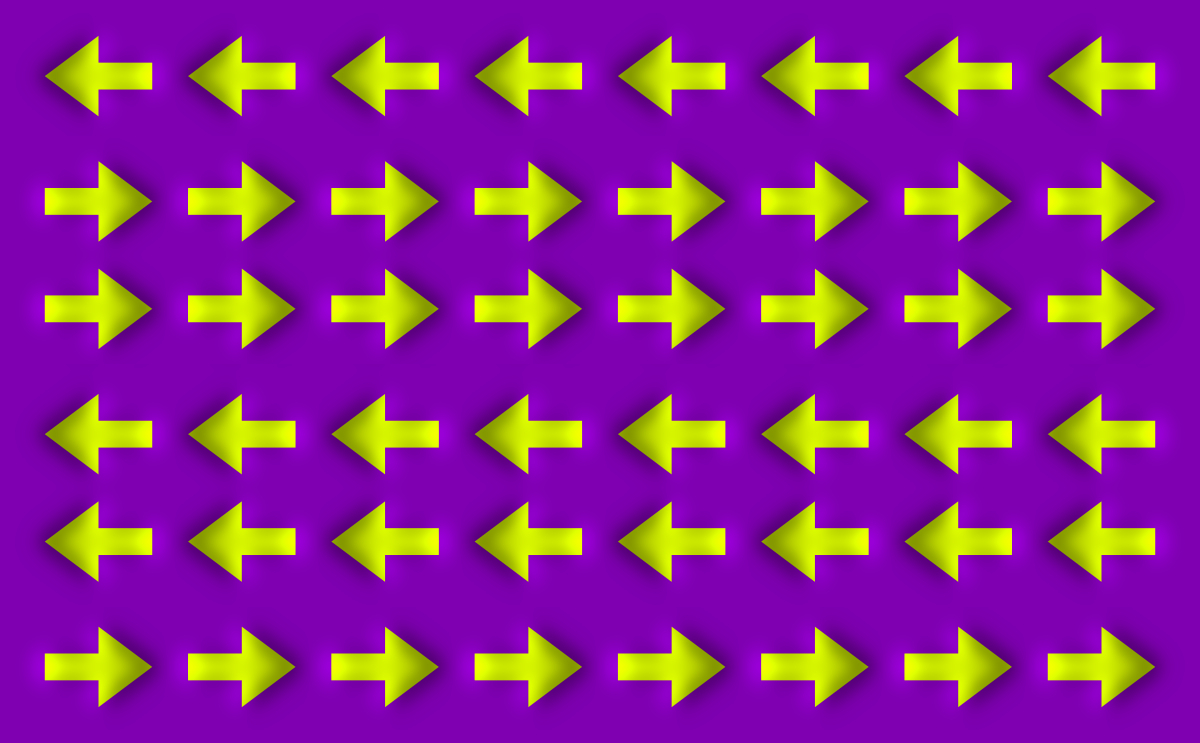
"Moving arrows illusion"
Arrows appear to move.
Copyright Akiyoshi Kitaoka 2013 (September 26)
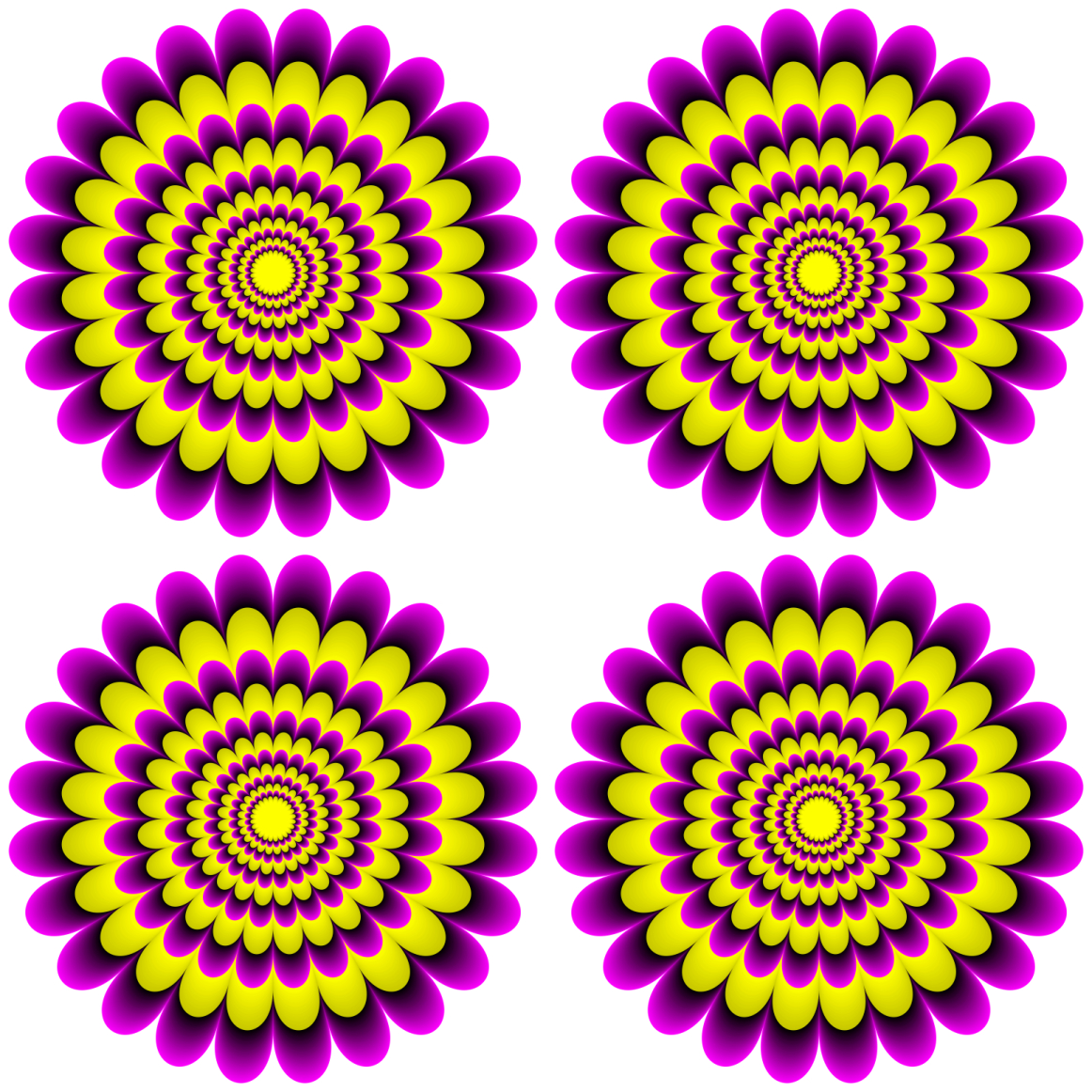
"Blooming flowers"
Flowers appear to expand.
Copyright Akiyoshi Kitaoka 2008 (March 11)
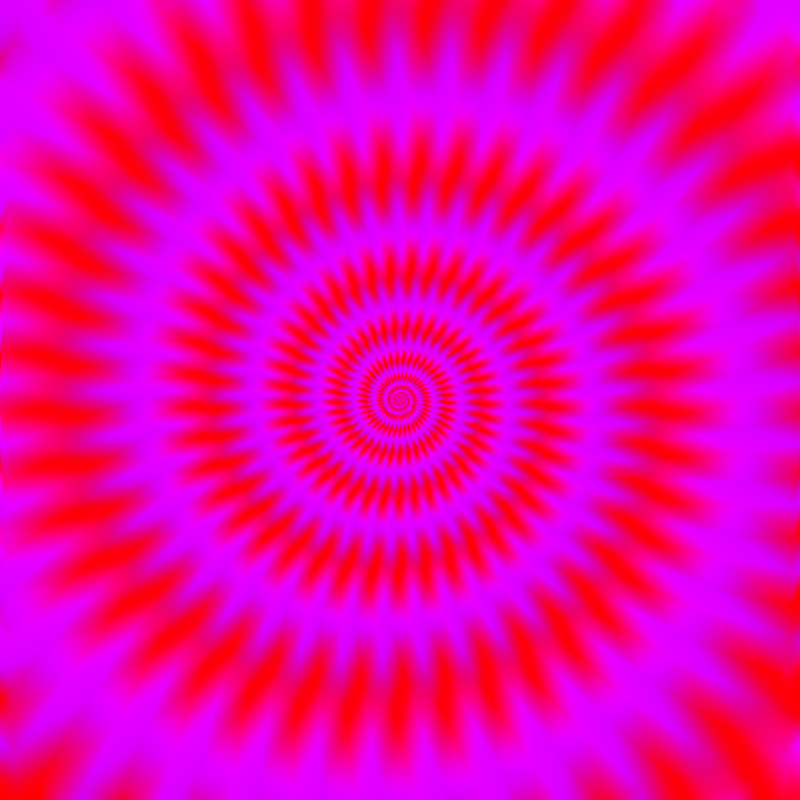
「ぐいぐい昇竜」
Ascending dragon
竜が昇っていくように見える(下から見たところ)。
An dragon appears to rise.
Copyright Akiyoshi Kitaoka 2011 (February 12)
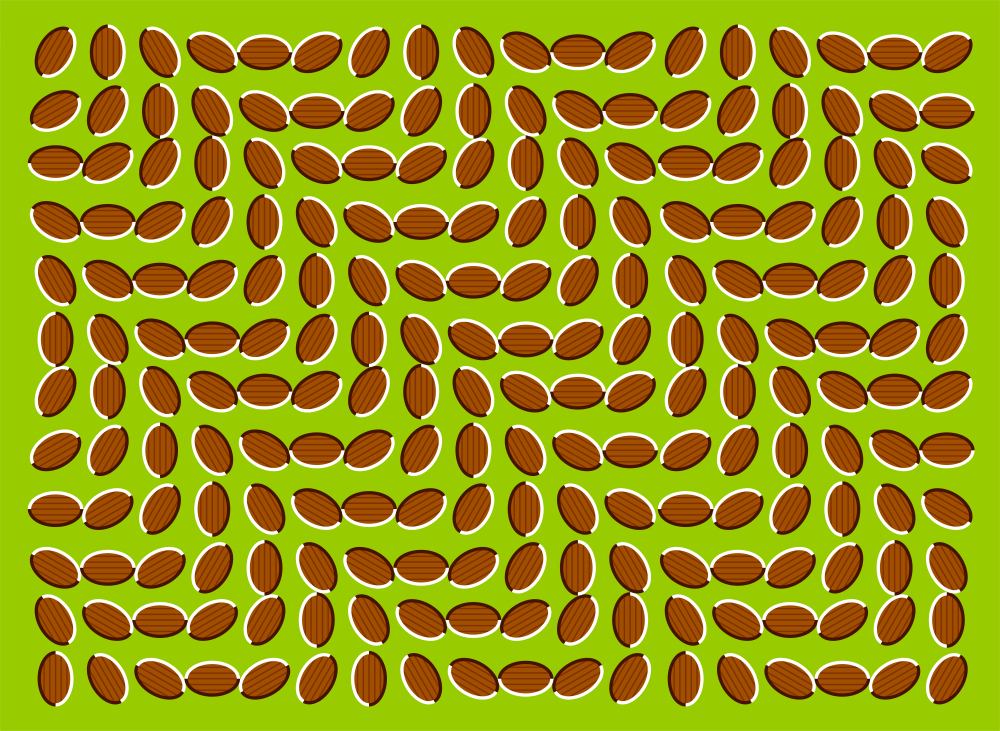
"Dongurakokko" (The donguri wave)
Donguri (acorns) appear to wave.
Copyright A.Kitaoka 2004 (April 19)
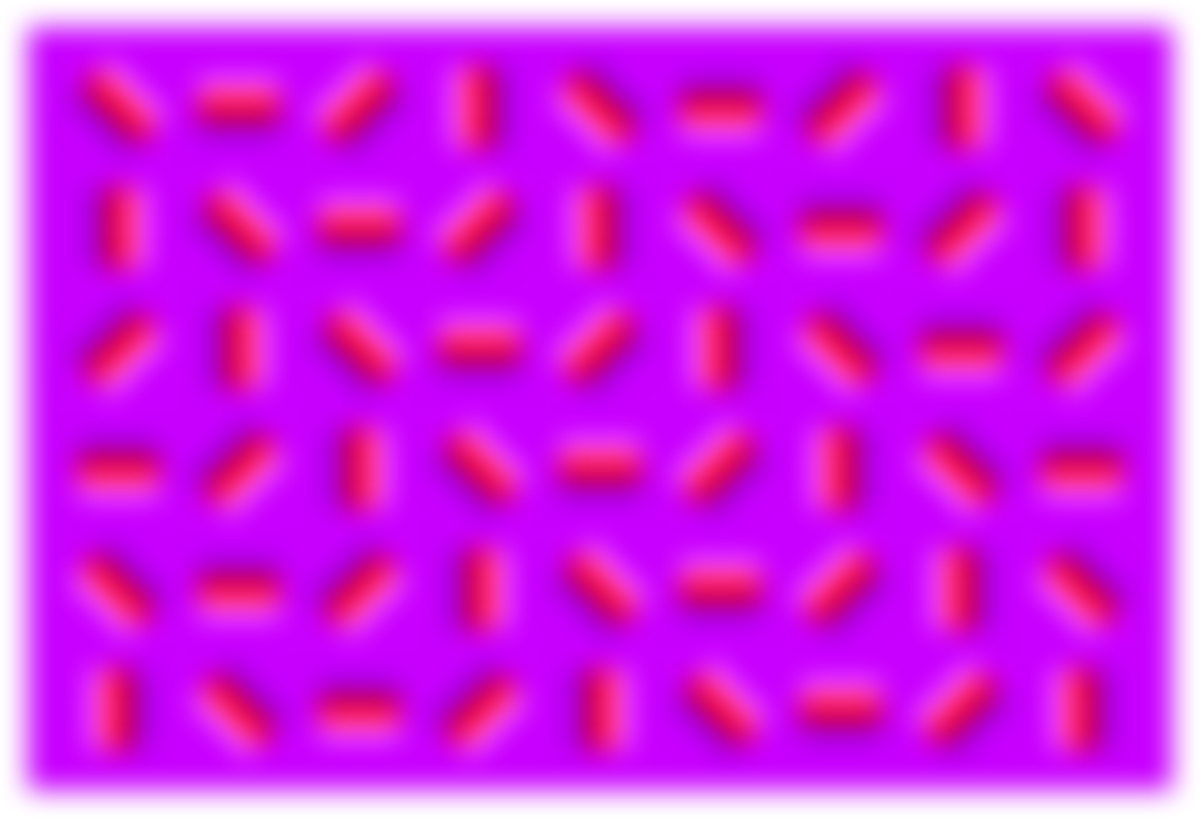
「トロの波」
図が波打って見える。
Copyright Akiyoshi Kitaoka 2011 (September 5)
A brief history of phenomenal aspects of the Fraser-Wilcox illusion group
<Kitaoka, A. (forthcoming). The Fraser-Wilcox illusion and its extension. In Shapiro, A. and Todorovic, D. (Eds.), Oxford Compendium of Visual Illusions. Oxford University Press.>
1. Fraser and Wilcox (1979)
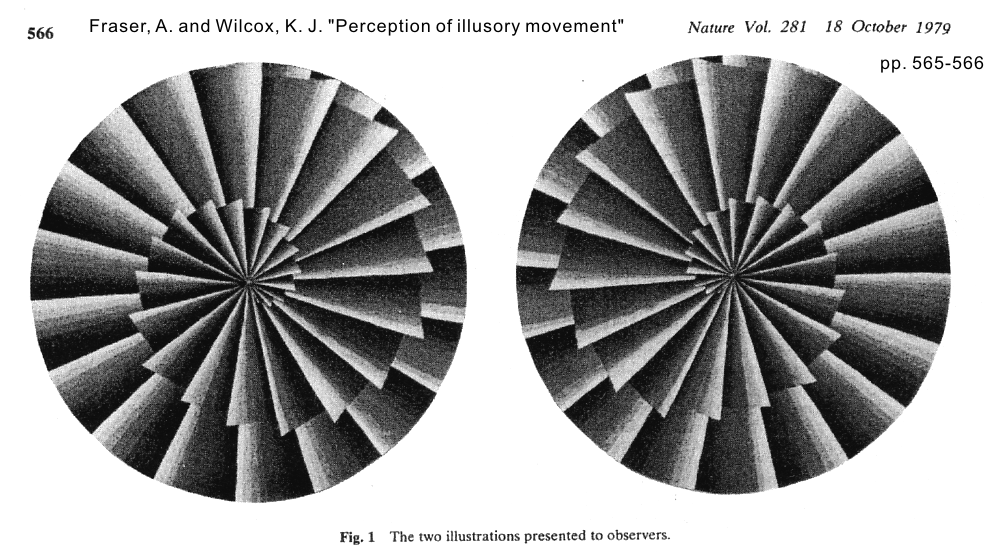
References
Fraser, A. and Wilcox, K. J. (1979). Perception of illusory movement. Nature, 281, 565-566.
Observers saw illusory motion in a stationary image which consists of repeated luminnace gradient in a saw-tooth wave form. Some reported illusory motion from dark to light along a luminance gradient, while others saw the reversal. The illusion is strong in the peripheral viewing. Fraser and Wilcox (1979) claimed that this individual difference depends on some genetic properties.
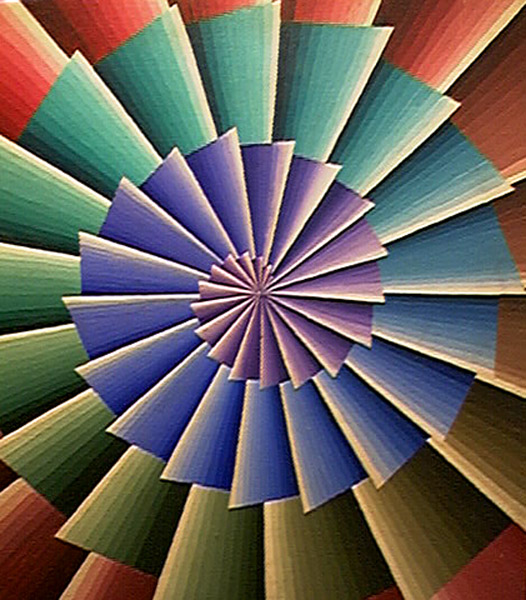
Adopted from “Alex Fraser, Geneticist and Painter”
(http://doctoralexfraser.blogspot.jp/p/spirals.html) <access August 25, 2012> (with permission from Alan Fraser)
Alex Fraser (1923-2002) was a geneticist and a painter.
2. Faubert and Herbert (1999)
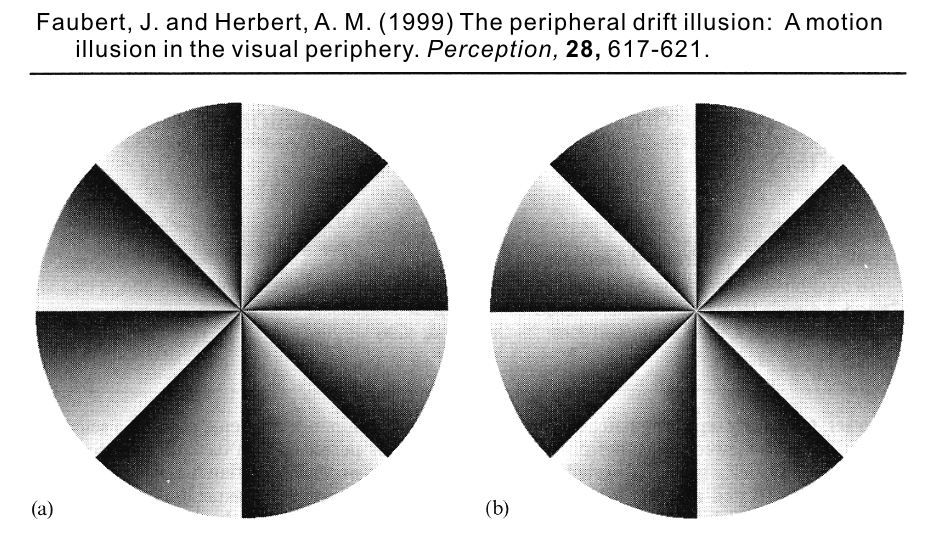
The left disk appears to rotate clockwise while the right one counterclockwise. Faubert and Herbert (1999) reported only illusory motion from dark to light along a luminance gradient. They attributed the illusory motion to the assumed time difference between responses to black and white.
References
Faubert, J. and Herbert, A. M. (1999). The peripheral drift illusion: A motion illusion in the visual periphery. Perception, 28, 617-621.
3. Naor-Raz and Sekuler (2000)
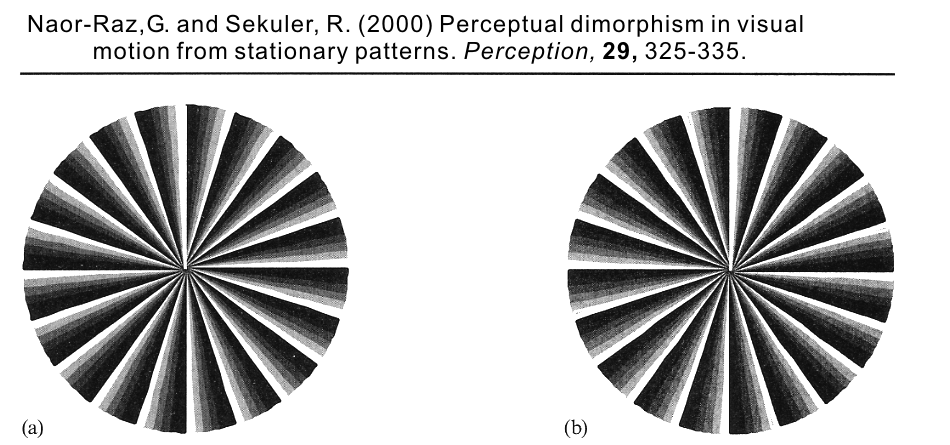
The left disk appears to rotate clockwise while the right one counterclockwise. Naor-Raz and Sekuler (2000), too, reported only illusory motion from dark to light along a luminance gradient. They revealed that the illusion magnitude is a positive, nearly linear function of contrast.
References
Naor-Raz, G. and Sekuler, R. (2000). Perceptual dimorphism in visual motion from stationary patterns. Perception, 29, 325-335.
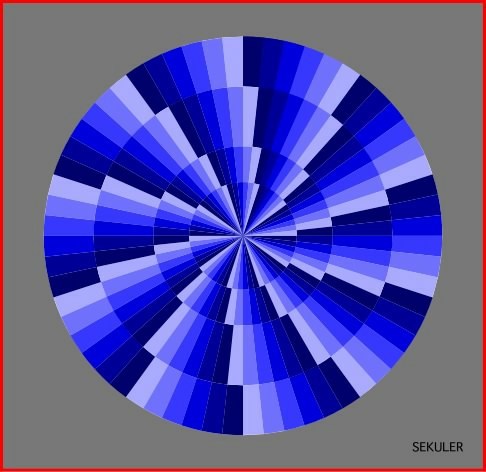
This disk appears to rotate clockwise.
This color illusion image presented by Naor-Raz and Sekuler (2000) (shown
below) might be attributable to this type.
http://www.perceptionweb.com/perception/perc0300/sekuler.jpg <access August 26, 2012>
<with permission from Robert Sekuler>
4. Kitaoka and Ashida (2003)
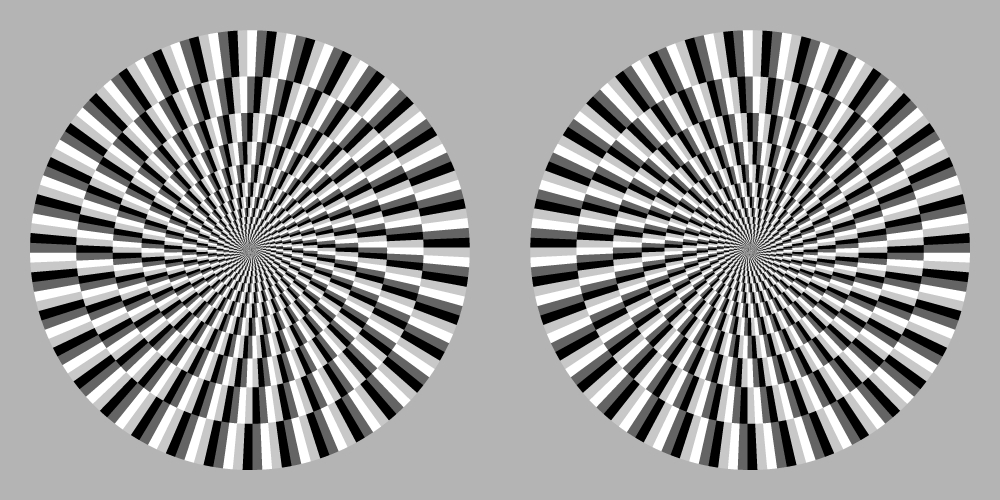
The left disk appears to rotate counterclockwise while the right one clockwise. Kitaoka and Ashida (2003) proposed that the illusory motion is strong when patterns are arranged in the following luminance order: from black, dark-gray, white, light-gray, and back to black.
References
Kitaoka, A. and Ashida, H. (2003). Phenomenal characteristics of the peripheral drift illusion. VISION (Journal of the Vision Society of Japan), 15, 261-262. PDF
5. Kitaoka (2007)
Kitaoka (2007) classified the Fraser-Wilcox illusion into Type I, IIa, IIb and III, in each of which the dark-to-light type was distinguished from the light-to-dark one.
References
Kitaoka, A. (2007) Phenomenal classification of the “optimized” Fraser-Wilcox illusion and the effect of color. Poster presentation in DemoNight, VSS2007, GWiz, Sarasota, Florida, USA, May 14, 2007.
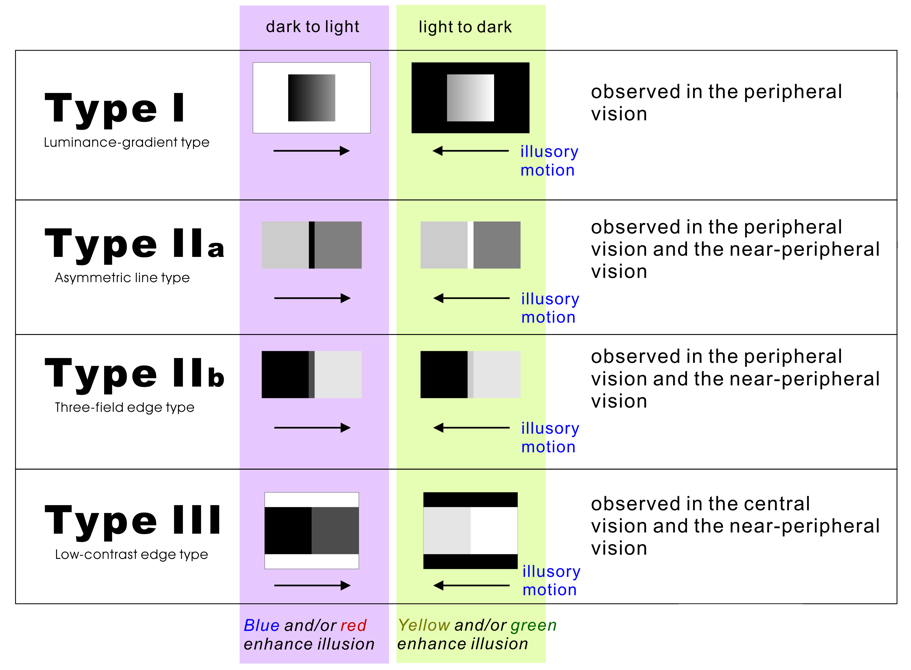
Type I
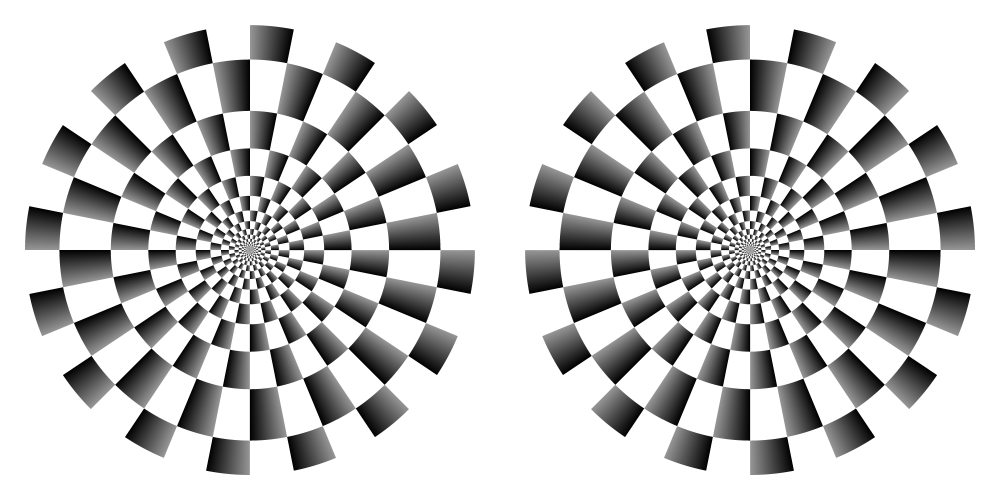
"Dark to light"
The left disk appears to rotate counterclockwise while the right one clockwise.
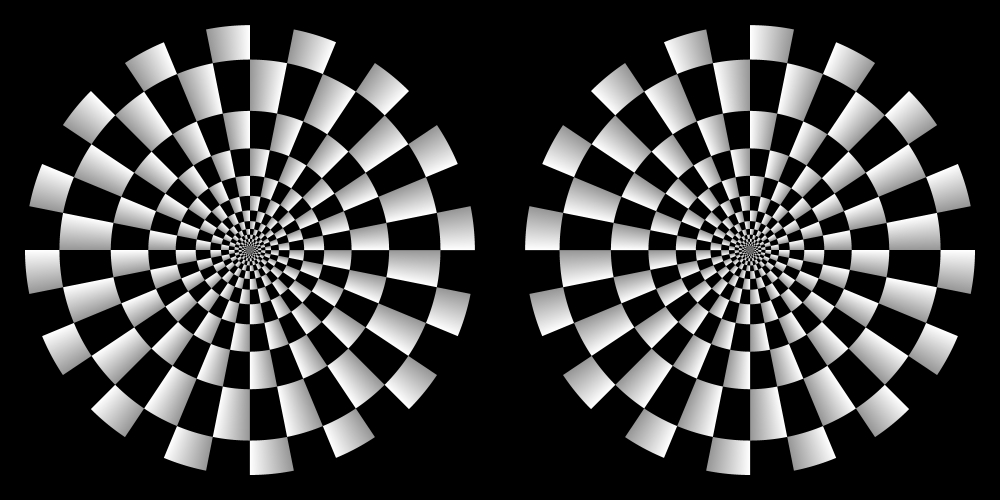
"Light to dark"
The left disk appears to rotate counterclockwise while the right one clockwise.
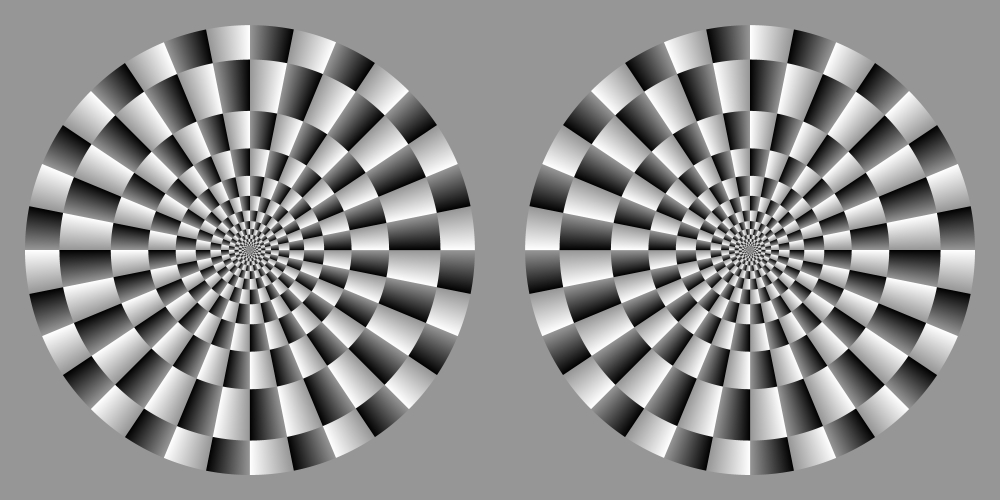
"Dark to light" and "light to dark" combined
The left disk appears to rotate counterclockwise while the right one clockwise.
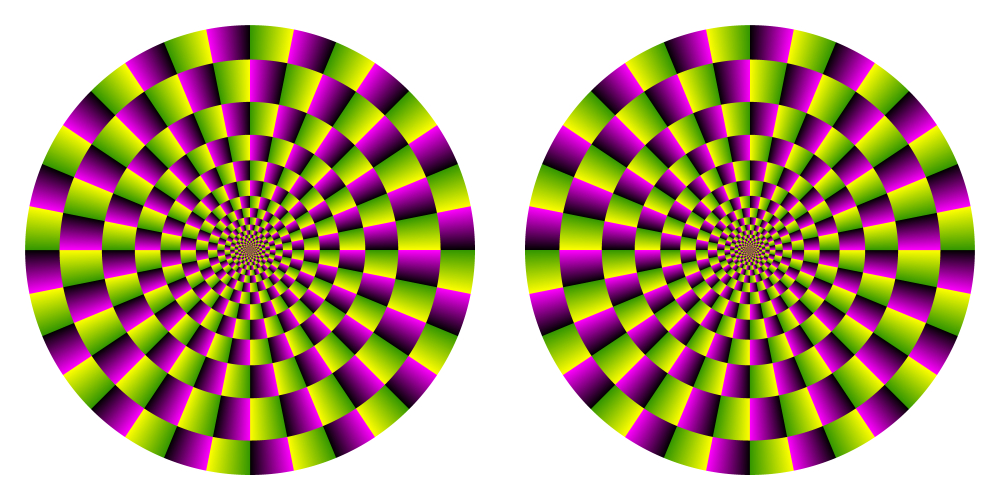
"Dark to light" and "light to dark" combined, with
color enhancement
The left disk appears to rotate counterclockwise while the right one clockwise.
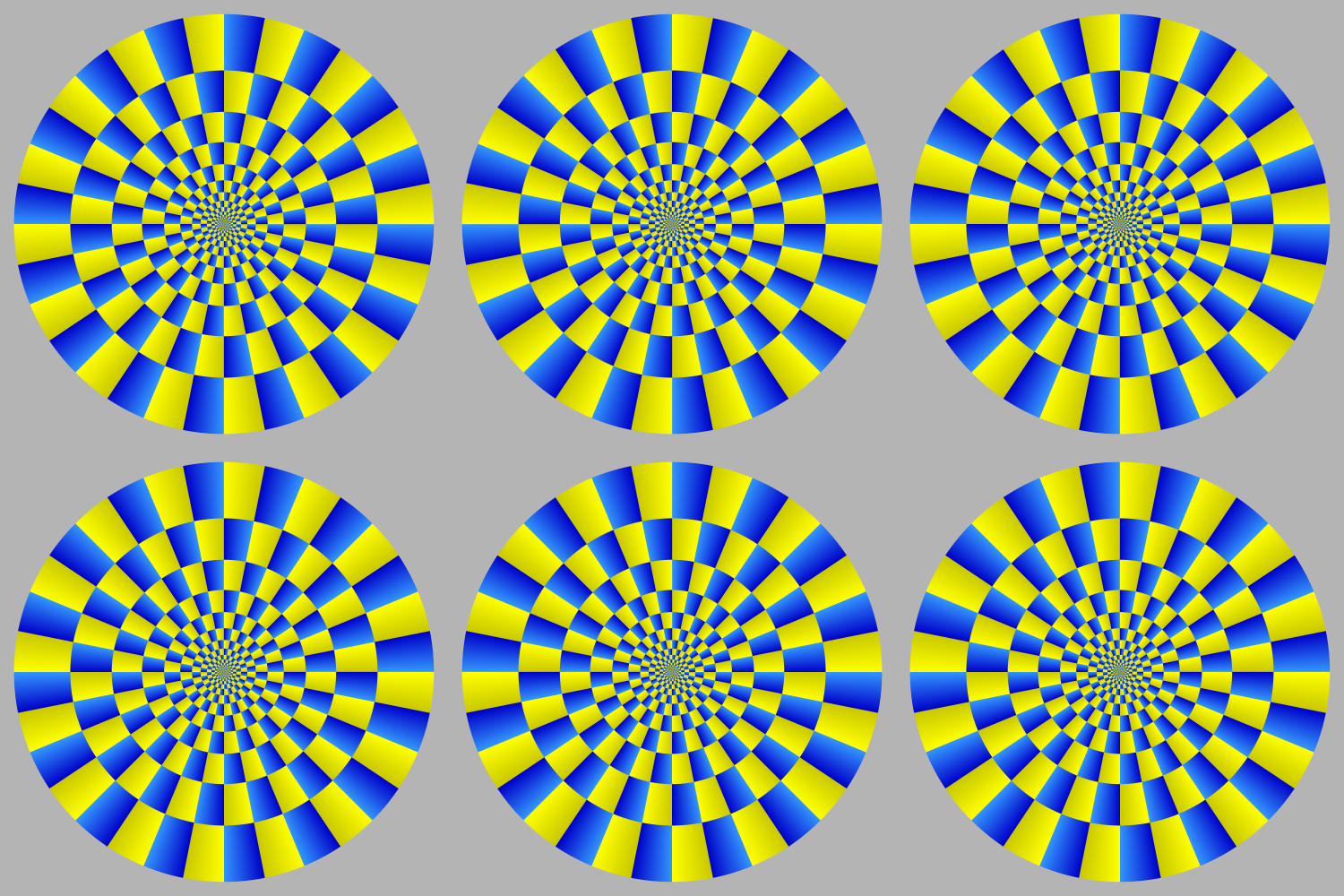
The upper-left, upper-right, and lower-middle disks appear to rotate counterclockwise
while the rest clockwise.
Type I (six disks) 1500 x 1000 (pixel)
Type I (six disks) 6000 x 4000 (pixel)
Type II
Type IIa
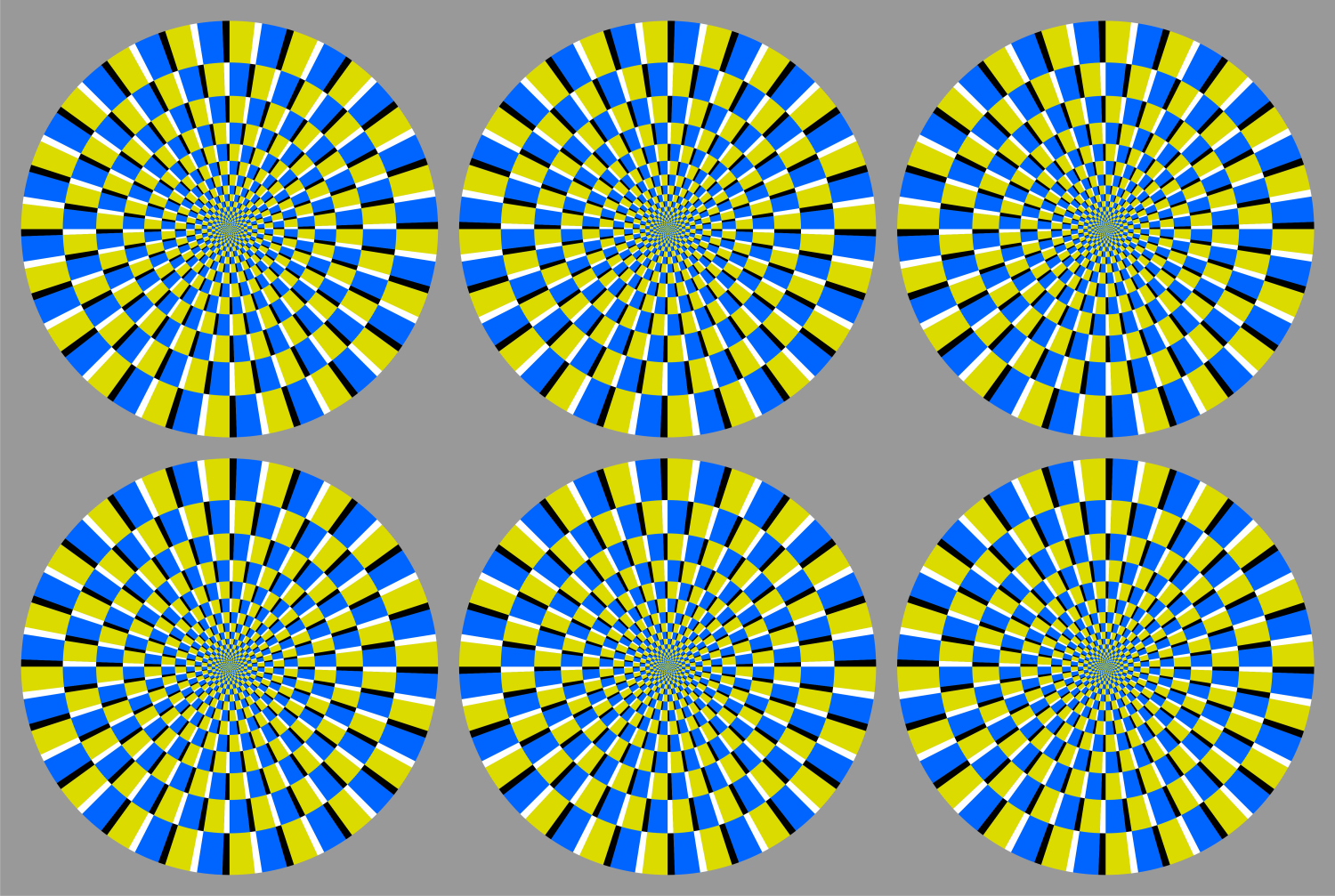
The upper-left, upper-right, and lower-middle disks appear to rotate counterclockwise
while the rest clockwise.
Type IIb
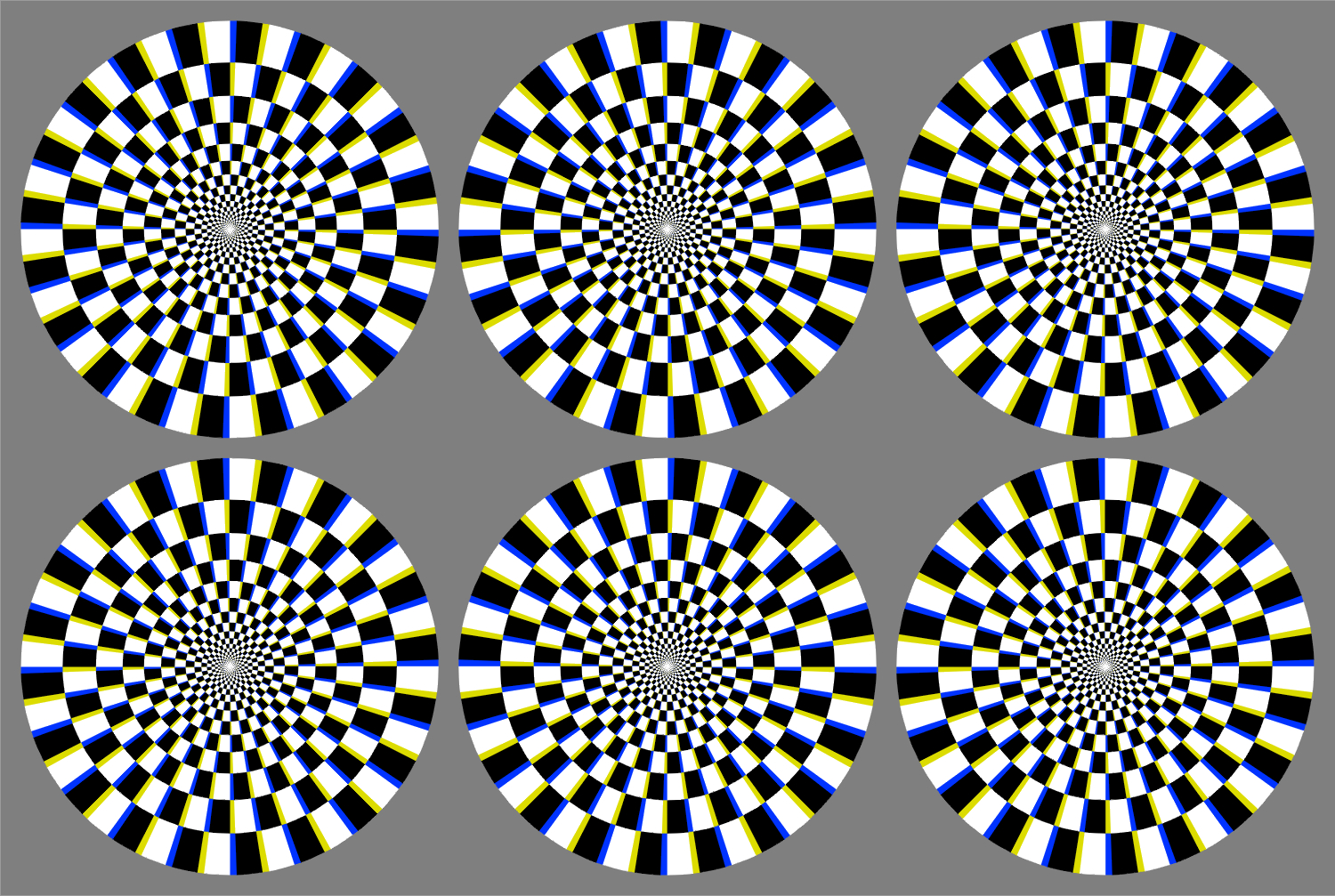
The upper-left, upper-right, and lower-middle disks appear to rotate counterclockwise while the rest clockwise.
Type IIa (six disks) 1500 x 1007 (pixel)
Type IIa (six disks) 6000 x 4031 (pixel)
Type IIb (six disks) 1500 x 1000 (pixel)
Type IIb (six disks) 6000 x 4000 (pixel)
"Rotating snakes"
(Ver. 2011)
Each disk appears to rotate.
Copyright Akiyoshi Kitaoka 2011 (January 23)
Adjusted for printing using EPSON PM-4000PX
Type III

The upper row appears to move rightward while the lower one leftward.
Type III (two rows) 1500 x 400 (pixel)
Type III (two rows) 4500 x 1200 (pixel)Type III 4500 x 1200
.jpg)
The upper-left, upper-right, and lower-middle disks appear to rotate counterclockwise
while the rest clockwise.
6. Kitaoka (2008a, b)
"Type IV" was added to the list.
References
Kitaoka, A. (2008a). Optimized Fraser-Wilcox illusions: a pictorial classification by Akiyoshi Kitaoka. Talk in Workshop No.005 "Experimental studies of anomalous motion illusions" in the 72nd Annual Convention of the Japanese Psychological Association, Hokkaido University, Sapporo, Japan, September 19, 2008. Talk
Kitaoka, A. (2008b). A new type of the optimized Fraser-Wilcox illusion in a 3D-like 2D image with highlight or shade. Journal of Three Dimensional Images (Japan), 22(4), 31-32. PDF PDF (manuscript) Presentation
Type IV
m.jpg)
The upper-left, upper-right, and lower-middle rings appear to rotate counterclockwise
while the rest clockwise.
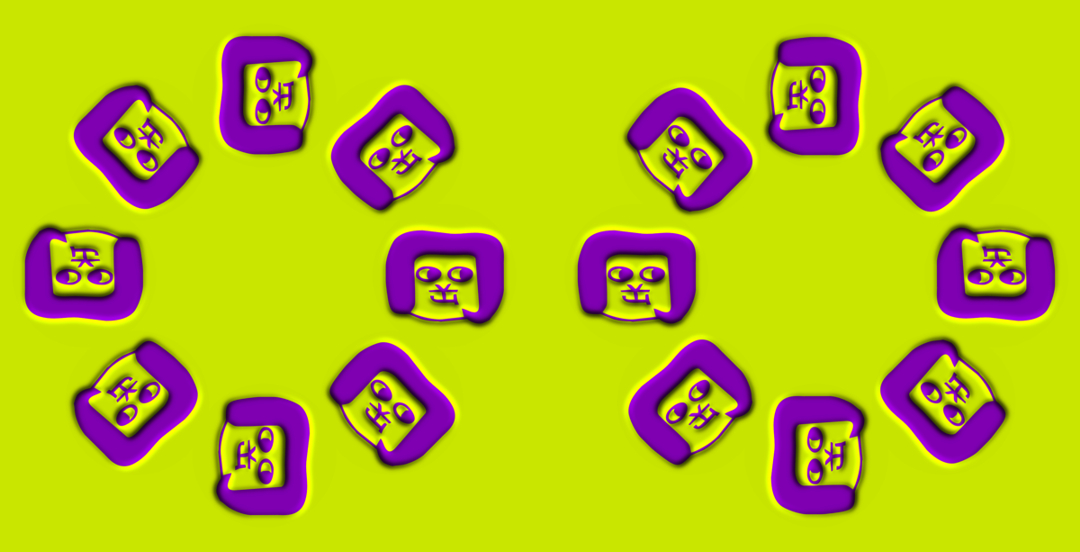
"Rotating Okazaemon"
(Seiriken Lecture 2013 version)
The right ring appears to rotate clockwise while the left one counterclockwise.
produced by Akiyoshi Kitaoka 2013 (October 24)
Okazaemon included with permission
7. Kitaoka (2008, 2010, 2012a, b)
A strongly color-dependent, "reddish" version was added to the list.
In 2008, Kitaoka found that the direction of illusory motion is “red → dark purple → purple → magenta (light red-purple) → red”, and that the illusion magnitude is strong when overall luminance contrast is low. Images of high luminance make a strong effect.
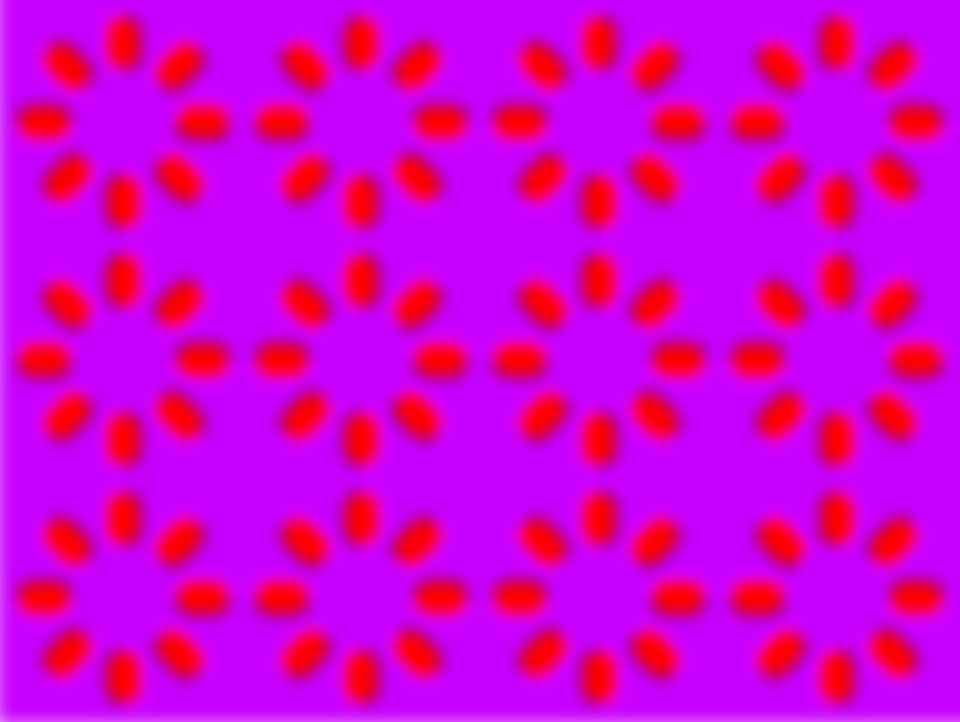
"Rotating red fruits"
Rings of fruits appear to rotate.
Copyright Akiyoshi Kitaoka 2008 (December 19)
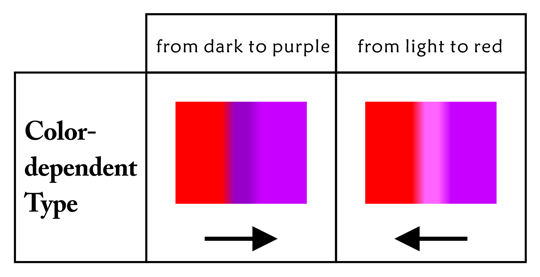
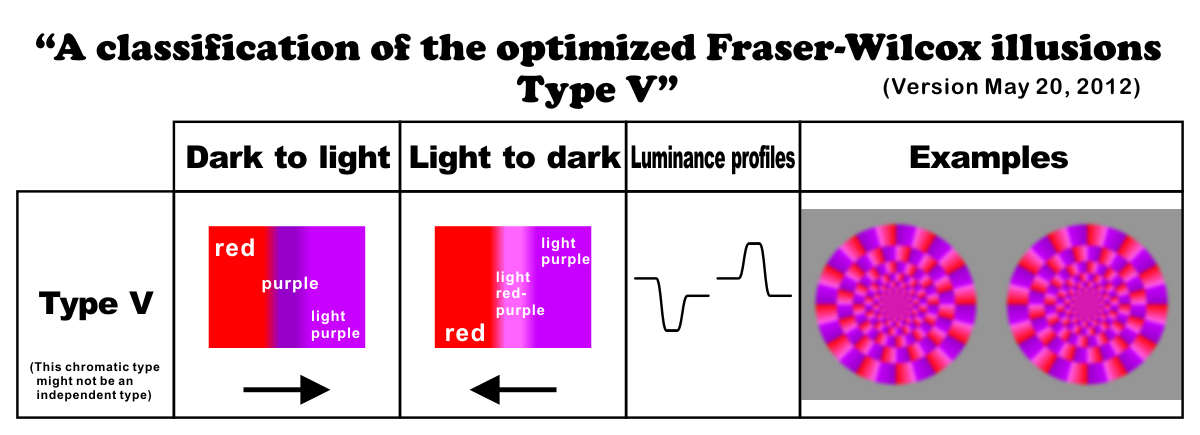
Purple » light purple » light red-purple » red » purple
References
Kitaoka, A. (2010). Introduction to visual illusion. Tokyo: Asakura-shoten (in Japanese). Book
Kitaoka, A. (2012a). Designs using the red Fraser-Wilcox illusion. Journal
of the Color Science Association of Japan, 36, Supplement, 188-189. PDF (color manuscript) Talk
Kitaoka, A. (2012b) The Fraser-Wilcox illusion and its extension. Perception 41 ECVP Abstract Supplement, page 91 (Poster September 3, 2012). Poster PDF
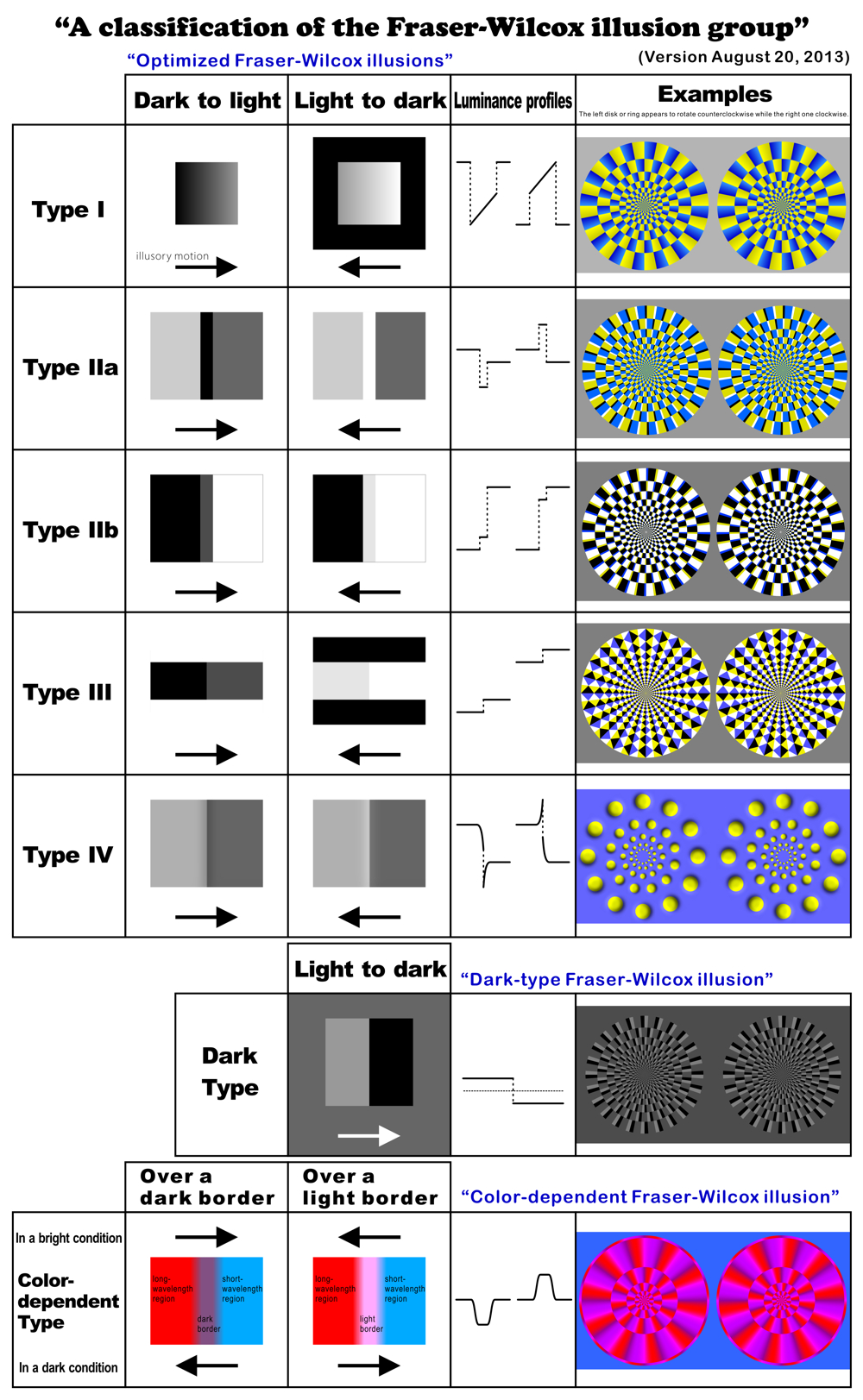
8. Kitaoka (2011)
In 2011, Kitaoka found that flickering the image increases the illusion magnitude. Blinks also work.
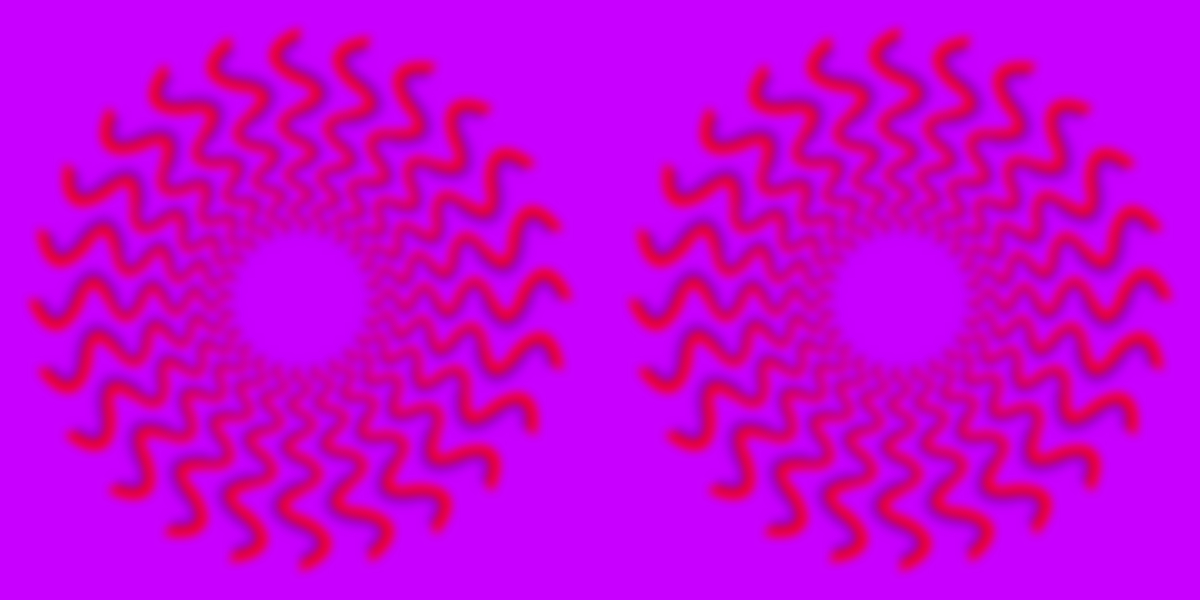
Copyright Akiyoshi Kitaoka 2012 (June 14)
Further studies on the flickering enhancement or induction (Kitaoka, 2013)
Flickering induction depends on the interaction between the stimulus and the blank.
Each disk appears to rotate clockwise during fading-in while counterclockwise during fading-out.
Copyright Akiyoshi Kitaoka 2013 (February 19)
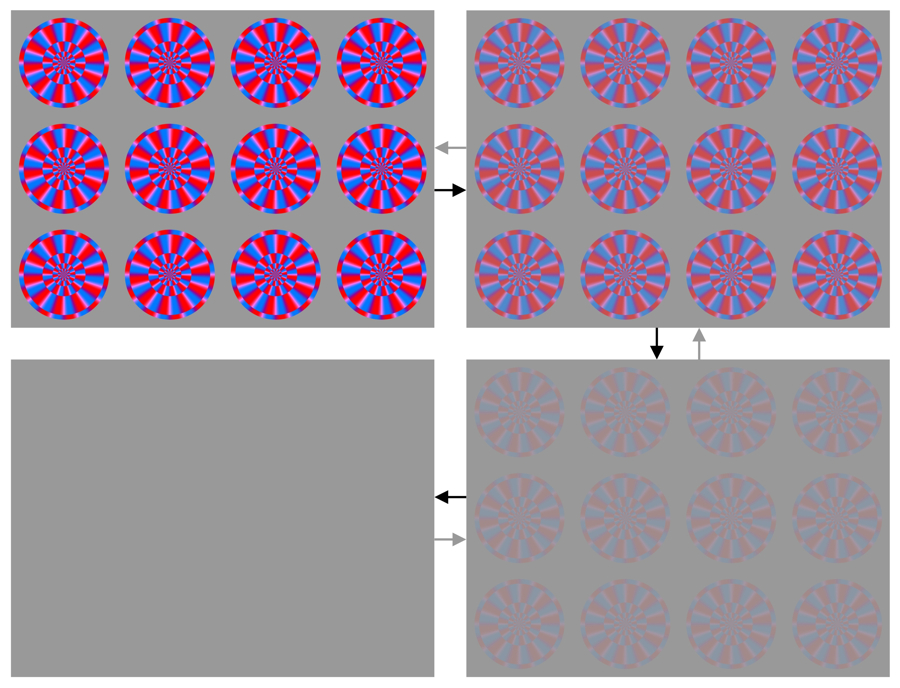
Copyright Akiyoshi Kitaoka 2013 (August 20)
Each disk appears to rotate clockwise during fading-in while counterclockwise during fading-out.
Copyright Akiyoshi Kitaoka 2013 (April 19)
Each disk appears to rotate counteclockwise during fading-in while clockwise during fading-out.
Copyright Akiyoshi Kitaoka 2013 (April 19)
Each disk appears to rotate counteclockwise during fading-in while clockwise during fading-out.
Copyright Akiyoshi Kitaoka 2013 (April 19)
Each disk appears to expand during fading-in while to contract during fading-out.
Copyright Akiyoshi Kitaoka 2013 (April 20)
"On-off rotating snakes: red and sky blue #1"
When fading in, each disk appears to rotate in the direction: black, red, white, sky blue, black. The direction is reversed when fading out.
Copyright Akiyoshi Kitaoka 2013 (April 30)
"On-off rotating snakes: red and sky blue #2"
When fading in, each disk appears to rotate in the direction: black, sky blue, white, red, black. The direction is reversed when fading out.
Copyright Akiyoshi Kitaoka 2013 (April 30)
9. Yanaka and Hirano (2011)
Yanaka and Hilano (2011) reported that this illusion is enhanced by mechanical shaking.
Each disk appears to rotate counterclockwise.
(Note that this movie is not their original)
References
Yanaka, K. and Hilano, T. (2011). Mechanical shaking system to enhance
"Optimized Fraser–Wilcox Illusion Type V". Perception, 40, ECVP
Abstract Supplement, page 171.
10. Yanaka (2012)
Yanaka (2012) reported that this illusion is enhanced by viewing images under dark illumination.
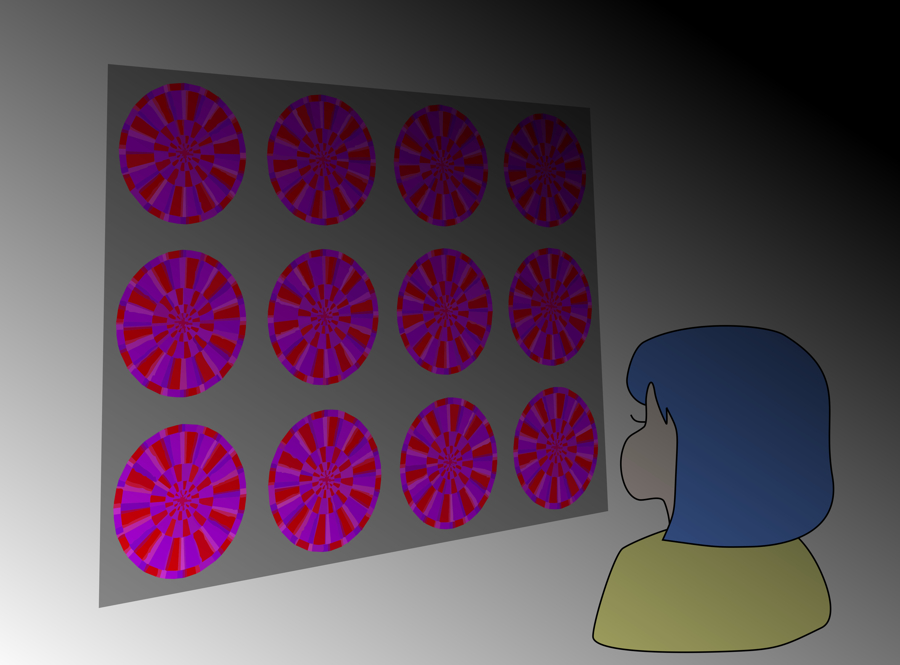
References
Yanaka, K. (2012). Enhancement of the optimized Fraser-Wilcox illusion Type V by swinging the image. Talk in the 5th Illusion Workshop, Meiji University, Tokyo, Japan, September 18, 2012.
11. Kitaoka (2013)
In 2013, Kitaoka (ECVP2013) found that Yanaka’s darkening enhancement is accompanied by a reversal of illusion: i.e., the direction under dark condition is “red → magenta (light red-purple) → purple → dark purple → red”.
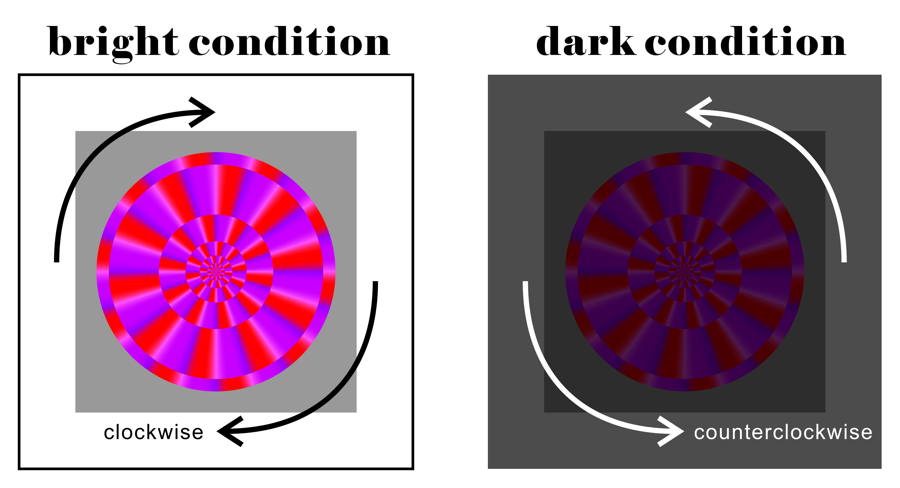
References
Kitaoka, A. (2013). Invisible color and visible color: Mystery of color the brain feels. Talk in the Shizuoka Science Museum Ru-Ku-Ru, Shizuoka, Japan, January 13, 2013. Talk
12. Kitaoka (2013)
In 2013, Kitaoka (ECVP2013) found that combination of a long wavelength color and a short one makes the illusions.
Illusory motion depending on the combination of colors


"Rotating red-and-purple disks"
Each disk appears to rotate clockwise on a bright display, while it appears to rotate counterclockwise with a printed image under dark illumination.
Copyright Akiyoshi Kitaoka 2013 (February 6)
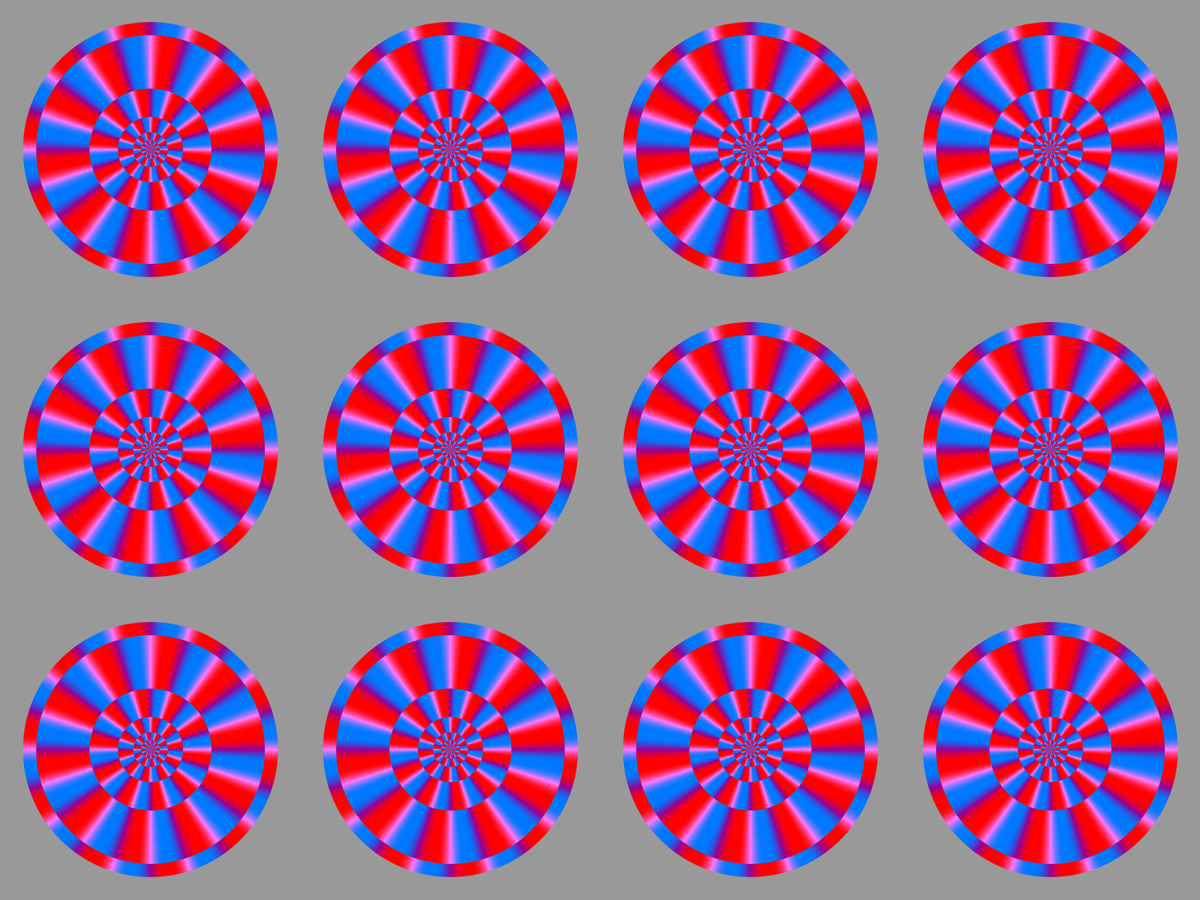
"Rotating red-and-cyan disks"
Each disk appears to rotate clockwise on a bright display, while it appears to rotate counterclockwise with a printed image under dark illumination.
Copyright Akiyoshi Kitaoka 2013 (February 1)

"Rotating red-and-cyan disks 2"
Each disk appears to rotate clockwise on a bright display, while it appears to rotate counterclockwise with a printed image under dark illumination.
Copyright Akiyoshi Kitaoka 2013 (February 6)
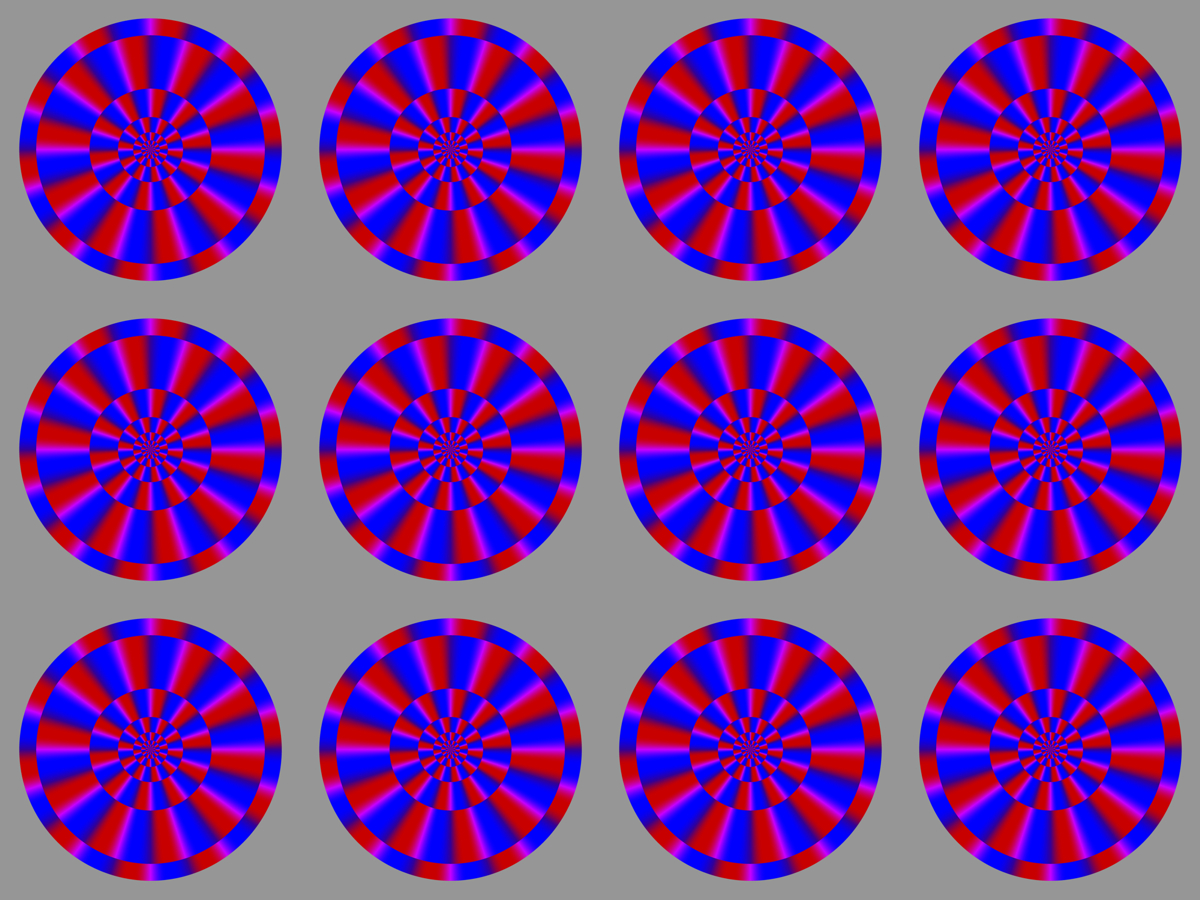
"Rotating red-and-blue disks"
Each disk appears to rotate clockwise on a bright display, while it appears to rotate counterclockwise with a printed image under dark illumination.
Copyright Akiyoshi Kitaoka 2013 (January 29)
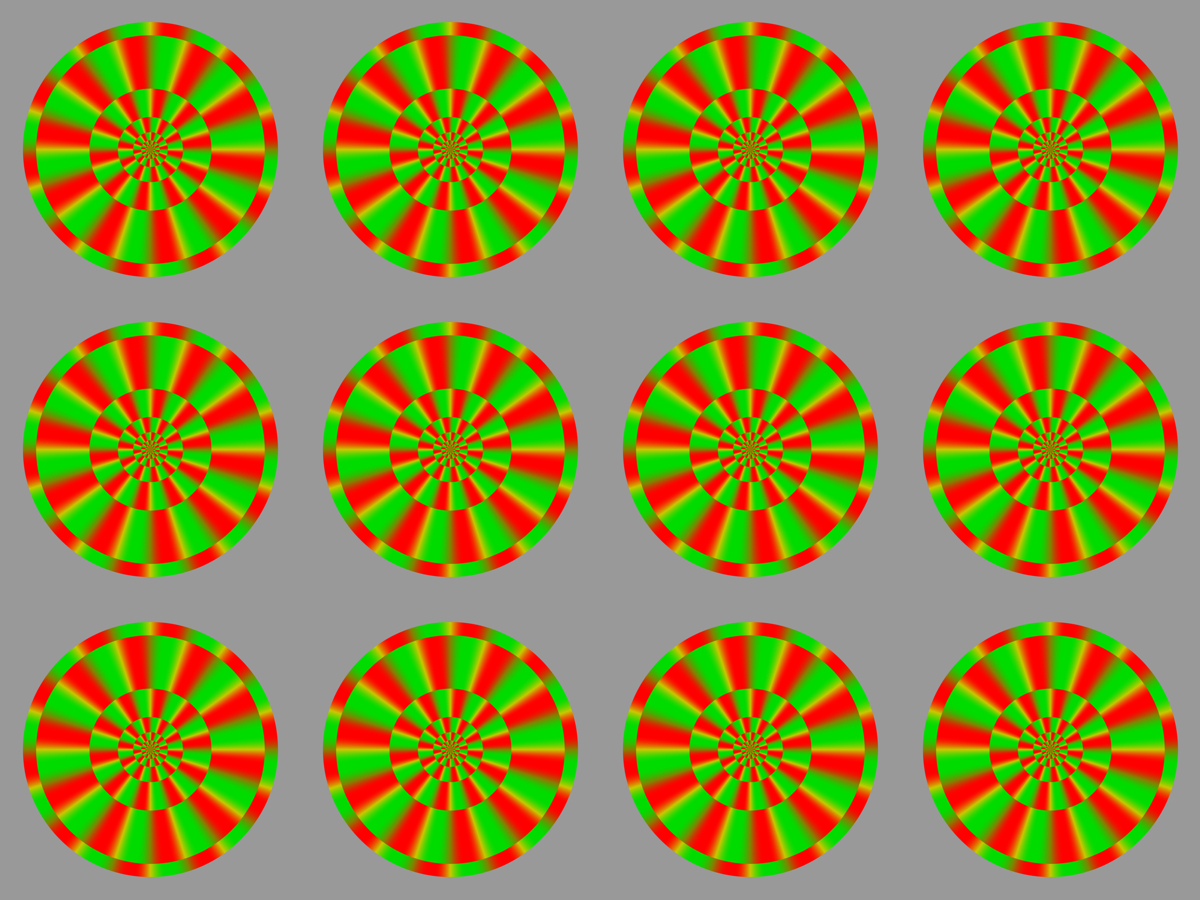
"Rotating red-and-green disks"
Each disk appears to rotate clockwise on a bright display, while it appears to rotate counterclockwise with a printed image under dark illumination.
Copyright Akiyoshi Kitaoka 2013 (January 29)
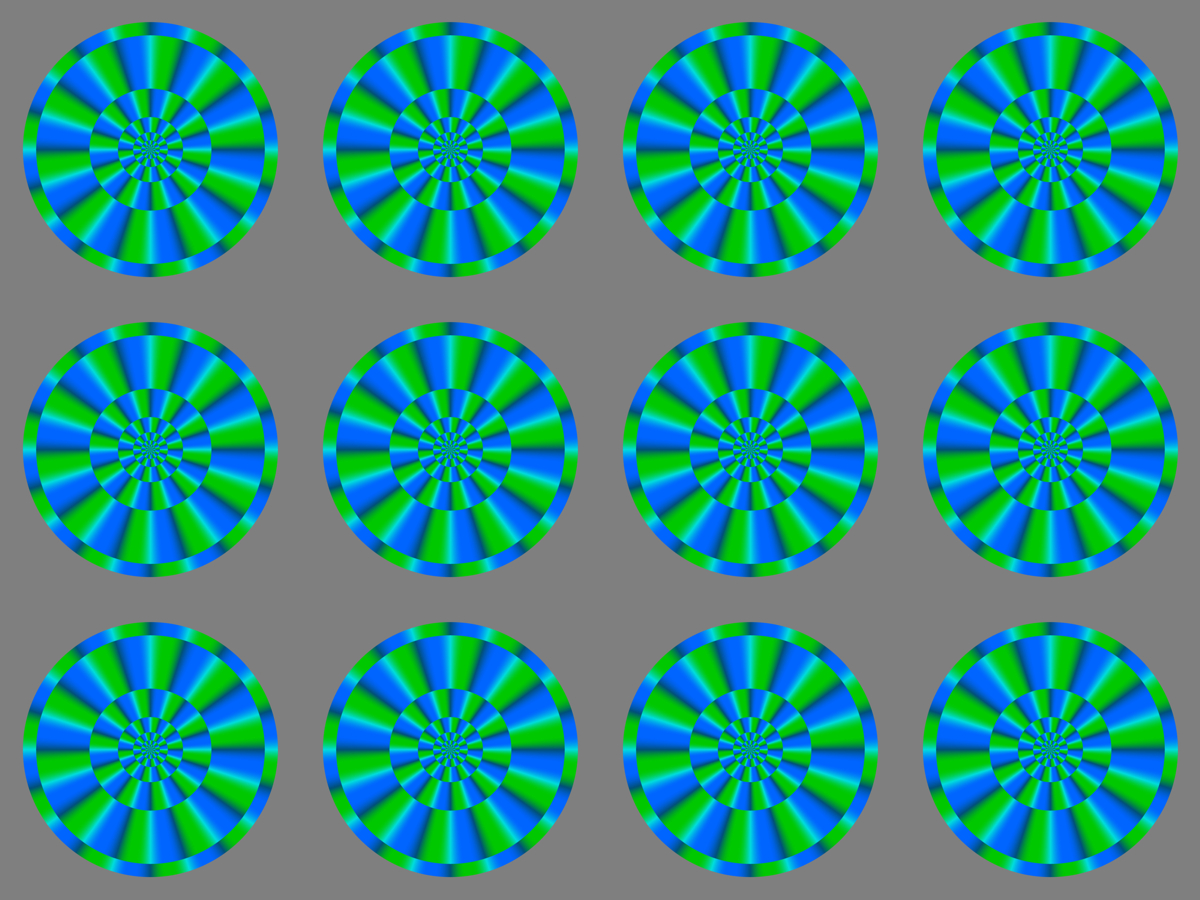
"Rotating blue-and-green disks"
Each disk appears to rotate clockwise on a bright display, while it slightly appears to rotate counterclockwise with a printed image under dark illumination.
Copyright Akiyoshi Kitaoka 2013 (February 6)
13. Kitaoka (2013)
In 2013, Kitaoka (ECVP2013) found that increasing or decreasing illumination makes the illusions.
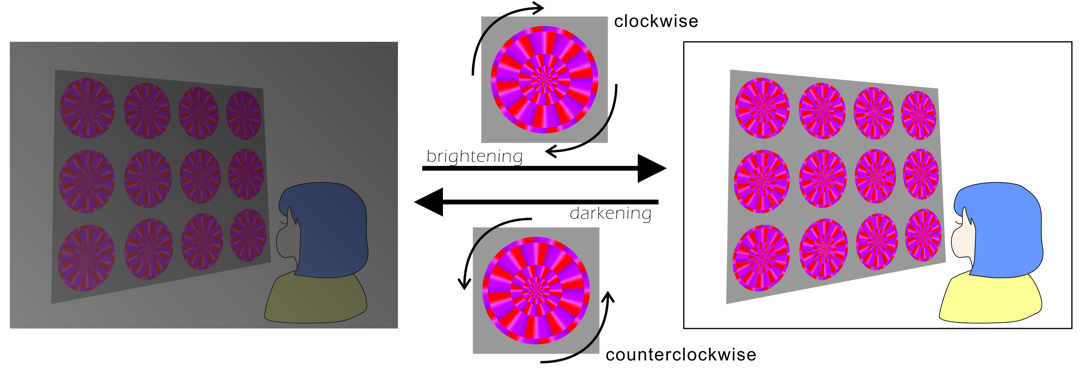
14. Kitaoka (2013)
It is suggested that this ‘luminance change-induced’ motion* might generate
the color-dependent Fraser-Wilcox illusion, being triggered by saccades,
blinks, flickering or shaking the images.
*The luminance change-induced’ motion includes the reverse phi phenomenon
(Anstis, 1970; Anstis and Rogers, 1975) and the phenomenal phenomena (Gregory
and Heard, 1983). Directions of illusory motion depending on the changes
of luminance are shown in the right (Kitaoka, 2006).
References
Anstis S M, 1970 “Phi movement as a subtraction process” Vision Research 10 1411-1430
Anstis S M, Rogers B J, 1975 “Illusory reversal of visual depth and movement
during changes of contrast” Vision Research 15 957-961
Gregory R L, Heard P F, 1983 “Visual dissociations of movement, position,
and stereo depth: some phenomenal phenomena” Quarterly Journal of Experimental
Psychology 35A 217-237
Kitaoka, A. (2006). Configurational coincidence among six phenomena: A
comment on van Lier and Csathó (2006). Perception,
35, 799-806. animations --- PDF
"Rotating gray-scale disks (movie)"
Disks appear to rotate clockwise or counterclockwise.
Copyright Akiyoshi Kitaoka 2013 (February 15)
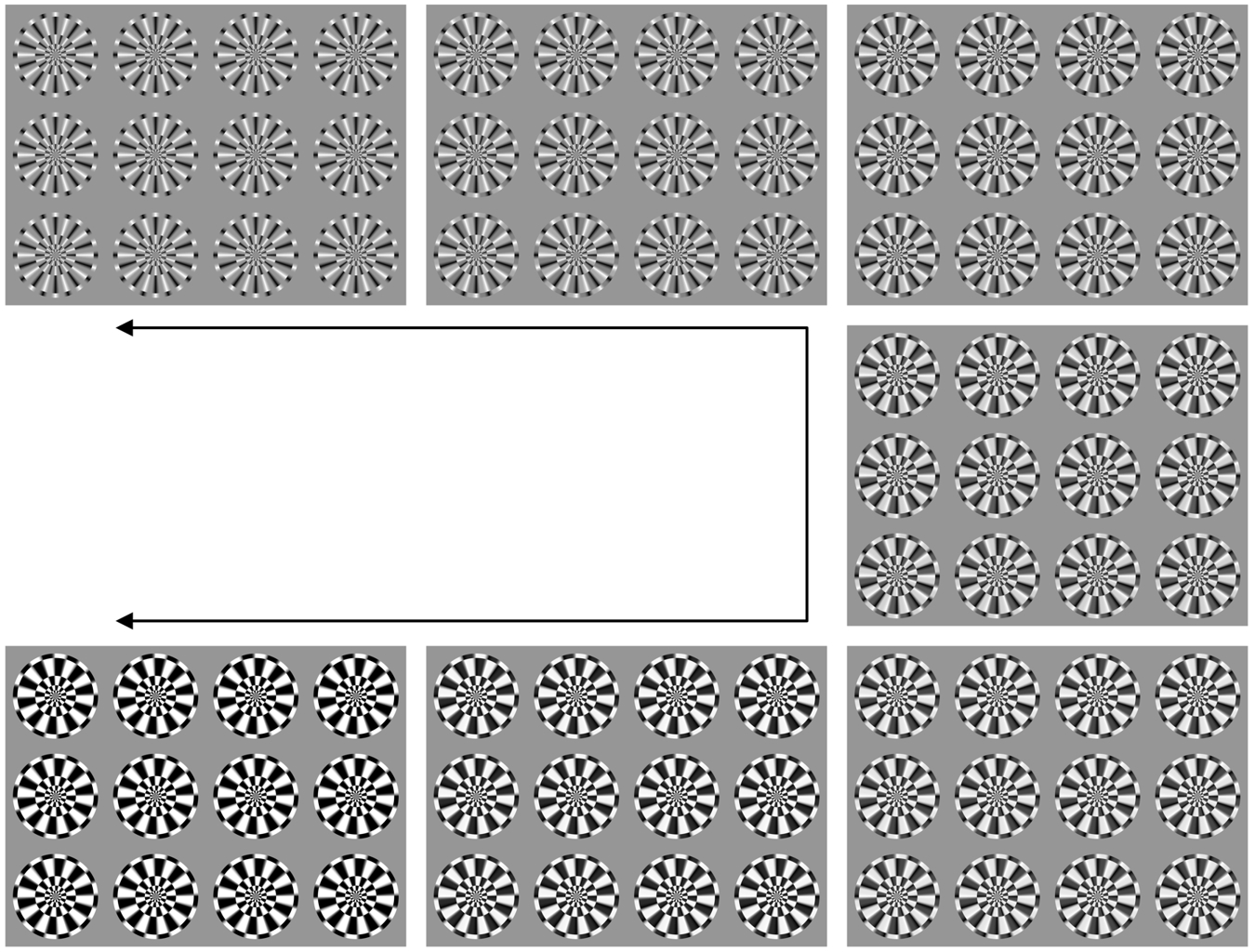
Configurational coincidence among six phenomena: A comment to van Lier
and Csathó (2006)
Kitaoka, A. (2006). Configurational coincidence among six phenomena: A comment on van Lier and Csathó (2006). Perception, 35, 799-806. animations --- PDF
Adobe Flash Player is necessary to play animations on this page.
Animation 1
Reversed phi movement (Anstis and Rogers 1975). There are four rectangles, each of which is flanked by thin lines that are dark or light. When the luminance of the rectangles decreases and that of the background increases accordingly, the upper two appear to converge in motion while the lower two appear to go apart in motion. On the other hand, when the luminance of the rectangles increases and that of the background decreases accordingly, the upper two appear to go apart in motion while the lower two appear to approach each other in motion. In sum, the direction of apparent motion is from the dark flank to the neighboring part that goes darkening or from the light flank to the neighboring part that goes brightening. Although the rectangles are aligned vertically, the apparent positional displacement occurs in the opposite direction to motion. If observers cross-fuse (uncross-fuse) the right and left rectangles, the upper rectangle appears to be in front of (behind) the lower one when they are dark.
Animation 2
The illusory motion investigated by Gregory and Heard (1983). This appearance is quite similar to Animation 1. The only configurational difference from the reversed phi movement is that the luminance of the rectangles is constant.
Animation 3
The illusory motion mentioned by Gregory and Heard (1983), in which the luminance of the rectangles dynamically changes while that of the surround is constant. This appearance is quite similar to Animations 1 and 2.
Animation 4
Phi movement (Anstis and Rogers 1975). For panel (a), dark stationary rectangles are placed on a bright stationary background. When the luminance of the right flank of each rectangle increases and that of the left flank decreases, the rectangle appears to shift leftward in motion as well as in position. Conversely, the luminance of the right flank decreases and that of the left flank increases, the rectangle appears to shift rightward in motion and position. If observers cross-fuse (uncross-fuse) the right and left rectangles, the fused rectangle appears to be in front (behind) when the right flank of the right rectangle are dark and the left flank of the left rectangle are dark. For panel (b), bright rectangles are placed on a dark background. In this case, phenomena are the reversal of panel (a).
(a) (b)
(a) Flash(swf) --- QuickTime(mov)
(b) Flash(swf) --- QuickTime(mov)
Animation 5
Consistency between the reversed phi movement and stereopsis (Anstis and Rogers 1975). In this animation, there are two phases in motion, in which the upper-left and the lower-right rectangles are one eighth phase in advance of the upper-right and the lower-left rectangles. For example, when the luminance of the rectangles increases, the upper-left rectangle appear to go leftward followed by the upper-right one, while the lower-right rectangle appear to go leftward followed by the lower-left one. In this period, the cross-fused (uncross-fused) upper rectangle appears to be in front (behind) as compared with the cross-fused (uncross-fused) lower rectangle.
Animation 6
Consistency between the apparent motion and Café-Wall-like tilt illusions (van Lier and Csathó 2005). According to dynamic changes in luminance gradient, the flanks of the rectangle appears to tilt dynamically. (a) The luminance gradient given to both flanks is dynamically changed while the dark-gray rectangle and the light-gray background are stationary. The dark part of the gradient appears to shift outward in motion and position while the bright part appears to shift inward in motion and position. This distortion agrees with the tilt illusion. (b) The luminance gradient given to the rectangle is dynamically changed while the dark flanks and the gray background are stationary. At the dark part of the gradient, the neighboring part of flanks appears to shift inward in motion and position, while at the bright part of the gradient, the neighboring part of flanks appears to shift outward in motion and position. This distortion agrees with the tilt illusion.
(a) (b)
(a) Flash(swf) --- QuickTime(mov)
(b) Flash(swf) --- QuickTime(mov)
Animation 7
Inconsistency between the apparent motion and Café-Wall-like tilt illusions. According to dynamic changes in homogenous areas, the flanks of the rectangle appears to tilt dynamically. (a) The luminance of the homogeneous rectangle is dynamically changed while the flanks with luminance gradient and the gray background are stationary. The darkening rectangle appears to attract the dark parts of the flanks inward in motion while the brightening rectangles appears to attract the light parts of the flanks inward in motion. This distortion disagrees with the tilt illusion. (b) The luminance of the homogeneous flanks is dynamically changed while the rectangle with luminance gradient and the gray background are stationary. At the dark part of the gradient, brightening flanks appears to shift inward in motion, while at the bright part of the gradient, darkening flanks appears to shift inward in motion. This distortion disagrees with the tilt illusion
(a) (b)
(a) Flash(swf) --- QuickTime(mov)
(b) Flash(swf) --- QuickTime(mov)
Animation 8
Demonstration of the apparent motion in the three elemental spatio-temporal configurations (Figure 6). The behaviors in (a), (b) and (g) are summarized in Figure 6a (off-center line-type configuration); those in (c), (d) and (h) are in Figure 6b (on-center line-type configuration); and those in (e), (f) and (i) are summarized in Figure 6c (edge-type configuration). For further explanations, see the text.
(a) (b)
(a) Flash(swf) --- Quicklime(mov)
(b) Flash(swf) --- QuickTime(mov)
(c) (d)
(c) Flash(swf) --- QuickTime(mov)
(d) Flash(swf) --- QuickTime(mov)
(e) (f)
(e) Flash(swf) --- QuickTime(mov)
(f) Flash(swf) --- QuickTime(mov)
(g) (h) (i)
(g) Flash(swf) --- QuickTime(mov)
(h) Flash(swf) --- QuickTime(mov)
(i) Flash(swf) --- QuickTime(mov)
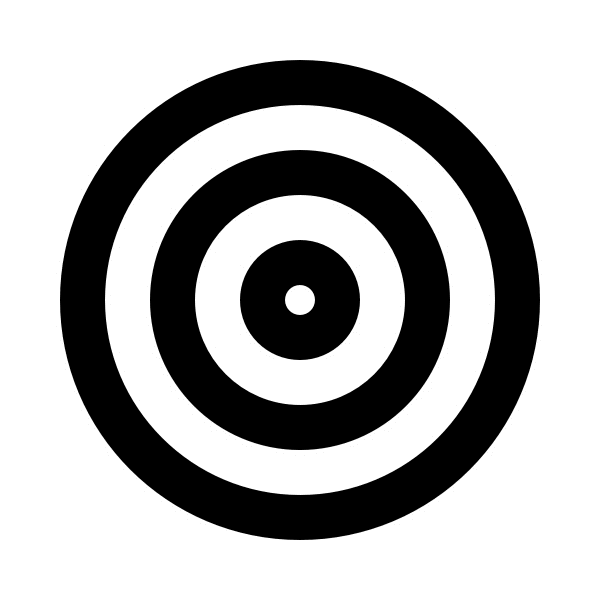
Copyright Akiyoshi Kitaoka 2010 (April 3)
Nice demos
Arthur Shapiro's Illusions and Demonstration
Directions of illusory motion depending on changes of luminance in each
area
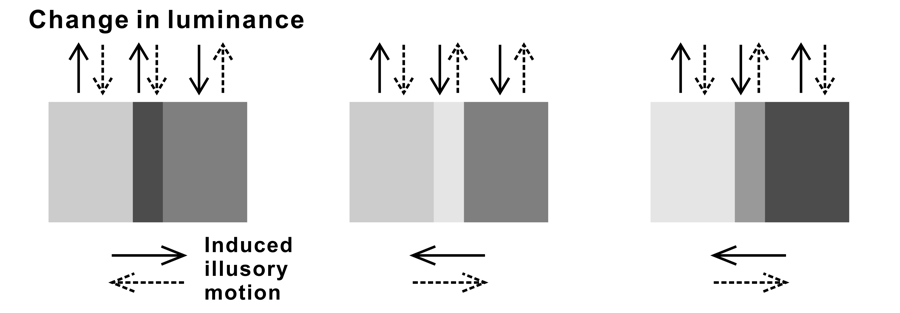

Involvement of the Purkinje shift is suggested. Short wavelength color
appears to be relatively bright under a dark condition. Decreasing illumination
makes short wavelength color relatively bright. This might induce the luminance
change-dependent motion illusion and show the color-dependent Fraser-Wilcox
illusion.
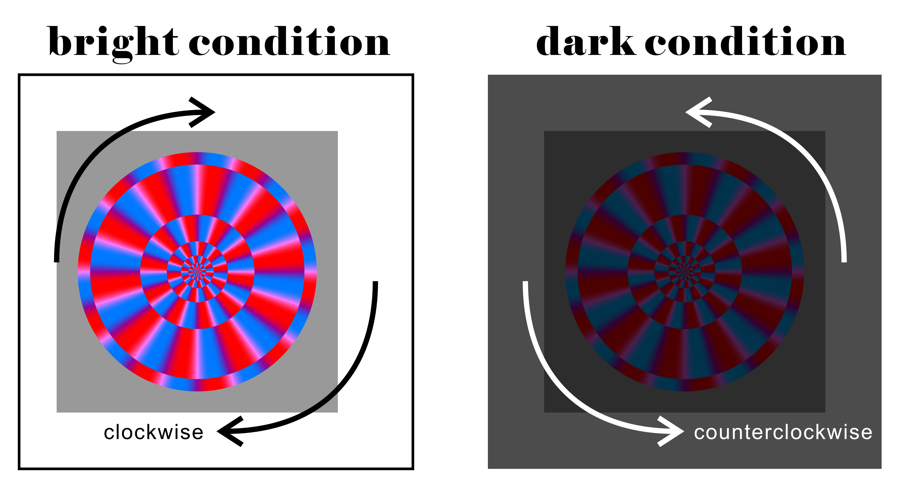
References
Kanazawa, S., Kitaoka, A., and Yamaguchi, M. K. (2013). Infants see illusory motion in static figures. Perception, 42, 828-834.
Ashida, H., Kuriki, I., Murakami, I., Hisakata, R. and Kitaoka, A. (2012). Direction-specific fMRI adaptation reveals the visual cortical network underlying the "Rotating Snakes" illusion. NeuroImage, 61, 1143–1152.
Otero-Millan, J.,Macknik, S. L., and Martinez-Conde, S. (2012). Microsaccades and Blinks Trigger Illusory Rotation in the “Rotating Snakes” Illusion. Journal of Neuroscience, 32, 6043-6051.
Stevanov, J., Marković, S., and Kitaoka, A. (2012). Aesthetic valence of visual illusions. i-Perception, 3(2), 112–140.
Tomimatsu E., Ito, H., Sunaga, S., & Remijn, G. B. (2011). Halt and recovery of illusory motion perception from peripherally viewed static images. Attention, Perception, & Psychophysics, 73, 1823-1832.
Tomimatsu, E., Ito, H., Seno, T., and Sunaga, S. (2010). The ‘rotating snakes’ in smooth motion do not appear to rotate. Perception, 39, 721-724.
Fermüller, C., Ji, H., and Kitaoka, A. (2010). Illusory motion due to causal time filtering. Vision Research, 50, 315–329.
Billino, J., Hamburger, K., & Gegenfurtner, K. R. (2009). Age effects on the perception of motion illusions. Perception, 38, 508-521.
Kuriki, I., Ashida, H., Murakami, I., and Kitaoka, A. (2008). Functional brain imaging of the Rotating Snakes illusion by fMRI. Journal of Vision, 8(10):16, 1-10.
Hisakata, R. and Murakami, I. (2008) The effects of eccentricity and retinal illuminance on the illusory motion seen in a stationary luminance gradient. Vision Research, 49, 1940-1948.
Beer, A. L., Heckel, A. H. and Greenlee, M. W. (2008) A motion illusion reveals mechanisms of perceptual stabilization. PLoS ONE, 3(7): e2741, 1-7. doi:10.1371/journal.pone.0002741
Chi, M-T., Lee, T-Y., Qu, Y., and Wong, T-T. (2008) Self-Animating Images: Illusory Motion Using Repeated Asymmetric Patterns. ACM Transaction on Graphics (Proceedings of SIGGRAPH 2008), 27, No.3.
Murakami, I., Kitaoka, A. and Ashida, H. (2006) A positive correlation between fixation instability and the strength of illusory motion in a static display. Vision Research, 46, 2421-2431.
Conway, R. B., Kitaoka, A., Yazdanbakhsh, A., Pack, C. C., and Livingstone, M. S. (2005) Neural basis for a powerful static motion illusion. Journal of Neuroscience, 25, 5651-5656.
Backus, B. T. and Oruç, I. (2005) Illusory motion from change over time in the response to contrast and luminance. Journal of Vision, 5, 1055-1069.
Kitaoka, A. and Ashida, H. (2003) Phenomenal characteristics of the peripheral drift illusion. VISION (Journal of the Vision Society of Japan), 15, 261-262. PDF
Naor-Raz, G. and Sekuler, R. (2000) Perceptual dimorphism in visual motion from stationary patterns. Perception, 29, 325-335.
Faubert, J. and Herbert, A. M. (1999) The peripheral drift illusion: A motion illusion in the visual periphery. Perception, 28, 617-621.
Fraser, A. and Wilcox, K. J. (1979) Perception of illusory movement. Nature, 281, 565-566.
Parreira Katy, Italy, has uploaded a movie on YouTube on October 10, 2013, which shows that her cat Molly (seven years old) appears to see the "Rotating snakes" illusion. I think this is the second piece of evidence that cats see motion illusion in a static image.
https://www.youtube.com/watch?v=1KrboUI1hg8
References
<Illusion news 16, article on February 28>
Rasmus Bååth, Lund University Cognitive Science, Sweden, shows evidence
that the cat sees the Rotating snakes illusion!
http://youtu.be/CcXXQ6GCUb8
<October 14, 2013>
Q: Is the illusory motion directed from high-contrast regions to low-contrast ones?
A: No.
Kitaoka, A. and Ashida, H. (2004). A new anomalous motion illusion: the
"central drift illusion". The 2004's winter meeting of the Vision Society of Japan at the Kogakuin
University, Shinjuku, Tokyo, Japan, 2004/1/26-28, 1/26 oral publication. Presentation
Central drift illusion
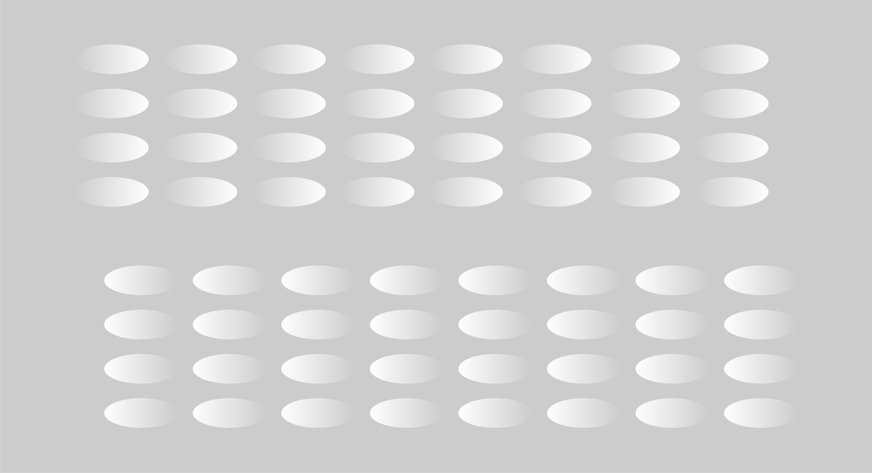
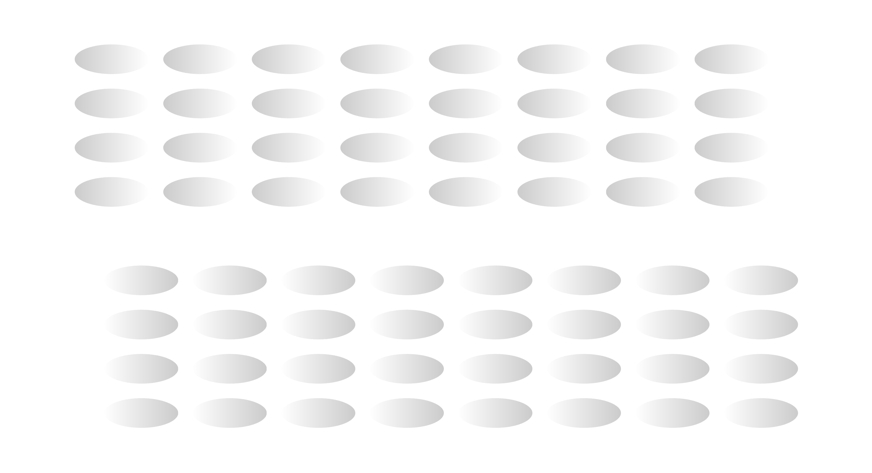
Expansion illusion of visual phantoms due to the central drift illusion
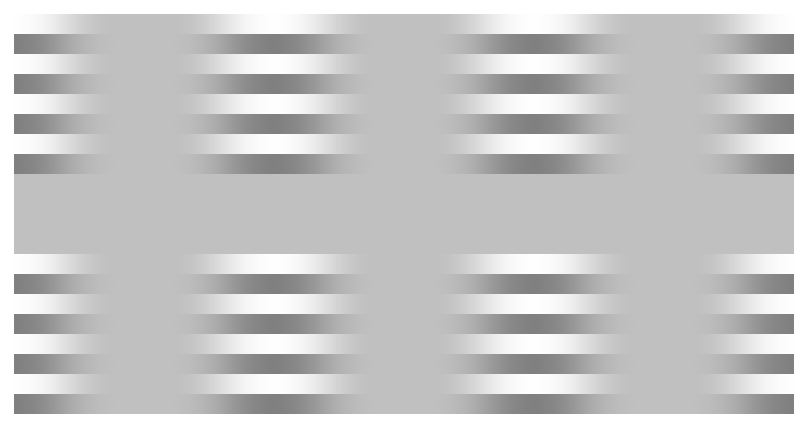
Examples of the central drift illusion
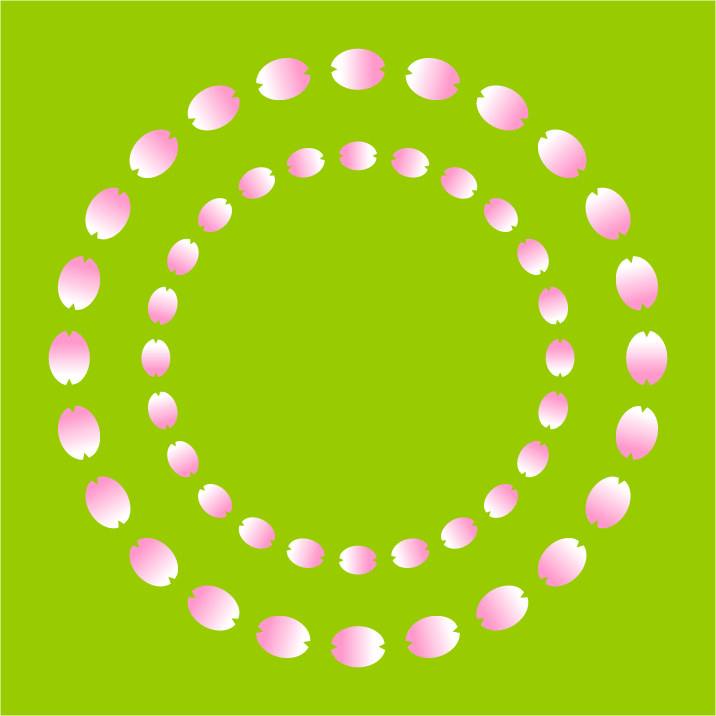
"Rotating sakura"
Rings made up of petals of cherry blossoms appear to rotate. The outer ring rotates counterclockwise while the inner one rotates clockwise.
Copyright Akiyoshi Kitaoka 2005 (January 26)
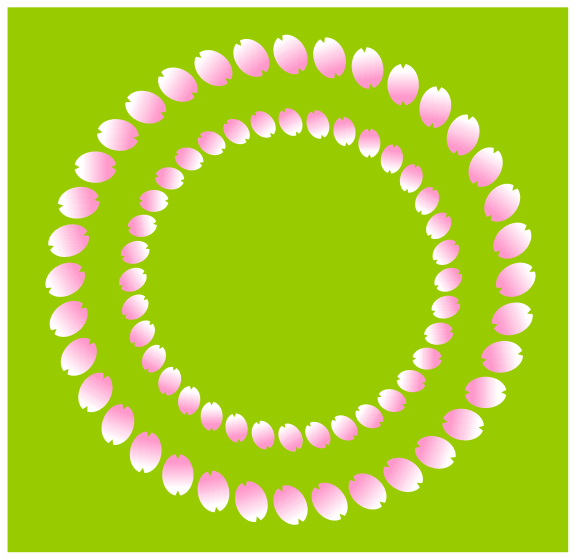
The inner ring appears to contract while the outer one appears to expand.
Copyright Aiyoshi Kitaoka 2005 (March 18)
"A fall"
Water appears to fall.
Copyright Aliyoshi Kitaoka 2005 (April 13)

Each piece of green 'mist' appears to expand.
Copyright Aliyoshi Kitaoka 2005 (August 15)
Drifting arrows illusion
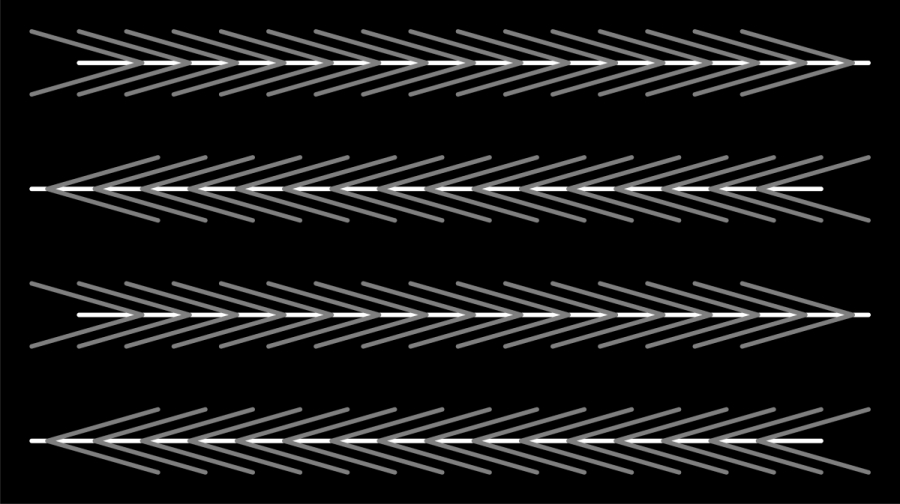
"Drifting arrows illusion 1"
The first and third rows appear to move rightward, while the rest appear to move leftward.
Copyright Akiyoshi Kitaoka 2009 (February 24)
Kitaoka, A. (2007) A new motion illusion in a stationary image characterized by line drawing. Talk presentaton in the 2007's winter meeting of the Vision Society of Japan at the Tokyo Institute of Technology, Meguro, Tokyo, February 1, 2007. Presentation (html in Japanese)
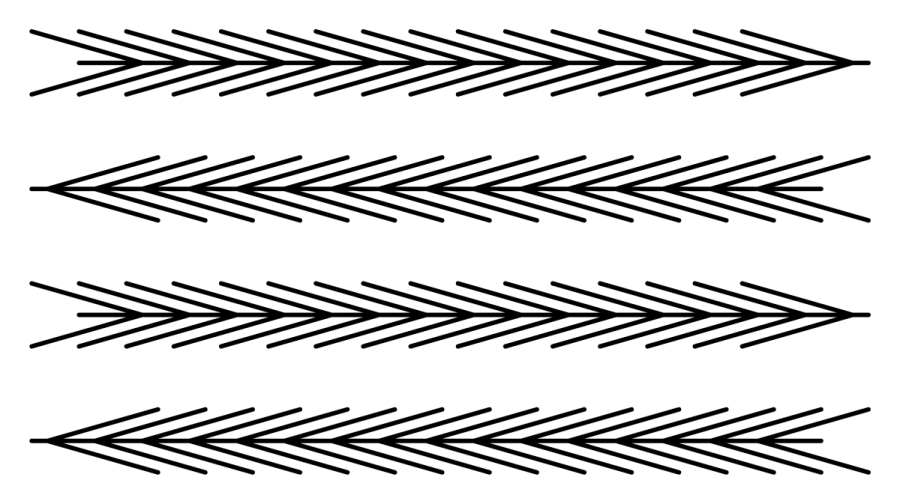
"Drifting arrows illusion 2"
The first and third rows appear to move leftward, while the rest appear to move rightward.
Copyright Akiyoshi Kitaoka 2009 (February 24)
Drifting fence illusion
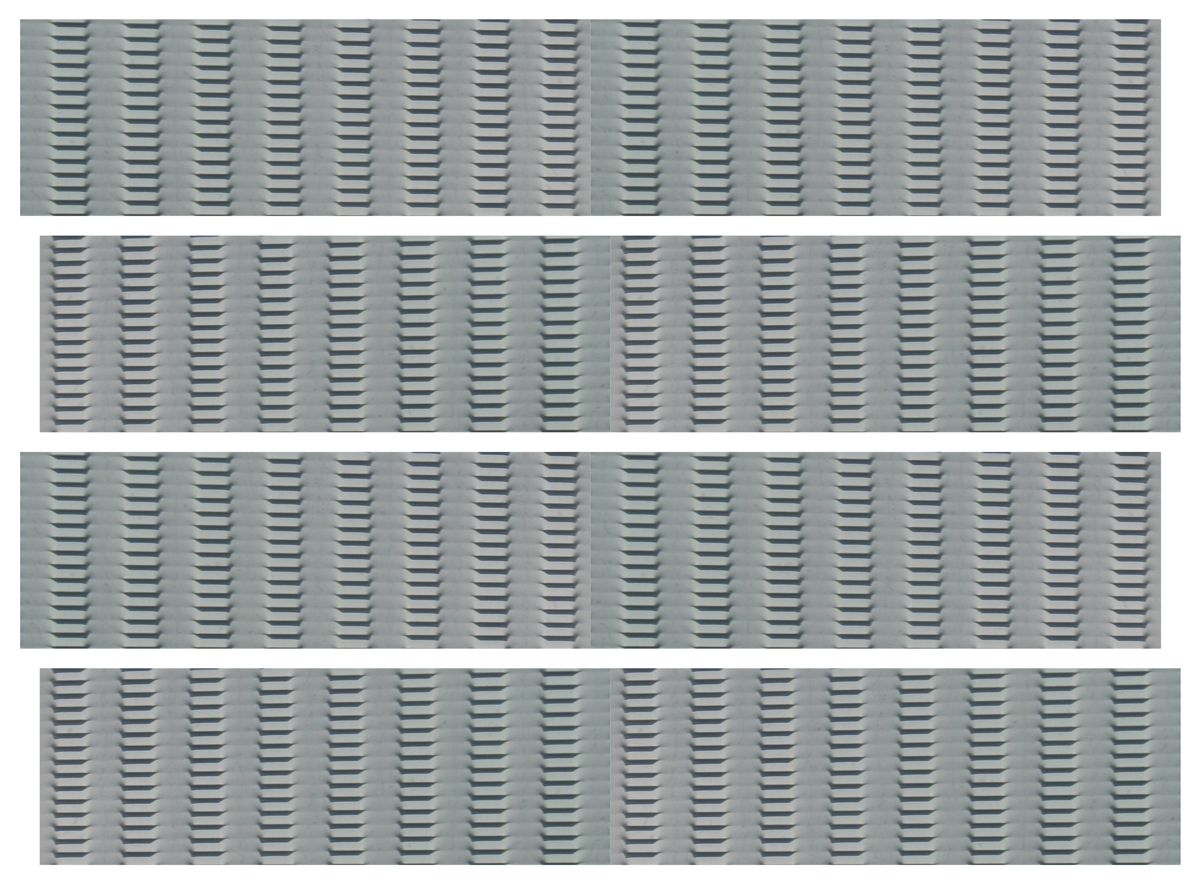
"Moving fences"
The uppermost and third images appear to move rightward while the rest appear to move leftward.
Copyright Akiyoshi Kitaoka 2013 (May 27)
This illusion was found when I saw a fence of the Japan Railway Enmachi station in Kyoto.
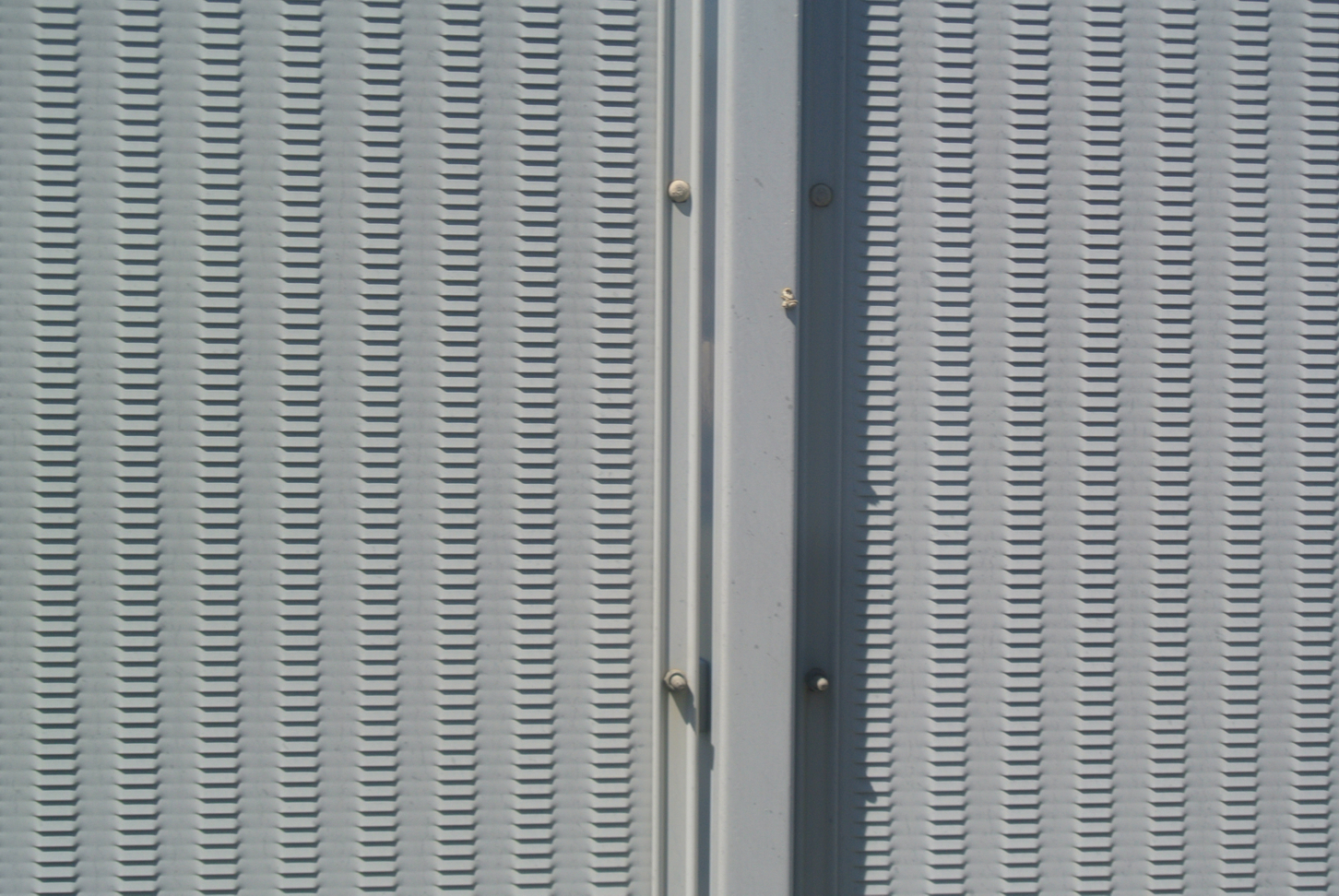

Drifting triangles illusion
Yanaka, K., Hilano, T., and Kitaoka, A. (2013). Drifting triangles illusion and its enhancement by shaking or blinking. Perception 42 (36th) ECVP (Bremen) Abstract Supplement, page 96 (Poster August 27, 2013).
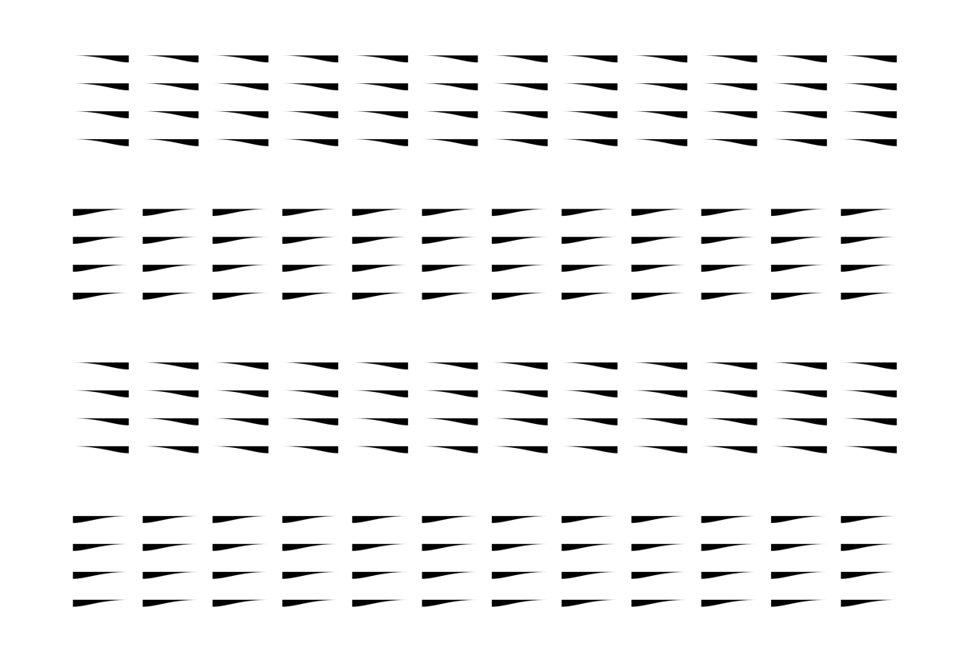
"Moving schools of fish #2"
The uppermost and third images appear to move rightward while the rest appear to move leftward.
Copyright Akiyoshi Kitaoka 2013 (June 2)
Advancing convexities illusion
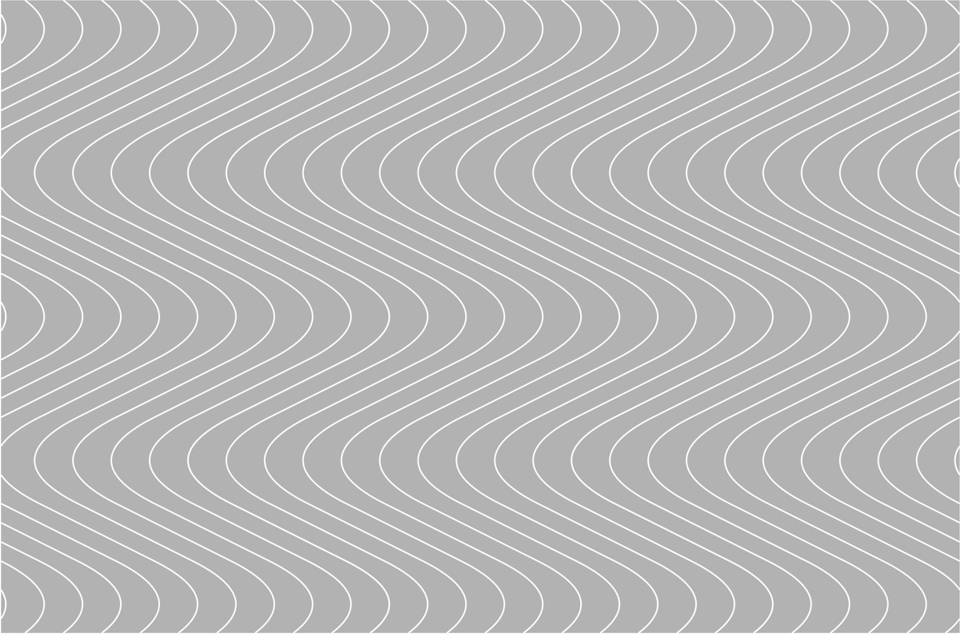
"Wave pattern drift illusion"
Heads of waves appear to move forward.
Copyright Akiyoshi Kitaoka 2011 (June 6)
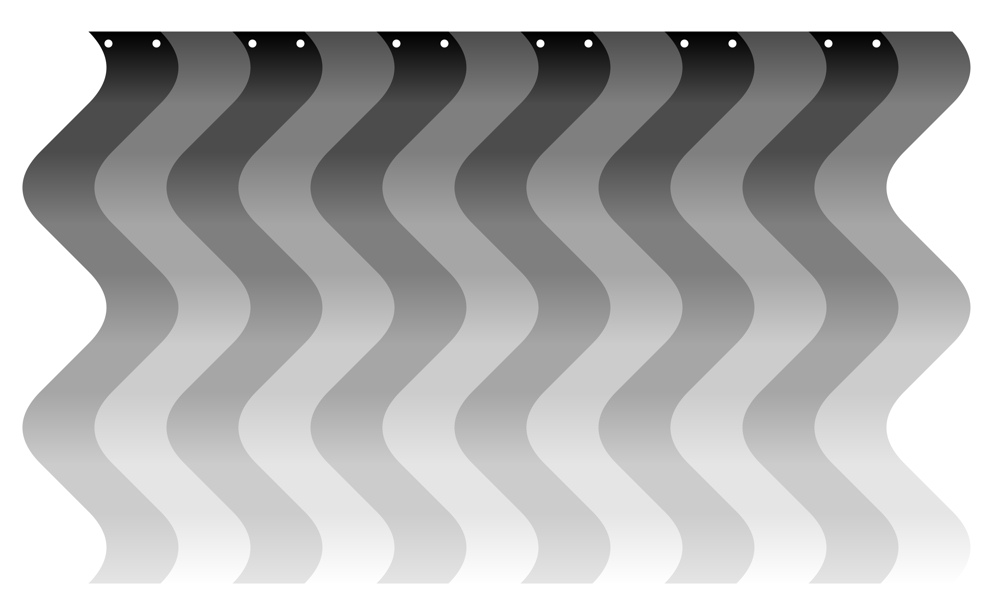
"Eels"
Eels appear to wave horizontally.
Copyright Akiyoshi Kitaoka 2011 (June 4)
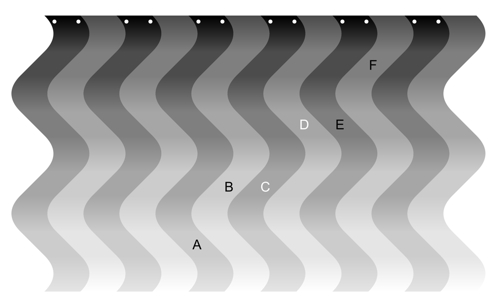
A = B, C = D, and E = F in luminance. This type of display was presented by Todorovic (2006, Figure 4a).
Todorovic, D. (2006). Lightness, illumination, and gradients. Spatial Vision, 19, 219-261.
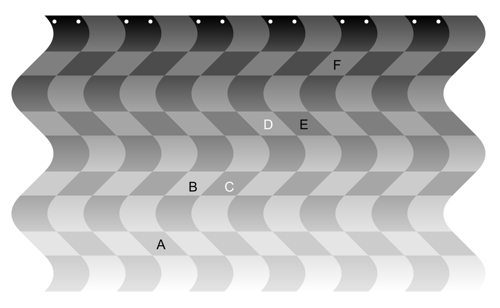
"Scrambled eels"
Copyright Akiyoshi Kitaoka 2011 (June 4)
A = B, C = D, and E = F in luminance. This type of display was presented by Todorovic (2006, Figure 4b).
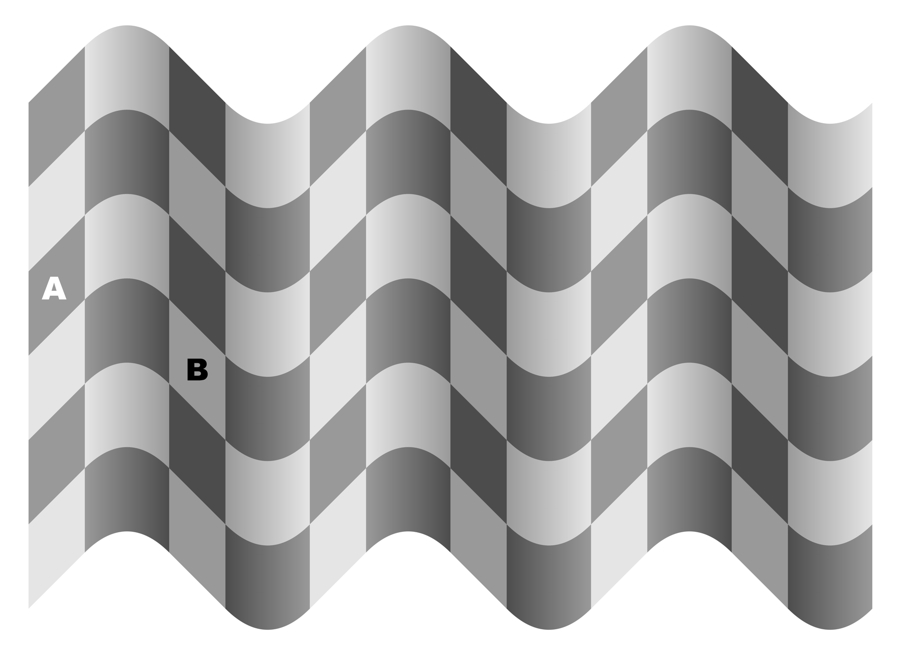
A variation of Todorovic's image (2006, Figure 4b).
Copyright Akiyoshi Kitaoka 2011 (June 5)
Visual delay-dependent motion illusion
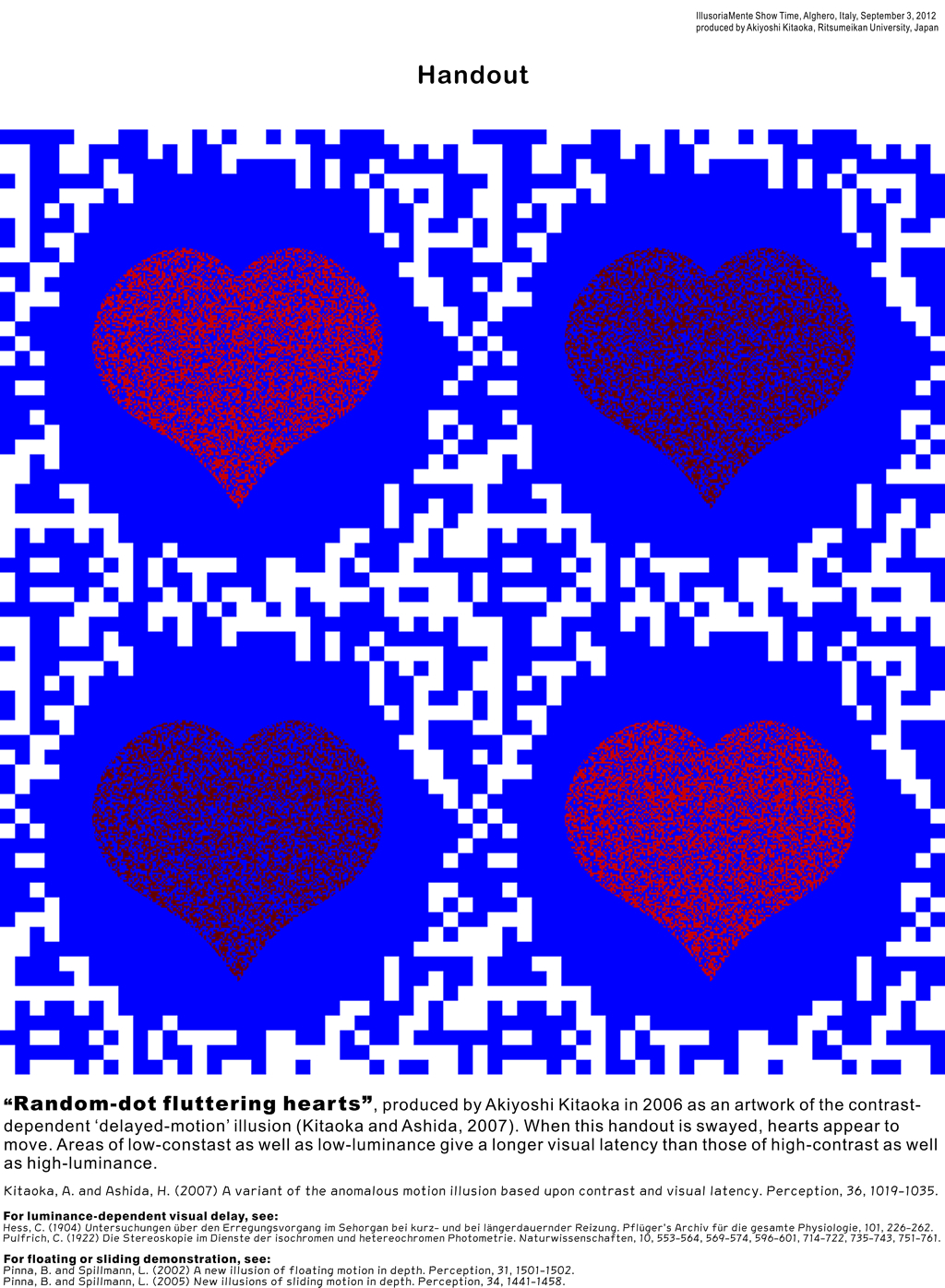
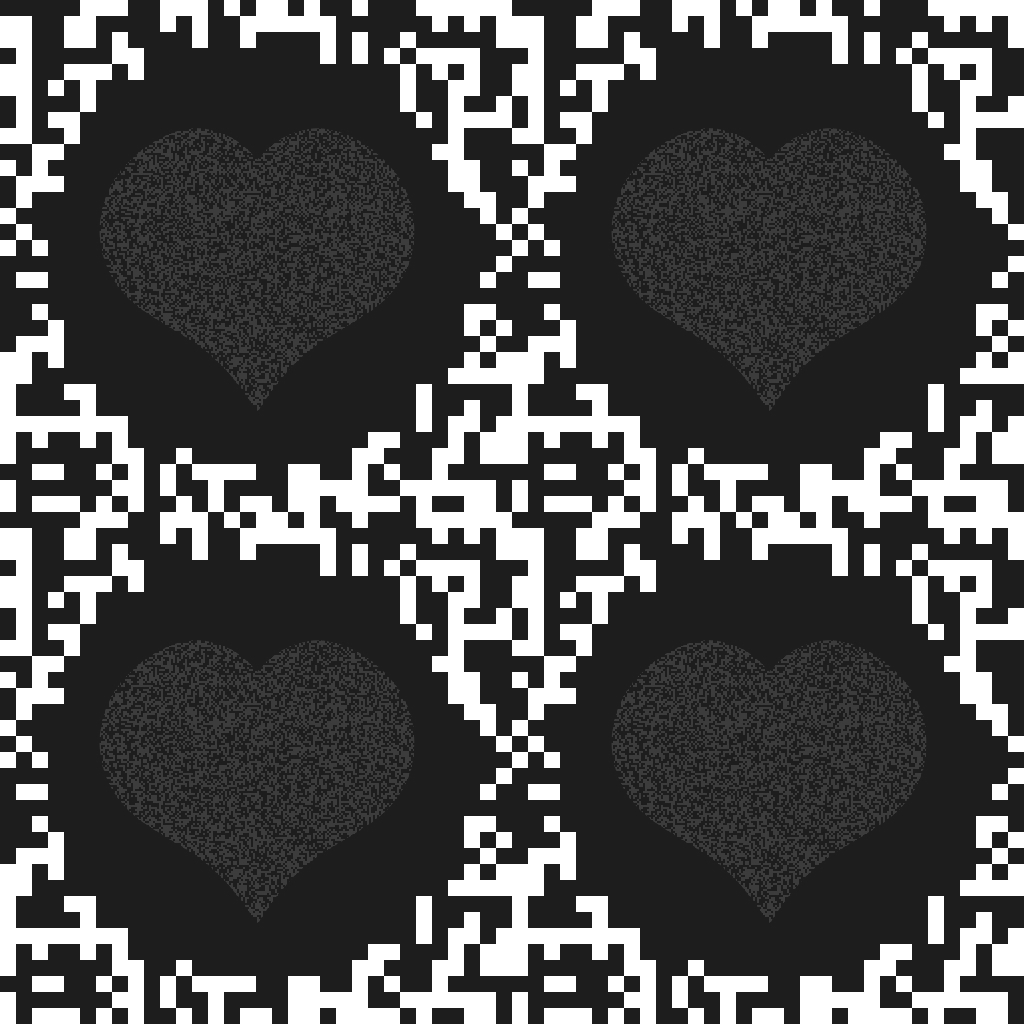
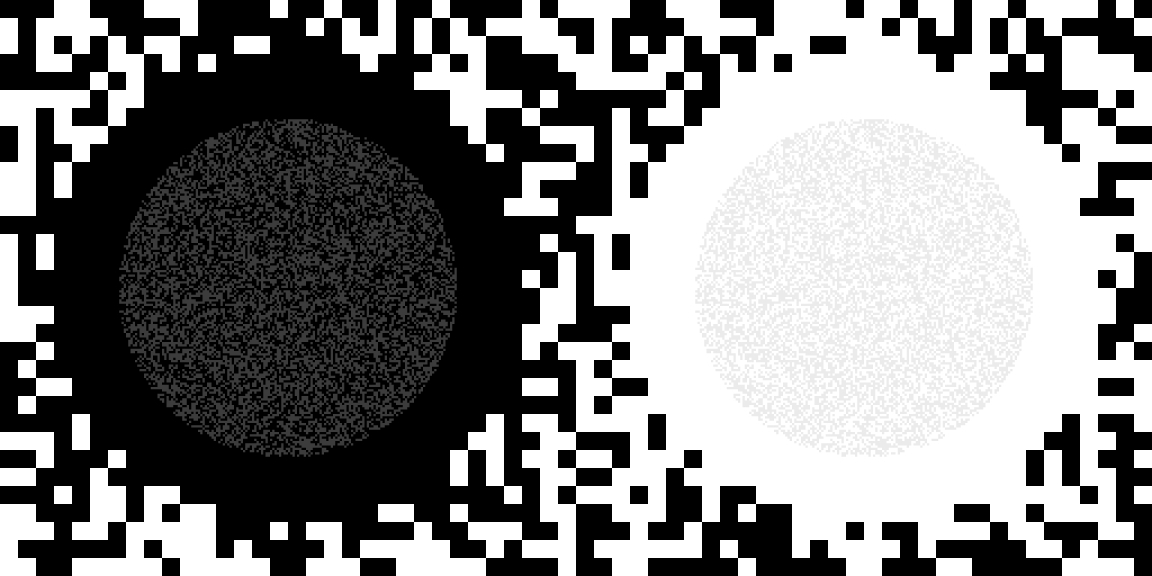
1. High-luminance parts show shorter latency than low-luminance part.
2. High-contrast parts show shorter latency than low-contrast part. <our finding!>
Kitaoka, A. and Ashida, H. (2007) A variant of the anomalous motion illusion based upon contrast and visual latency. Perception, 36, 1019-1035. PDF
中山(2008)によると、踊るハートは赤が重要。青不要。ピンクはダメ。
中山明子 (2008) 「踊るハート」錯視(1844)と「踊るハート達」錯視(2006)の比較検証 2008年度立命館大学文学部(人文学科心理学専攻)卒業論文
cf. fluttering-heart illusion

(Helmholtz, 1867; Nguyen-Tri and Faubert 2003; von Grünau 1975a, 1975b, 1976; von Kries 1896)
References
Helmholtz, H. von (1856, 1860, 1866,
1867) Handbuch der Physiologischen Optik. Leipzig: Voss. Part I (1856),
Part II (1860), Part III (1866). The first two parts were published in
the same volume as the third part in 1866. This was called the first
edition according to Robinson (1972). In many case, “1867” is preferred
for citation as follows. Helmholtz, H. von. (1867). Handbuch der
physiologischen Optik. Leipzig: Voss. Translated by J P C Southall of
the third German edition (1909-1911) was published as Treatise on
Physiological Optics, New York: Dover (1924-1925, 1962). Edited by N.
Wade, Helmholtz's Treatise on Physiological Optics, Bristol: Thoemmes
(2000). The following information was taken from Wade (2004).
Helmholtz H, 1867 "Handbuch der physiologischen Optik", in Allgemeine
Encyklopädie der Physik volume 9, Ed. G Karsten (Leipzig: Voss)
Helmholtz H, 1896 Handbuch der physiologischen Optik 2nd edition (Hamburg: Voss)
Helmholtz H, 1909 Handbuch der physiologischen Optik volume 1, 3rd
edition, Eds A Gullstrand, J von Kries, W Nagel (Hamburg: Voss)
Helmholtz H, 1910 Handbuch der physiologischen Optik volume 3, 3rd
edition, Eds A Gullstrand, J von Kries, W Nagel (Hamburg: Voss)
Helmholtz H, 1911 Handbuch der physiologischen Optik volume 2, 3rd
edition, Eds A Gullstrand, J von Kries, W Nagel (Hamburg: Voss)
Helmholtz H, 1924 Helmholtz's Treatise on Physiological Optics volume 1,
translated by J P C Southall (New York: Optical Society of America)
Helmholtz H, 1925 Helmholtz's Treatise on Physiological Optics volume 2,
translated by J P C Southall (New York: Optical Society of America)
Helmholtz H, 1925 Helmholtz's Treatise on Physiological Optics volume 3,
translated by J P C Southall (New York: Optical Society of America)
Helmholtz H, 2000 Helmholtz's Treatise on Physiological Optics (3 volumes) translated by J P C Southall (Bristol: Thoemmes)
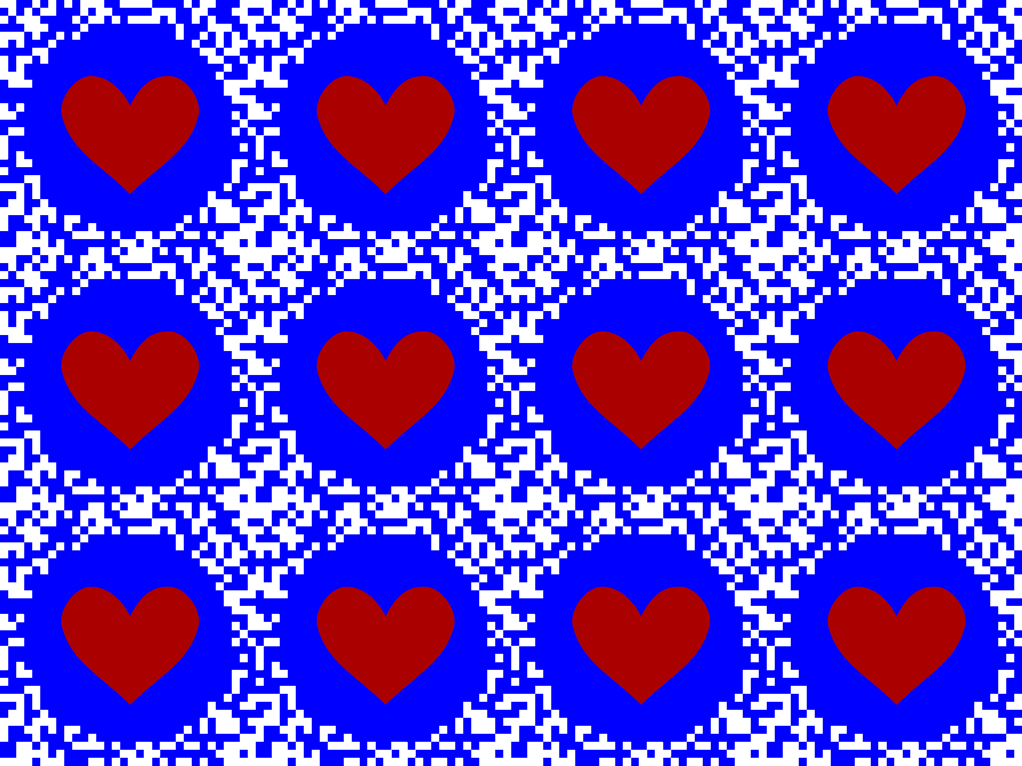
"Fluttering red hearts in front of the blue background 3"
Hearts appear to move when the image is moved or your pair of glasses are moved. This illusion is enhanced in a dark condition or in the mesopic vision.
Copyright Akiyoshi Kitaoka 2013 (February 15)
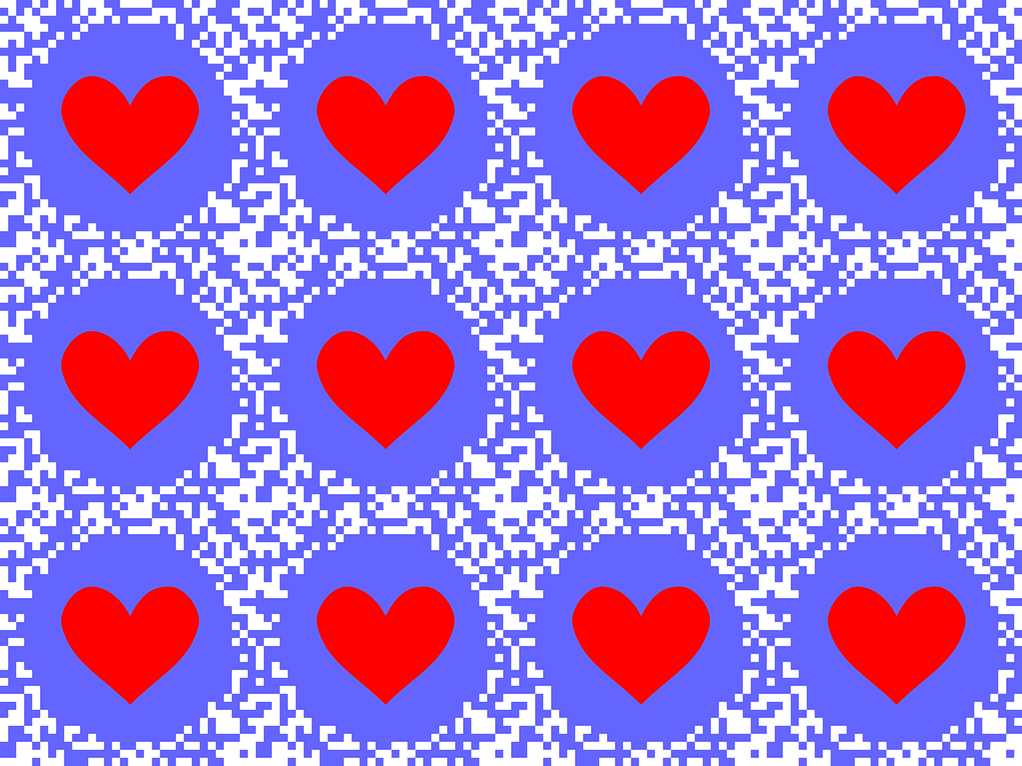
"Fluttering red hearts in front of the blue background"
Hearts appear to move when the image is moved or your pair of glasses are moved. This illusion is enhanced in a dark condition or in the mesopic vision.
Copyright Akiyoshi Kitaoka 2013 (January 18)
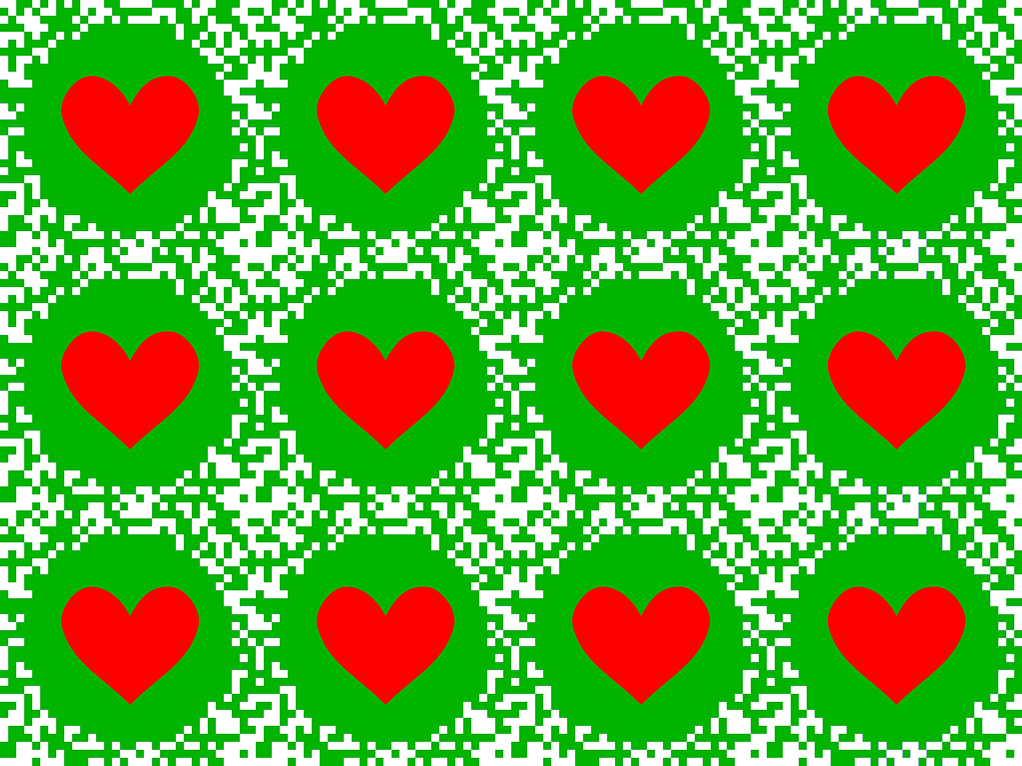
"Fluttering red hearts in front of the green background"
Hearts appear to move when the image is moved or your pair of glasses are moved. This illusion is enhanced in a dark condition or in the mesopic vision.
Copyright Akiyoshi Kitaoka 2013 (January 21)
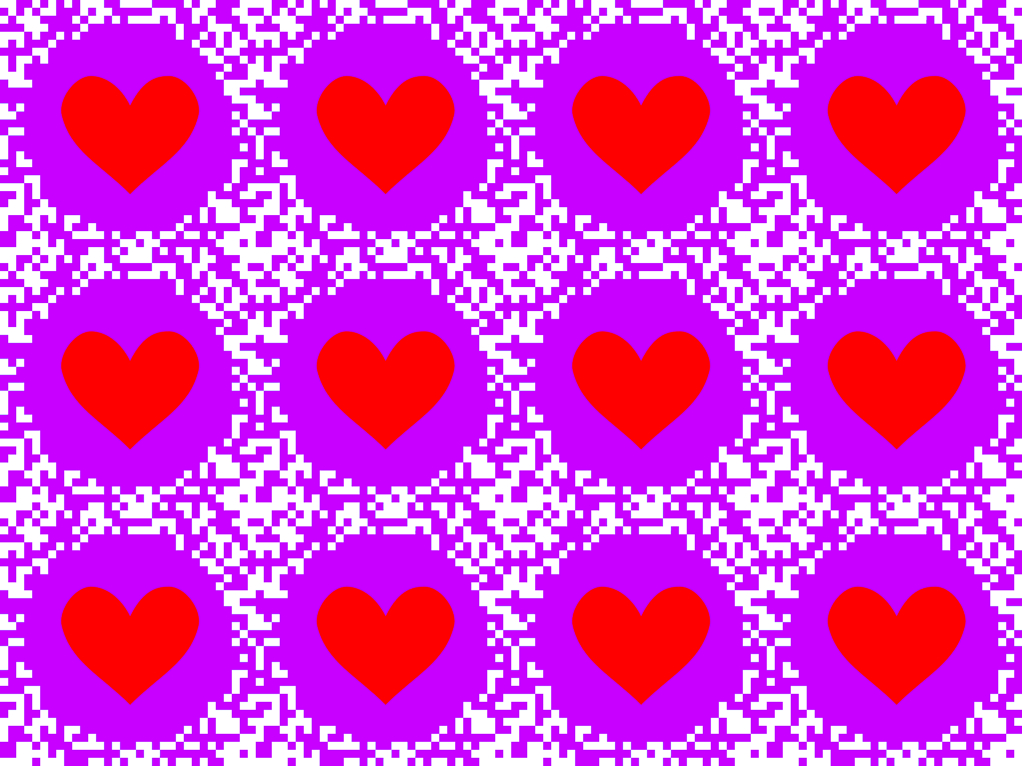
"Fluttering red hearts in front of the red-purple background"
Hearts appear to move when the image is moved or your pair of glasses are moved. This illusion is enhanced in a dark condition or in the mesopic vision.
Copyright Akiyoshi Kitaoka 2013 (January 16)
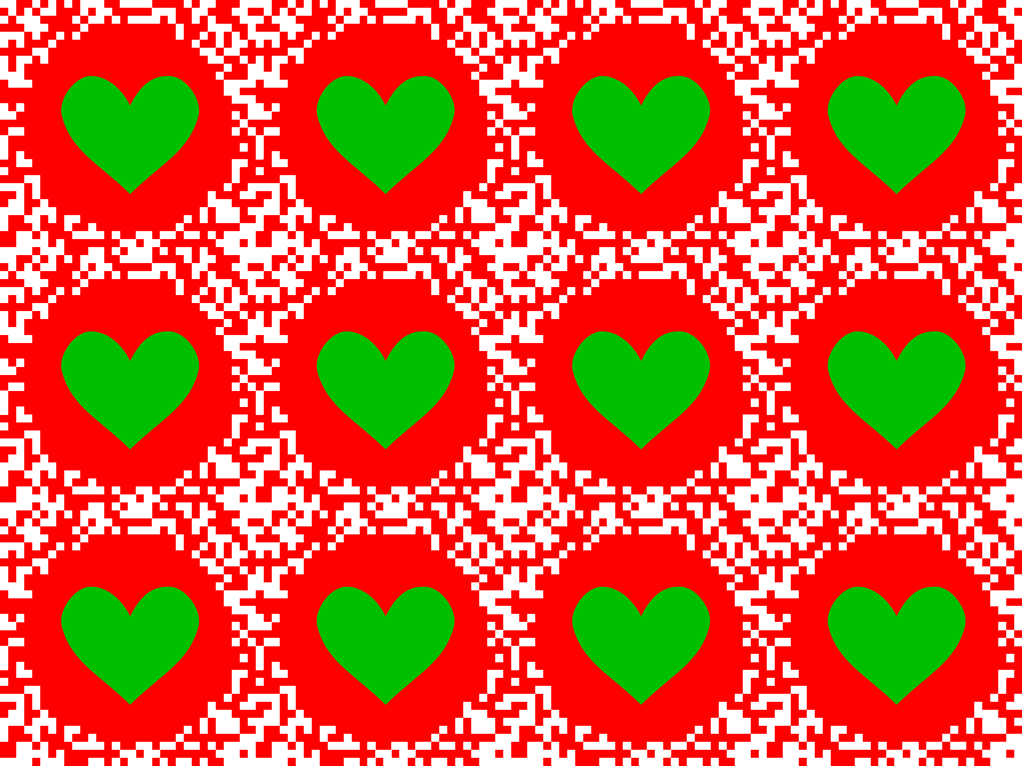
"Fluttering green hearts in front of the red background"
Hearts appear to move when the image is moved or your pair of glasses are moved. This illusion is enhanced in a dark condition or in the mesopic vision.
Copyright Akiyoshi Kitaoka 2013 (February 15)
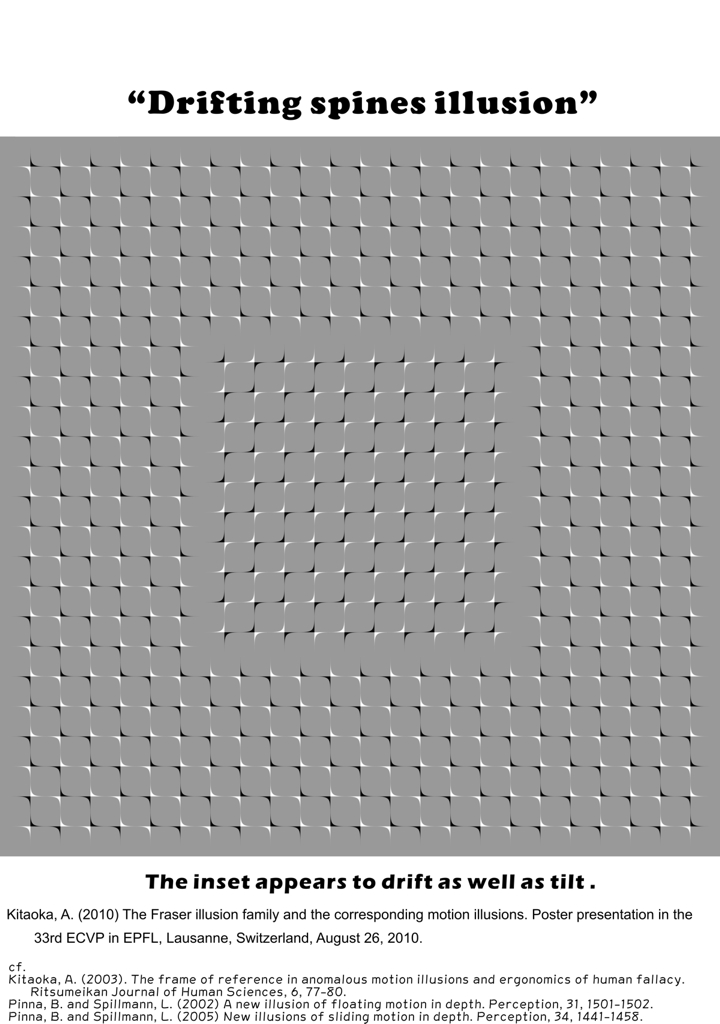
For this illusion group, see:
Kitaoka, A. (2010) Tilt illusions and anomalous motion illusions. (talk in the RIKEN BSI on July 2, 2010) Presentation (html)
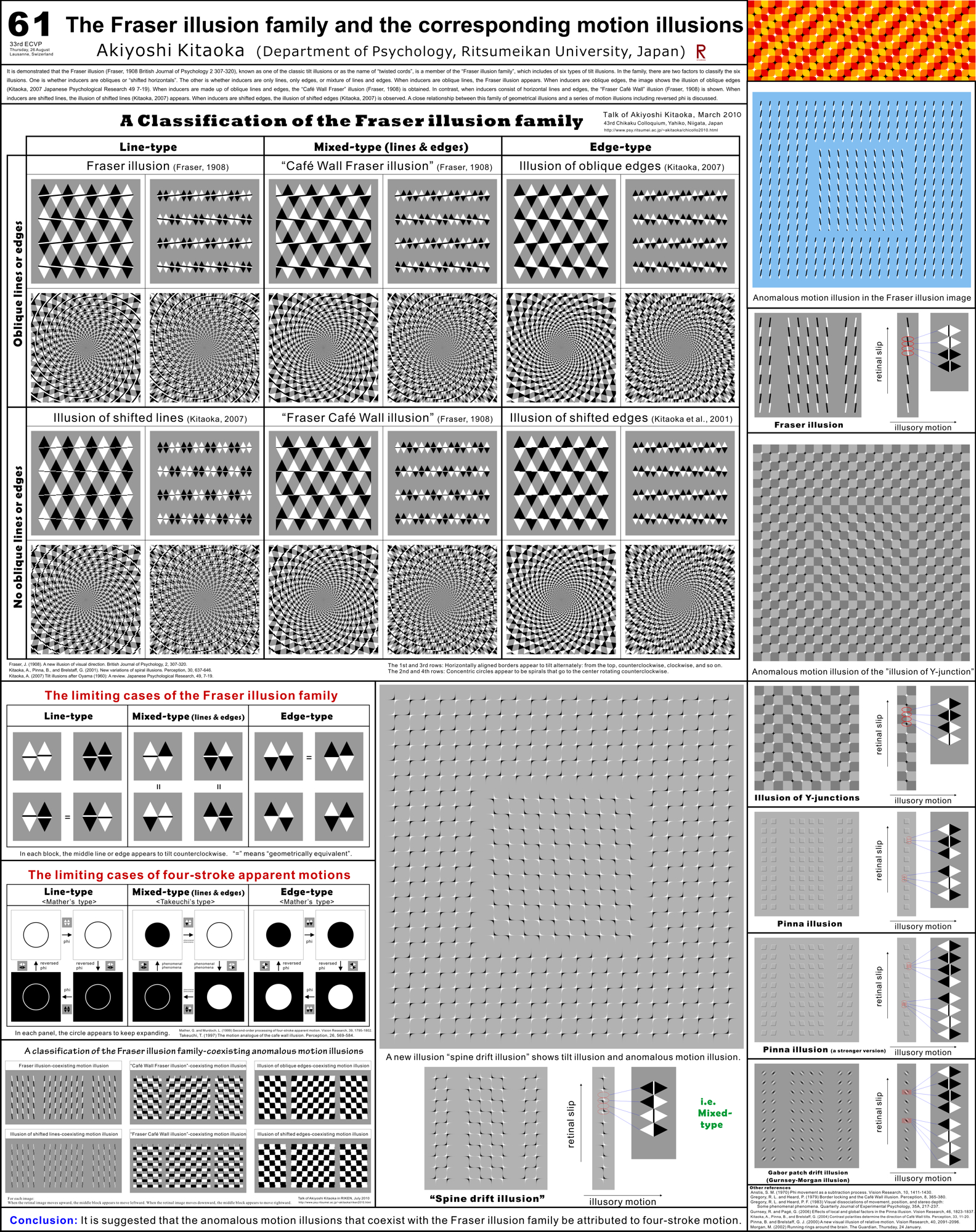
Kitaoka, A. (2010). The Fraser illusion family and the corresponding motion illusions. 33rd European Conference on Visual Perception (ECVP 2010), EPFL, Lausanne, Switzerland, 2010/8/22-26, 8/26 poster publication. Poster(Kitaoka, A. (2010) The Fraser illusion family and the corresponding motion illusions. Perception, 39, Supplement, #61, p. 178)
The 4-stroke tilt illusion of the mixed type (supposing e.g. the Café Wall illusion)

The horizontally aligned border of the upper and lower halves appears to
tilt counterclockwise.
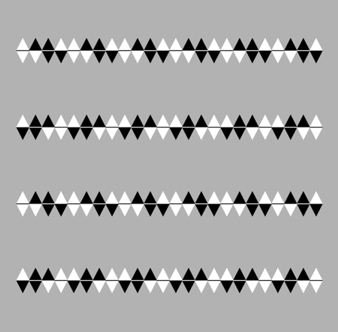
The horizontally aligned border of the uppermost row appear to tilt counterclockwise, and the other borders appear to tilt alternately.
The 4-stroke motion of the mixed type (Takeuchi's four-stroke motion)
The border appears to move upward.
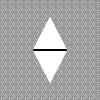
(GIF animation)

The movie shows elements in the order 123412341234...
Copyright Akiyoshi Kitaoka 2012 (December 4)
Café Wall illusion
The horizontal gray line appears to tilt counterclockwise (Fraser, 1908;
Gregory and Heard, 1979; Münsternerg, 1897).

Fraser, J. (1908) A new visual illusion of direction. British Journal of Psychology, 2, 307-320.
Gregory, R. L. and Heard, P. (1979) Border locking and the Café Wall illusion. Perception, 8, 365-380.
Münsterberg, H. (1897) Die vershobene Schachbrettfigur. Zeitschrift für Psychologie, 15, 184-188.
The 4-stroke tilt illusion of the line type (illusion of shifted lines)

The horizontally aligned border of the upper and lower halves appears to
tilt counterclockwise.
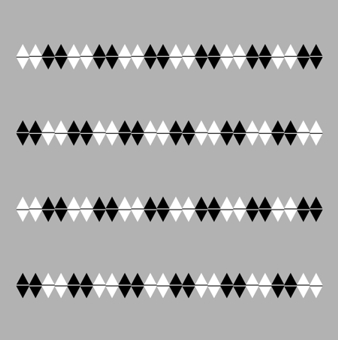
The horizontally aligned border of the uppermost row appear to tilt counterclockwise, and the other borders appear to tilt alternately.
The 4-stroke motion of the line type
The border appears to move upward.
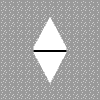
(GIF animation)

The movie shows elements in the order 123412341234...
Copyright Akiyoshi Kitaoka 2012 (December 4)
illusion of shifted lines
The horizontal black-and-white line appears to tilt counterclockwise (Kitaoka,
2007).

Kitaoka, A. (2007) Tilt illusions after Oyama (1960): A review. Japanese Psychological Research, 49, 7-19. PDF
The 4-stroke tilt illusion of the line type (illusion of shifted edges)

The horizontally aligned border of the upper and lower halves appears to
tilt counterclockwise.
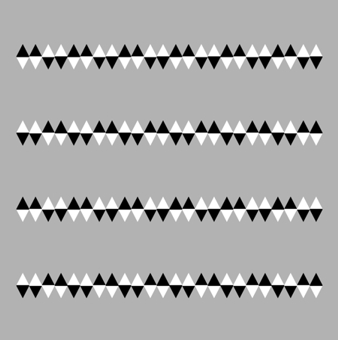
The horizontally aligned border of the uppermost row appear to tilt counterclockwise, and the other borders appear to tilt alternately.
The 4-stroke motion of the edge type
The border appears to move upward.
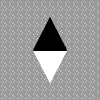
(GIF animation)

The movie shows elements in the order 123412341234...
Copyright Akiyoshi Kitaoka 2012 (December 4)
illusion of shifted edges
The horizontal border appears to tilt counterclockwise (Kitaoka, 2007).

Kitaoka, A. (2007) Tilt illusions after Oyama (1960): A review. Japanese Psychological Research, 49, 7-19. PDF
References
Kitaoka, A. (2006). Configurational coincidence
among six phenomena: A comment on van Lier and Csathó (2006). Perception,
35, 799-806. ![]() animations
animations
Kitaoka, A. (2010) The Fraser illusion family and the corresponding motion illusions. 33rd European Conference on Visual Perception (ECVP 2010), EPFL, Lausanne, Switzerland, 2010/8/22-26, 8/26 poster publication. Poster (Kitaoka, A. (2010) The Fraser illusion family and the corresponding motion illusions. Perception, 39, Supplement, #61, p. 178)
Kitaoka, A. (2010) Tilt illusions and anomalous motion illusions. (talk in the RIKEN BSI on July 2, 2010) Presentation (html)
The 4-stroke tilt illusion of the asymmetric line type (illusion of striped cords)

The horizontally aligned border of the upper and lower halves appears to
tilt counterclockwise.
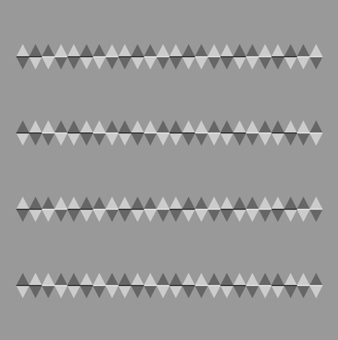
The horizontally aligned border of the uppermost row appear to tilt counterclockwise, and the other borders appear to tilt alternately.
The 4-stroke motion of the asymmetric line type
The border appears to move upward.
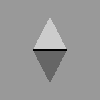
(GIF animation)

The movie shows elements in the order 123412341234...
Copyright Akiyoshi Kitaoka 2012 (December 5)
illusion of striped cords
The horizontal black-and-white line appears to tilt counterclockwise (Kitaoka,
1998; Kitaoka et al., 2004).

Kitaoka, A. (1998). Apparent contraction of edge angles. Perception, 27, 1209-1219.
Kitaoka, A., Pinna, B., and Brelstaff, G. (2004). Contrast polarities determine the direction of Café Wall tilts. Perception, 33, 11-20.
The 4-stroke tilt illusion of the asymmetric edge type
(a variation of the illusion of striped cords or a variation of the illusion
of shifted edges)

The horizontally aligned border of the upper and lower halves appears to
tilt counterclockwise.
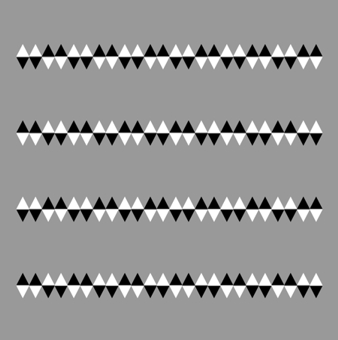
The horizontally aligned border of the uppermost row appear to tilt counterclockwise, and the other borders appear to tilt alternately.
The 4-stroke motion of the asymmetric edge type
The border appears to move upward.

(GIF animation)

The movie shows elements in the order 123412341234...
Copyright Akiyoshi Kitaoka 2012 (December 5)
a variation of the illusion of striped cords (illusion of striped edges)
The horizontal border appears to tilt counterclockwise (Kitaoka, 2007;
; Kitaoka et al., 2004).

Kitaoka, A. (2007) Tilt illusions after Oyama (1960): A review. Japanese Psychological Research, 49, 7-19. PDF
Kitaoka, A., Pinna, B., and Brelstaff, G. (2004). Contrast polarities determine the direction of Café Wall tilts. Perception, 33, 11-20.
The multi-stroke tilt illusion of the asymmetric line type
(Montalvo illusion = Lavatory Wall illusion)

The horizontally aligned border of the upper and lower halves appears to
tilt counterclockwise.
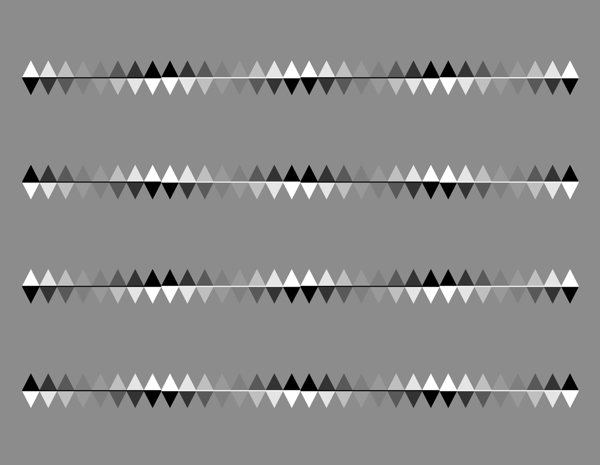
The horizontally aligned border of the uppermost row appear to tilt counterclockwise, and the other borders appear to tilt alternately.
The 4-stroke motion of the asymmetric edge type

(GIF animation)

The movie shows elements in the order 123412341234...
Copyright Akiyoshi Kitaoka 2012 (December 5)
Montalvo illusion (Lavatory Wall illusion)
The horizontal line appears to tilt counterclockwise (Sakane 1980; Woodhouse
and Taylor 1987). This illusion was first presented by Fanya S. Montalvo
in 1980 (Sakane 1980) and was independently reported by Woodhouse and Taylor
(1987) who termed it 'Lavatory Wall illusion'. Also see Kitaoka et al.
(2004) and Kitaoka (2007).

Kitaoka, A. (2007) Tilt illusions after Oyama (1960): A review. Japanese Psychological Research, 49, 7-19. PDF
Kitaoka, A., Pinna, B., and Brelstaff, G. (2004). Contrast polarities determine the direction of Café Wall tilts. Perception, 33, 11-20.
Sakane I, 1980 Shin Asobino Hakubutsushi (A New Museum of Fun Book) Part II Tokyo: Asahi-bunko (pp. 156-165) (in Japanese).
Woodhouse J M, Taylor, S P, 1987 “Further studies of the Café Wall and Hollow Squares illusions” Perception 16 467-471
First presented by Fanya S. Montalvo in 1980 (Sakane 1980) it has since been termed the Lavatory Wall illusion (Woodhouse and Taylor 1987).
静止画が動いて見える錯視一覧(Motion illusion in a static image)
Color illusion
問: 下記のような色から、オレンジ色と赤紫色を同時に作る方法はあるか?
Make orange color and red-purple color from the three color shown below.

答: ある。
You can do like this.

Produced Akiyoshi Kitaoka 2012 (September 16)
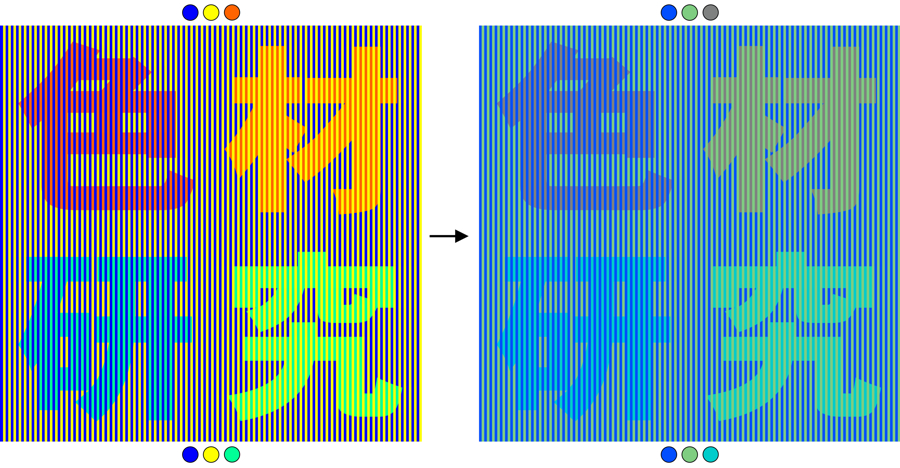
「ムンカー錯視と色の恒常性の色材研究」
Munker illusion and its "color constantancy illusion"
左の「色材」は赤が赤紫とオレンジに見え、「研究」は水色と黄緑色に見える。右の「色材」は灰色が赤紫とオレンジに見え、「研究」は青緑色が水色と黄緑色に見える。
There appear red purple and orange characters but they are the same red
in the left image and the same gray in the right image.
Copyright Akiyoshi Kitaoka 2012 (September 16)
色の錯視の色の恒常性図形の作り方
How to make an image which demonstrates the color constancy illusion of
color illusion
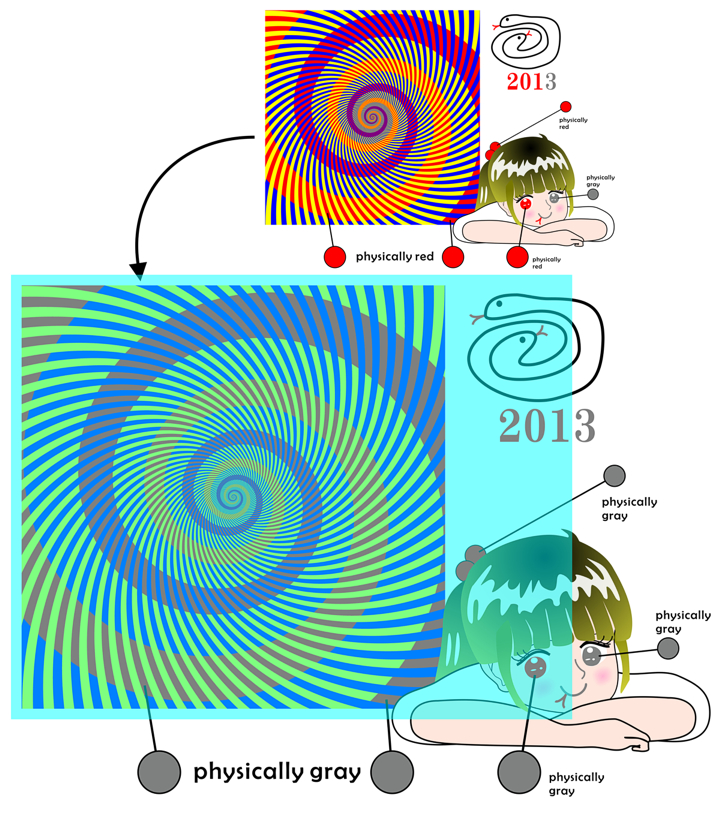
Copyright Akiyoshi Kitaoka 2012 (December 7)
問: お月様と同じ物理的な色をしている円は下の3つのうちどれでしょう。
Q: Which of the three colors shown below is the same color as the moon?
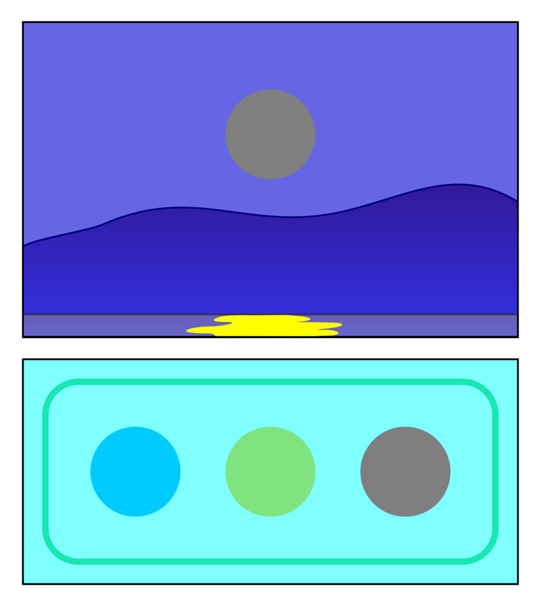
問: 下記のような色から金色を作る方法はあるか?
Make gold color from such colors shown below.

答: ある。
You can do like this.
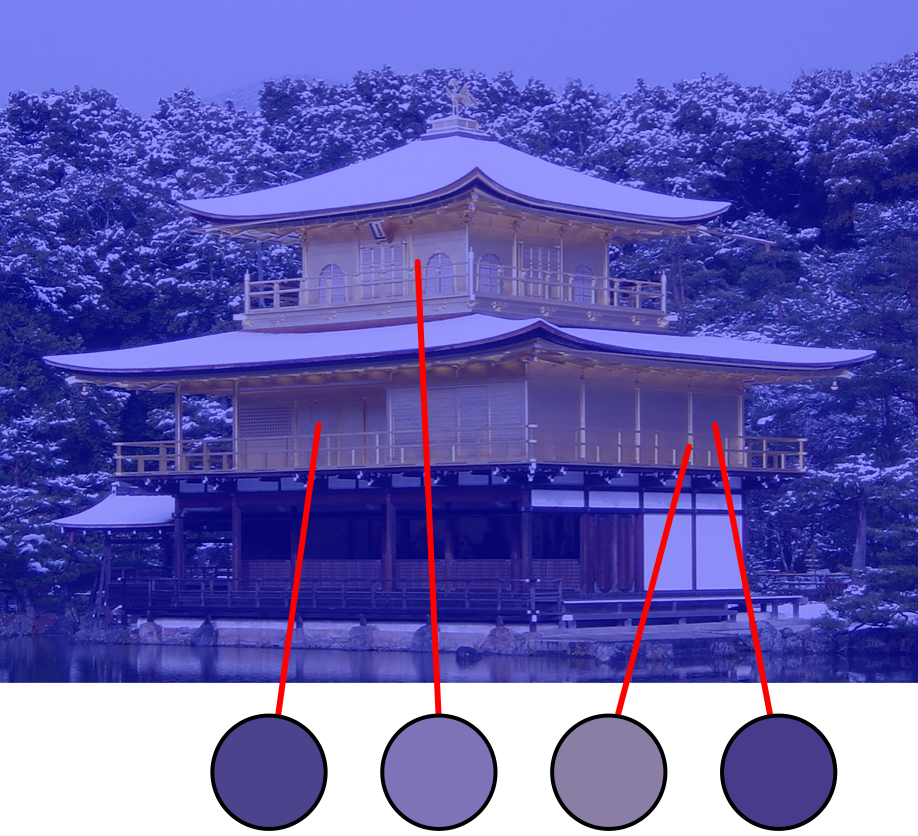
「青い金閣」
"Bluish Golden Palace"
青フィルターがかかっていやな感じではあるが金閣は金色に見える。金色は黄色系統でなければならないという前提があるなら、この合成画像で金閣が金色に見えることは錯視であり、知覚される金色は物理的には青系統の色である。
Copyright Akiyoshi Kitaoka 2011 (July 14)
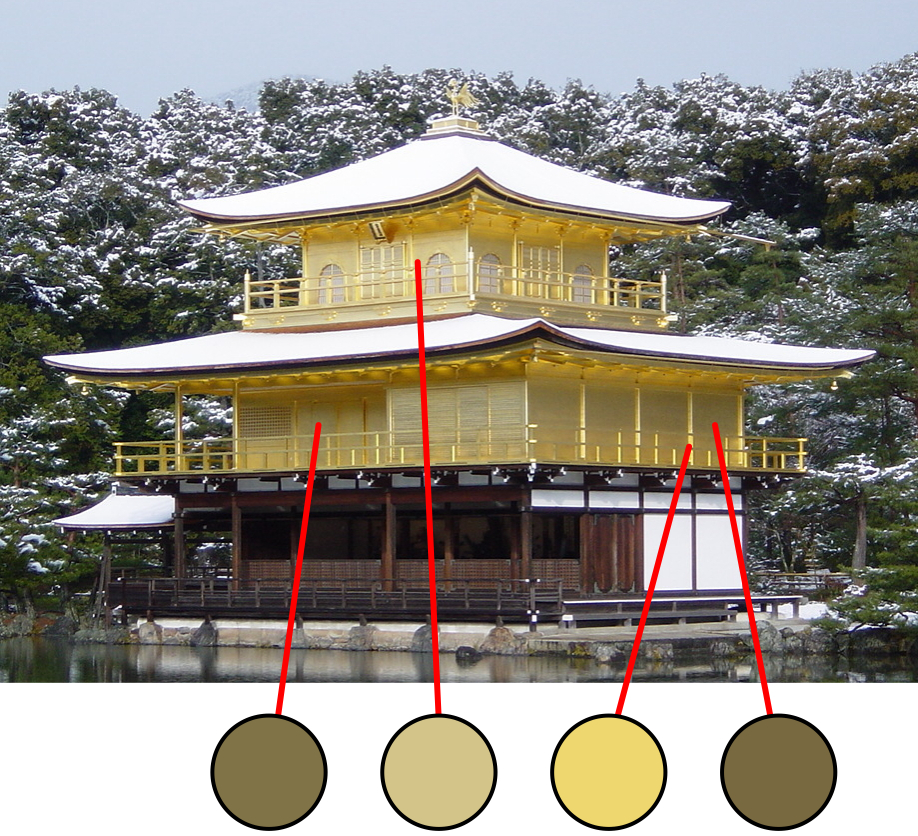
Golden Palace
黄色系統でなくても金色に見える。
Gold color can be made from bluish colors.
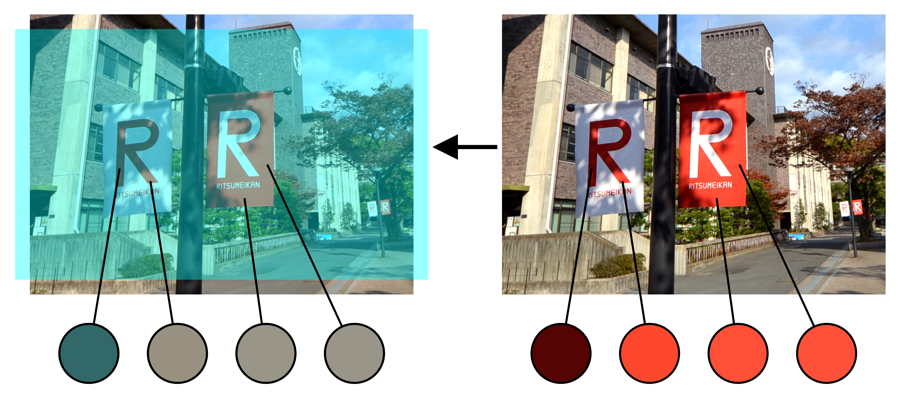
「立命館大学ののぼりの色の恒常性」
"Ritsumeikan flags"
Copyright Akiyoshi Kitaoka 2012 (November 30)
色の恒常性錯視デモ用のプリント用ファイル DOC

References
北岡明佳 (2011) 色の錯視いろいろ (2)色の恒常性と2つの色フィルタ 日本色彩学会誌, 35(3), 234-236. PDF(スキャンコピー), PDF(高解像度スキャンコピー)
北岡明佳 (2011) 色の錯視いろいろ (1)「目の色の恒常性」という錯視の絵 日本色彩学会誌, 35(2), 118-119. PDF(スキャンコピー)
加法的色変換
Additive color changes
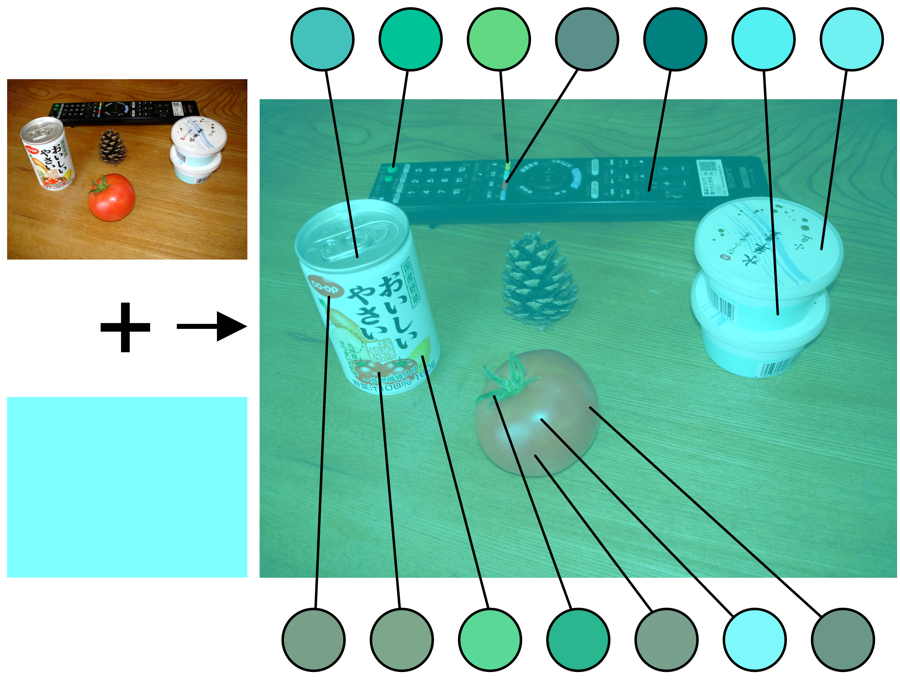
北岡明佳 (2011) 色の錯視いろいろ (2)色の恒常性と2つの色フィルタ 日本色彩学会誌, 35(3), 234-236. <図2>

乗法的色変換
Multiplicative color change
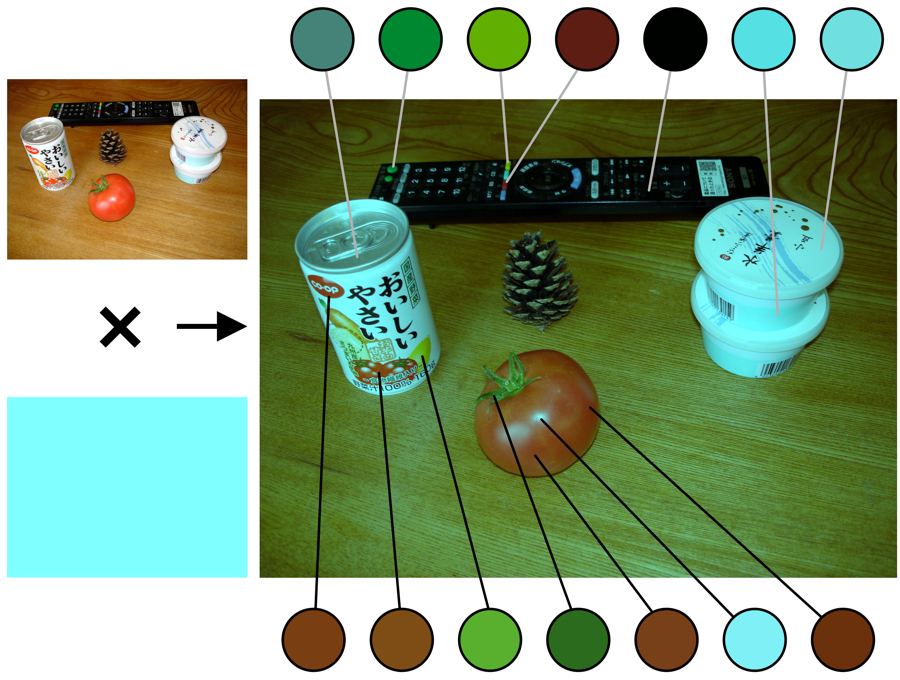
北岡明佳 (2011) 色の錯視いろいろ (2)色の恒常性と2つの色フィルタ 日本色彩学会誌, 35(3), 234-236. <図4>
北岡明佳 (2011) 色の錯視いろいろ (2)色の恒常性と2つの色フィルタ 日本色彩学会誌, 35(3), 234-236. PDF(スキャンコピー), PDF(高解像度スキャンコピー)
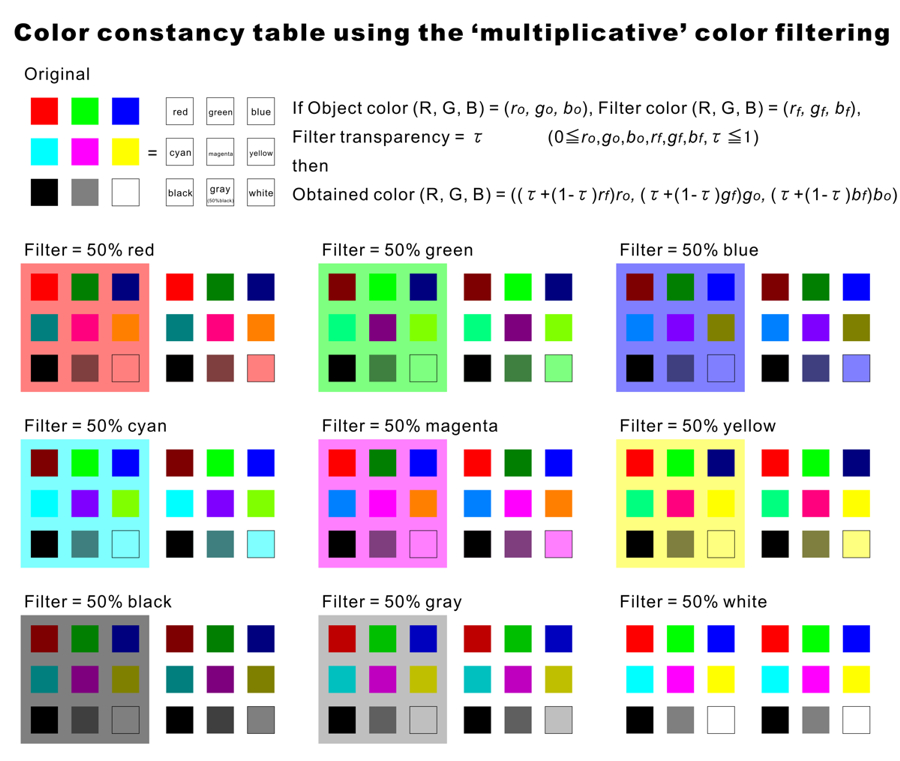
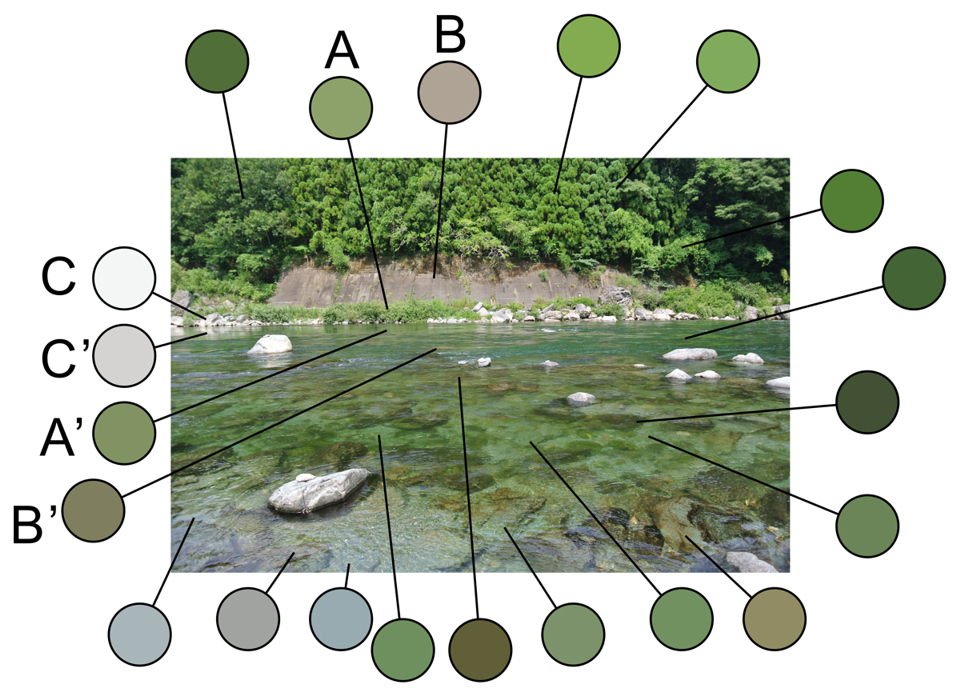
加法的色変換の例・・・「清流」の緑は山の緑
Example of additive color changes
Copyright Akiyoshi Kitaoka 2013 (August 3)

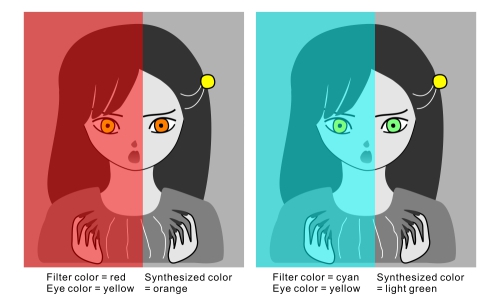
「色の恒常性による両眼闘争の抑制」
"No binocular rivalry in the color constancy eye"
2つの図を両眼融合して見ると、左目はオレンジ色と緑色の間の両眼闘争を起こすが、右目は黄色に見えたままである。しかし、右目は左目と同じく、物理的にはオレンジ色と緑色なのである。
Try to fuse them binocularly. Then, the left eye shows binocular rivalry
between orange and green, while the right eye does not. This observation
is remarkable since the right eye is the same color as the left eye in
each image.
Copyright Akiyoshi Kitaoka 2009 (June 29)
色の恒常性は高次な知覚という先入観が私にはあったが、本図は低次処理の証拠となるかもしれない。
This phenomenon might suggest that color constancy should reflect a rather
low-level visual process.
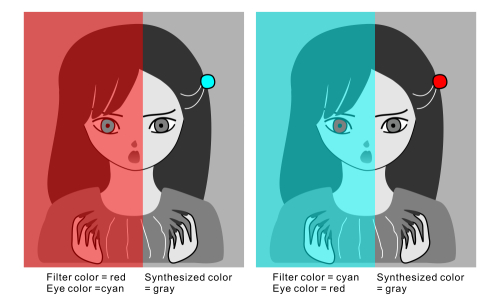
「色の恒常性による両眼闘争」
"Binocular rivalry in the color constancy eye"
2つの図を両眼融合して見ると、右目はシアン色(水色)と赤色の間の両眼闘争を起こすことがあるが、左目は灰色に見えたままである。しかし、どちらの右目も左目と同じく、物理的には灰色なのである。
Try to fuse them binocularly. Then, the right eye sometimes shows binocular
rivalry between cyan and red, while the left eye does not. This observation
is remarkable since the right eye is the same gray for each image.
Copyright Akiyoshi Kitaoka 2009 (June 29)
両眼の情報が統合される前に色の恒常性が成立していないと両眼闘争はしないよね・・・その論理でいいのか??
This phenomenon might also support the idea that color constancy should
reflect a rather low-level visual process.

Limited case: "No binocular rivalry in the color constancy eye"
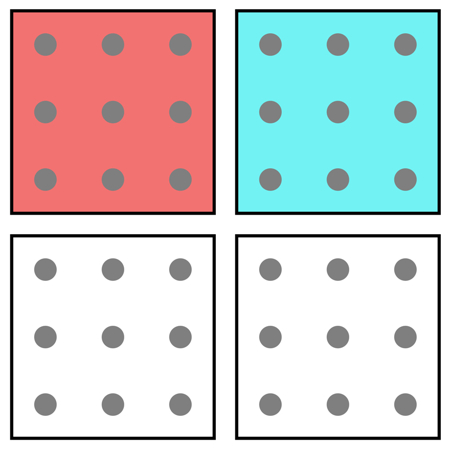
Limited case: "Binocular rivalry in the color constancy eye"
Copyright Akiyoshi Kitaoka 2013 (October 22)
<色の錯視クイズ>
Quizzes of color illusion
左のハートと物理的に同じ色は(1)(2)(3)のうちどれでしょう。
Which is the same color as the leftmost heart, (1), (2), or (3)?
Q1
Q2
Q3
Q4 
ムンカー錯視(Munker illusion)
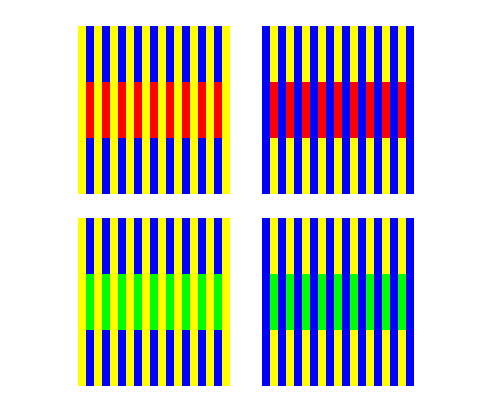
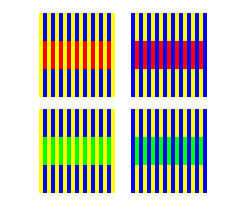
黄と青の縞の青部分に赤を乗せるとオレンジ色に見え、黄部分に赤を乗せると赤紫がかって見える。緑を乗せるとそれぞれ黄緑と青緑に見える。高空間周波数図形で錯視量が多い。
Munker, H. (1970) Farbige Gitter, Abbildung auf der Netzhaut und übertragungstheoretische Beschreibung der Farbwahrnehmung. München: Habilitationsschrift.
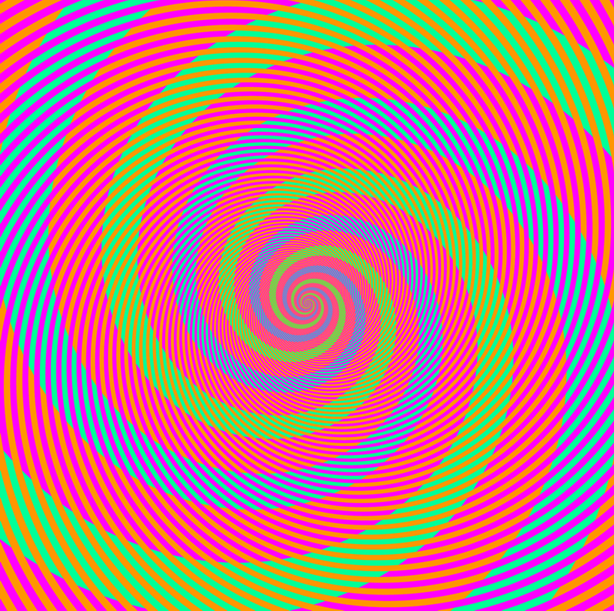
"Green and blue spirals"
There appear to be spirals of light green or light blue. Actually, they are identical (r = 0, g = 255, b = 150).
Copyright A.Kitaoka 2003
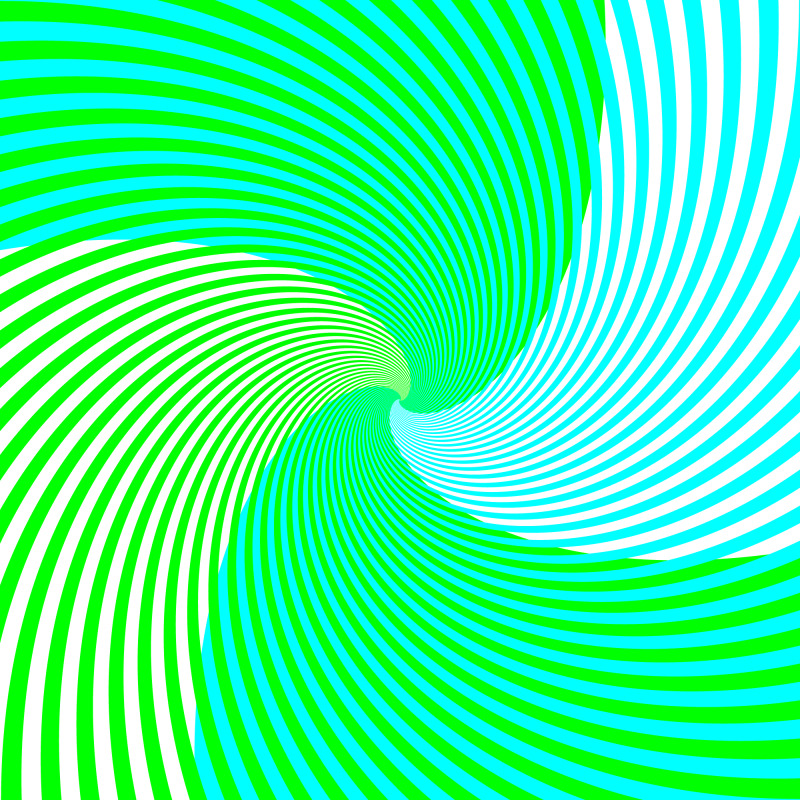
「小家族」
"The ground family"
左の鳩も右の鳩も同じ色なのだが、左の方は黄味がかって見える。
The left pigeon appears to be yellowish, but the color is the same white
as the right.
Copyright Akiyoshi .Kitaoka 2007 (March 12)
色の土牢錯視 (Chromatic dungeon illusion)
「犬」
赤い犬は2種類、緑の犬も2種類いるように見えるが、それぞれ同じ赤と緑である。色の土牢錯視である。
別バージョン 別バージョン2
Copyright Akiyoshi .Kitaoka 2007 (January 5)
土牢錯視(dungeon illusion)(Bressan, 2001)とは?
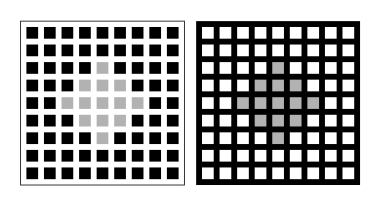
左の「牢屋」の灰色のダイヤモンド形は右のよりも明るく見えるが、物理的には同じ明るさである。
Bressan, P. (2001) Explaining lightness illusions. Perception, 30, 1031-1046.
色の土牢錯視とは?
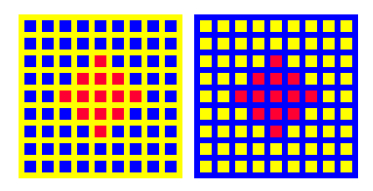
左の「牢屋」のダイヤモンド形はオレンジ色に、右のは少し紫がかった赤に見えるが、物理的には同じ色である。
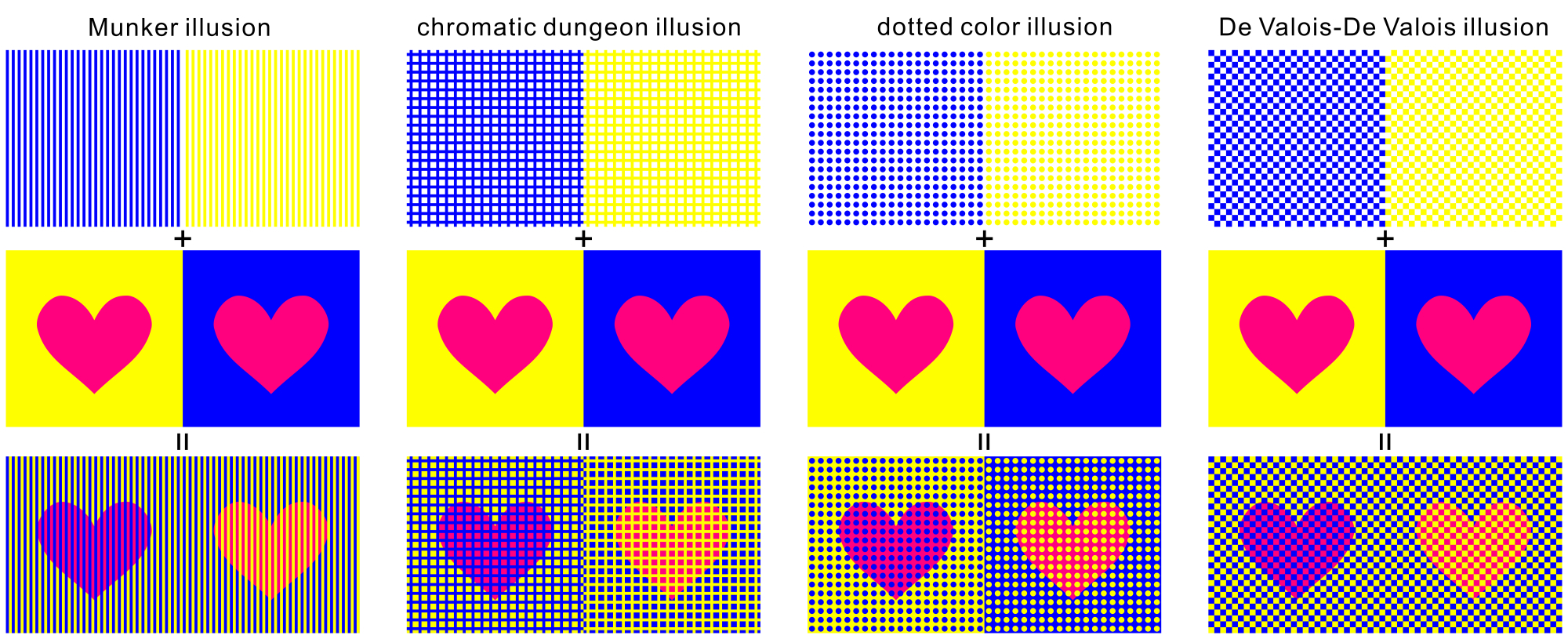
"How to make the four types of color illusions"
Hearts of the same color (R=255, G=0, B=127) appear to be pink or orange, induced by the Munker illusion, the chromatic dungeon illusion, the dotted color illusion, and the De Valois-De Valois illusion. To download high-resolution files, click here (8000 x 3262 pixel, 10MB)
Copyright Akiyoshi Kitaoka 2009 (June 1)
References
| Munker illusion | Munker, H. (1970) Farbige Gitter, Abbildung auf der Netzhaut und übertragungstheoretische Beschreibung der Farbwahrnehmung. Habilitationsschrift, Ludwig-Maximilians-Universität, München. |
| chromatic dungeon illusion | For the dungeon illusion: Bressan, P. (2001) Explaining lightness illusions.
Perception, 30, 1031-1046. Kitaoka (2007) http://www.psy.ritsumei.ac.jp/~akitaoka/saishin22e.html |
| dotted color illusion | For the dotted brightness illusion: White, M. (1982) The assimilation-enhancing effect of a dotted surround upon a dotted test region. Perception, 11, 103-106. Kitaoka (2008) http://www.psy.ritsumei.ac.jp/~akitaoka/color10e.html |
| De Valois-De Valois illusion | De Valois, R. L. and De Valois, K. K. (1988) Spatial Vision. New York: Oxford University Press. |
cf.
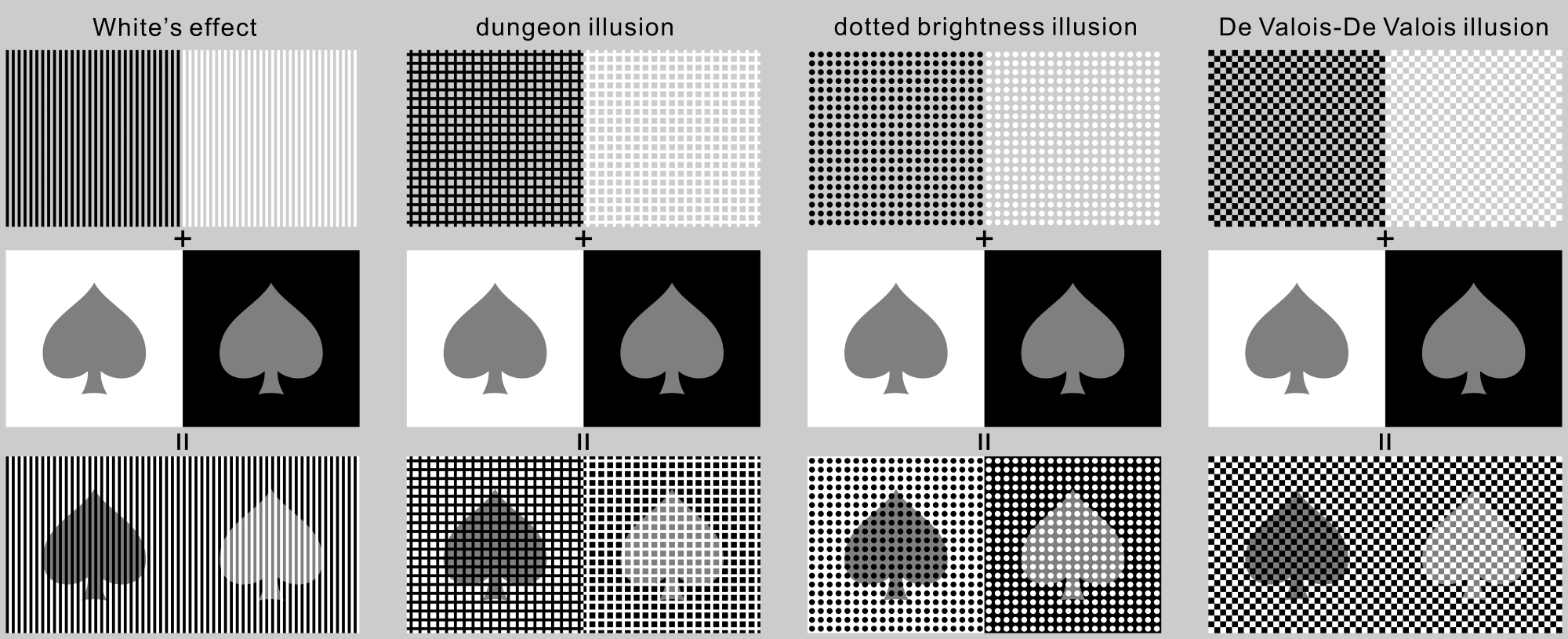
"How to make the four types of brightness illusions"
Spades of the same brightness (R=127, G=127, B=127) appear to be darker or brighter, induced by White's effect, Bressan's dungeon illusion, White's dotted brightness illusion, and the De Valois-De Valois illusion. To download high-resolution files, click here (8000 x 3262 pixel, 5MB)
Copyright Akiyoshi Kitaoka 2009 (June 1)
References
| White's effect | White, M. (1979) A new effect on perceived lightness. Perception, 8, 413-416. |
| dungeon illusion | Bressan, P. (2001) Explaining lightness illusions. Perception, 30, 1031-1046. |
| dotted brightness illusion | White, M. (1982) The assimilation-enhancing effect of a dotted surround
upon a dotted test region. Perception, 11, 103-106. |
| De Valois-De Valois illusion | De Valois, R. L. and De Valois, K. K. (1988) Spatial Vision. New York: Oxford University Press. |
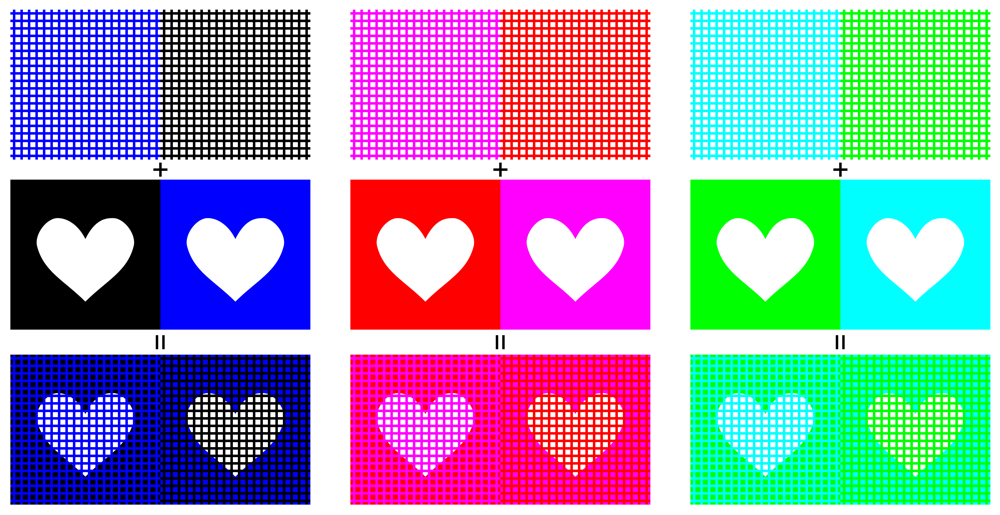
"How to make kibami (yellow-inducing) illusions using the chromatic dungeon illusion"
The right heart (R=255, G=255, B=255) in each block appear to be yellowish, induced by the chromatic dungeon illusion. To download high-resolution files, click here (4000 x 2060 pixel, 10MB)
Copyright Akiyoshi Kitaoka 2009 (June 2)
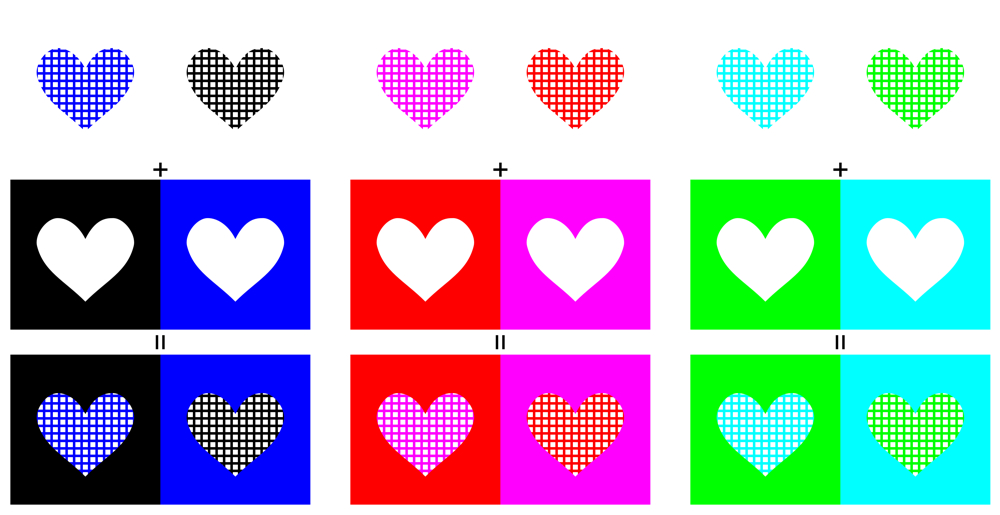
"How to make kibami (yellow-inducing) illusions using the anomalous chromatic dungeon illusion"
The right heart (R=255, G=255, B=255) in each block appear to be yellowish, induced by the chromatic dungeon illusion. To download high-resolution files, click here (4000 x 2060 pixel, 10MB)
Copyright Akiyoshi Kitaoka 2009 (June 2)
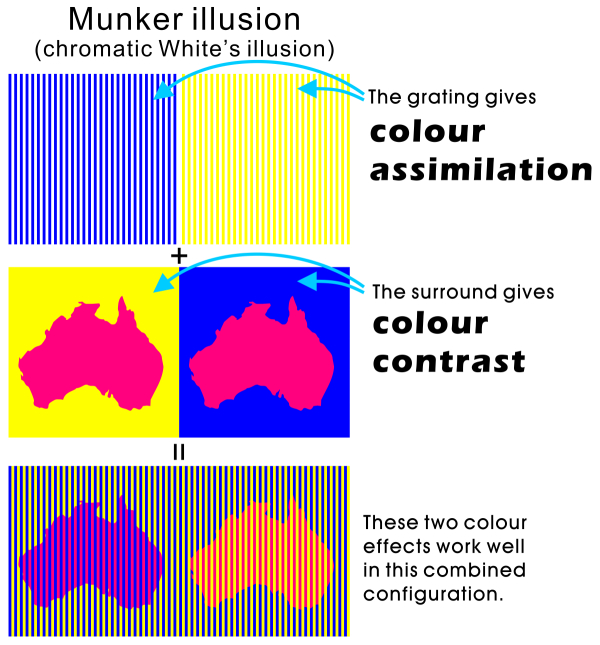
Left: Blue (assimilation) + Blue (contrast of yellow) = Blue induction; Right: Yellow (assimilation) + Yellow (contrast of blue) = Yellow induction
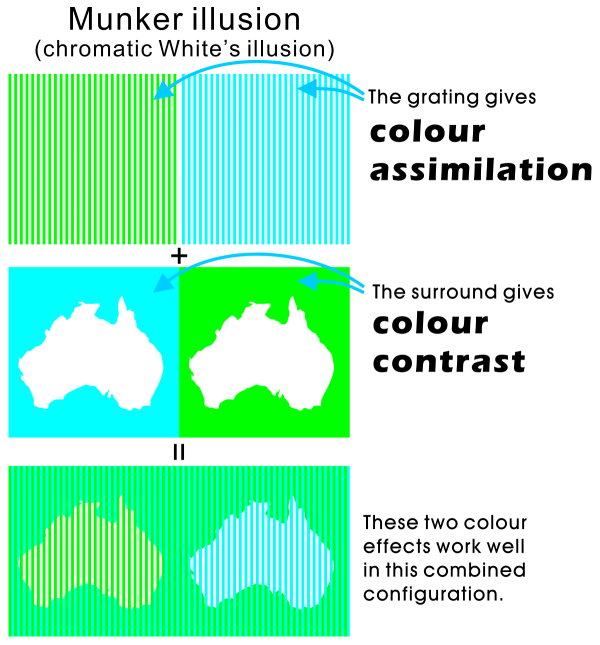
Left: Green (assimilation) + Red (contrast of cyan) = Yellow induction; Right: Cyan (assimilation) + Magenta (contrast of Green) = Blue induction
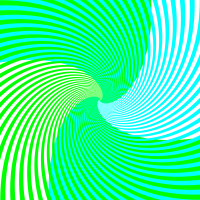 OK?
OK?
色立体視
Chromostereopsis
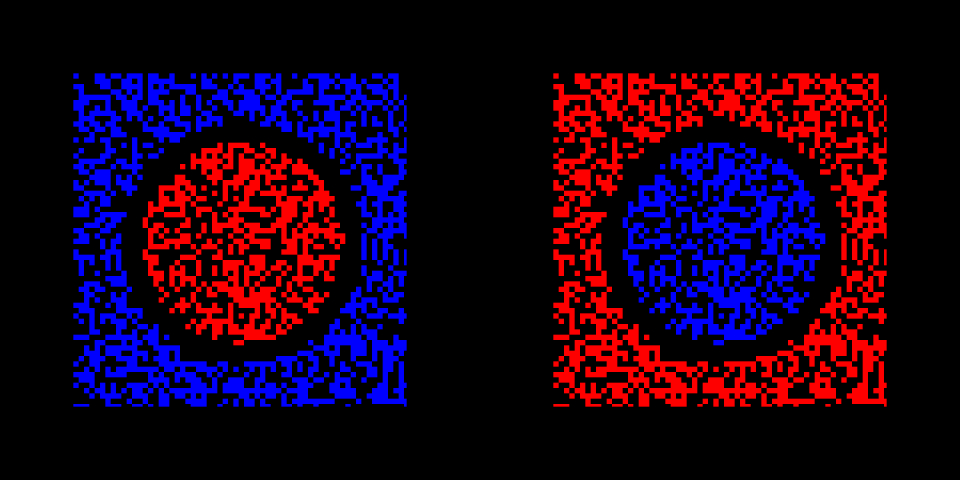
Chromostereopsis. For the majority of observers, the inset made up of red random dots appears to be in front of the surround constituted of blue ones. For a minority, the inset appears to be behind the surround. The rest do not experience the phenomenon. Chromostereopsis is strong when observers see the image at a distance.
Copyright Akiyoshi Kitaoka 2013 (August 3)
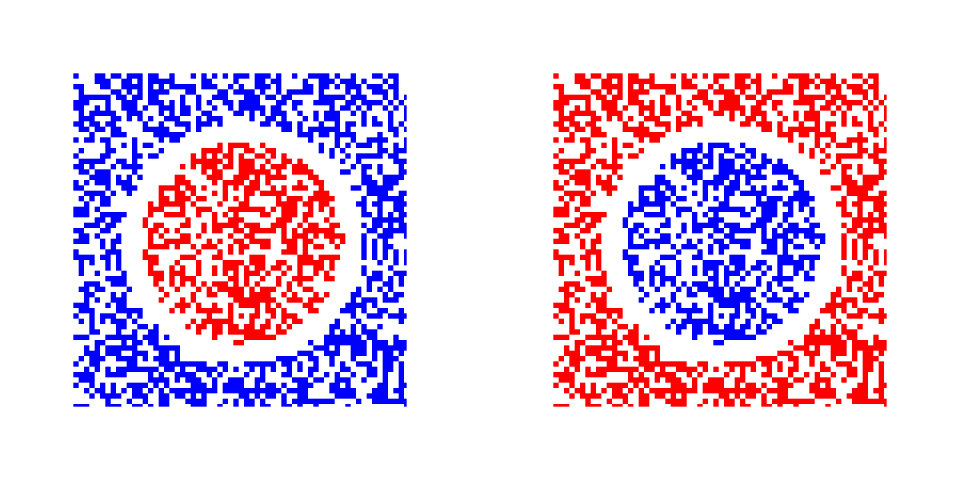
Background luminance-dependent reversal; color reversal
Copyright Akiyoshi Kitaoka 2013 (August 3)
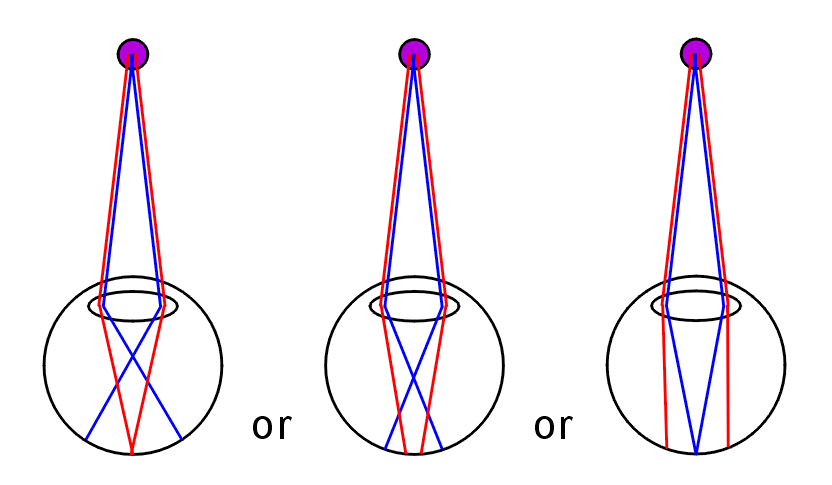
Longitudinal chromatic aberration
Copyright Akiyoshi Kitaoka 2005 (November 24)
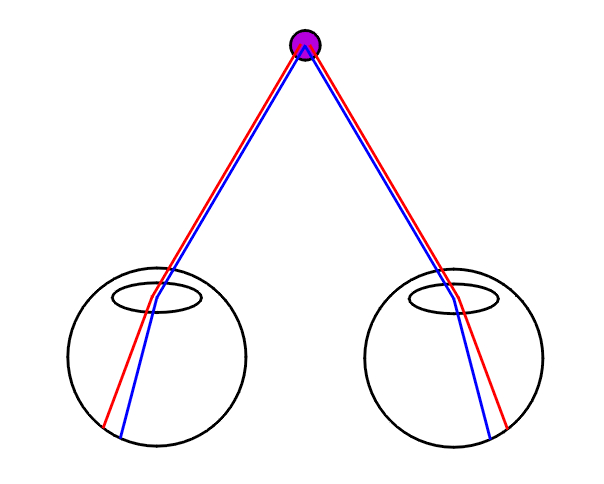
Transverse chromatic aberration
Copyright Akiyoshi Kitaoka 2005 (November 24)
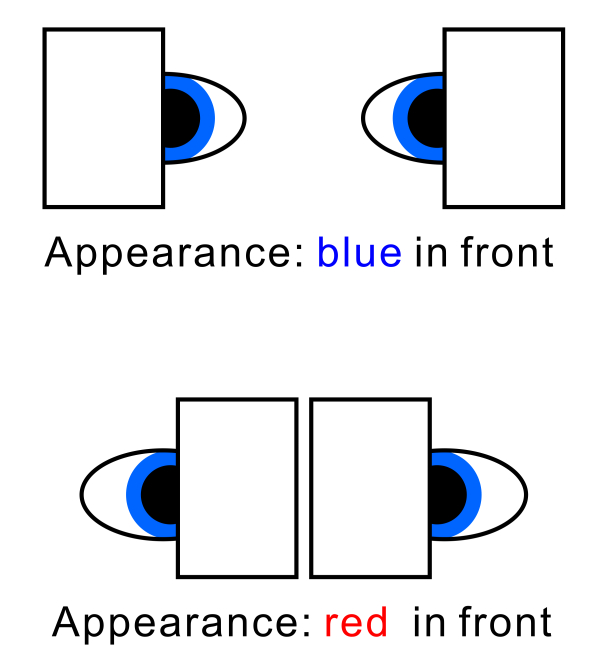
Einthoven's (1885) covering method
Copyright Akiyoshi Kitaoka 2009 (February 29)
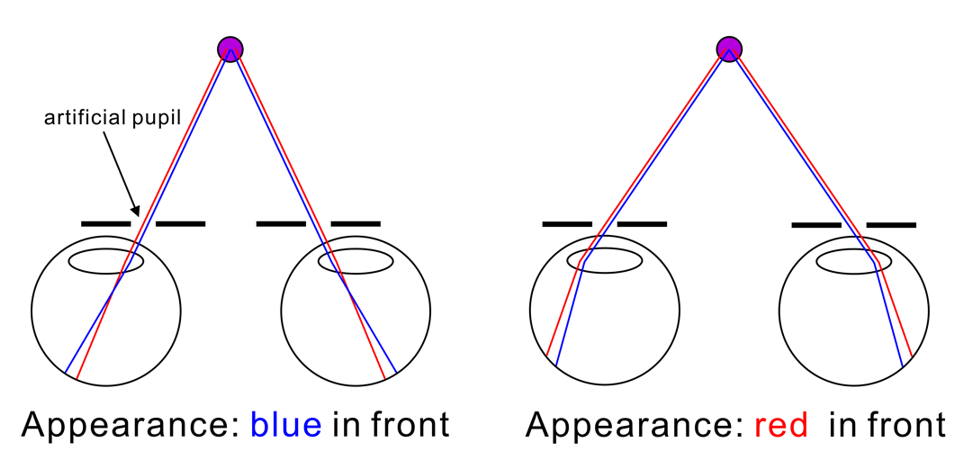
Artificial pupil method & Stiles-Crawford effect
---> Vos' (1960, 2008) "generalised Bruecke-Einthoven explanation"
Copyright Akiyoshi Kitaoka 2009 (February 29)
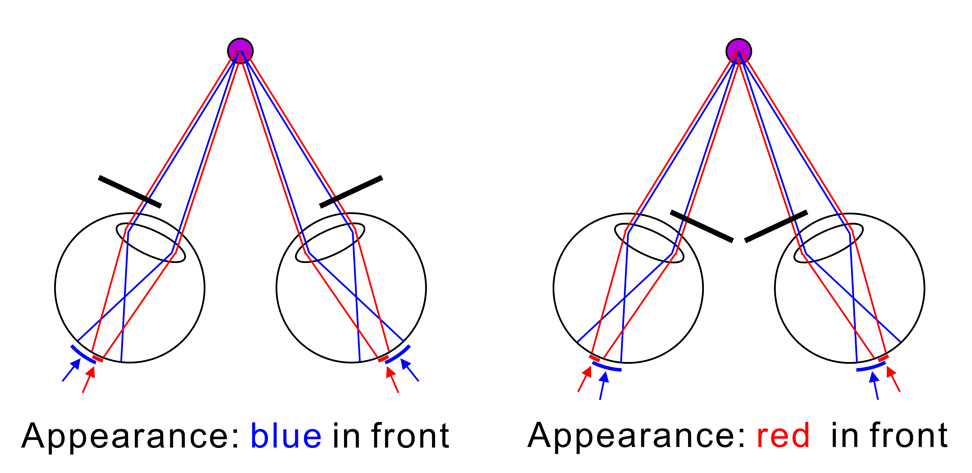
Center-of-gravity model (Kitaoka et al., 2005)
Copyright Akiyoshi Kitaoka 2013 (July 25)
Kitaoka, A, Kuriki, I. and Ashida, H. (2006). The center-of-gravity model of chromostereopsis. Ritsumeikan Journal of Human Sciences, 11, 59-64. PDF
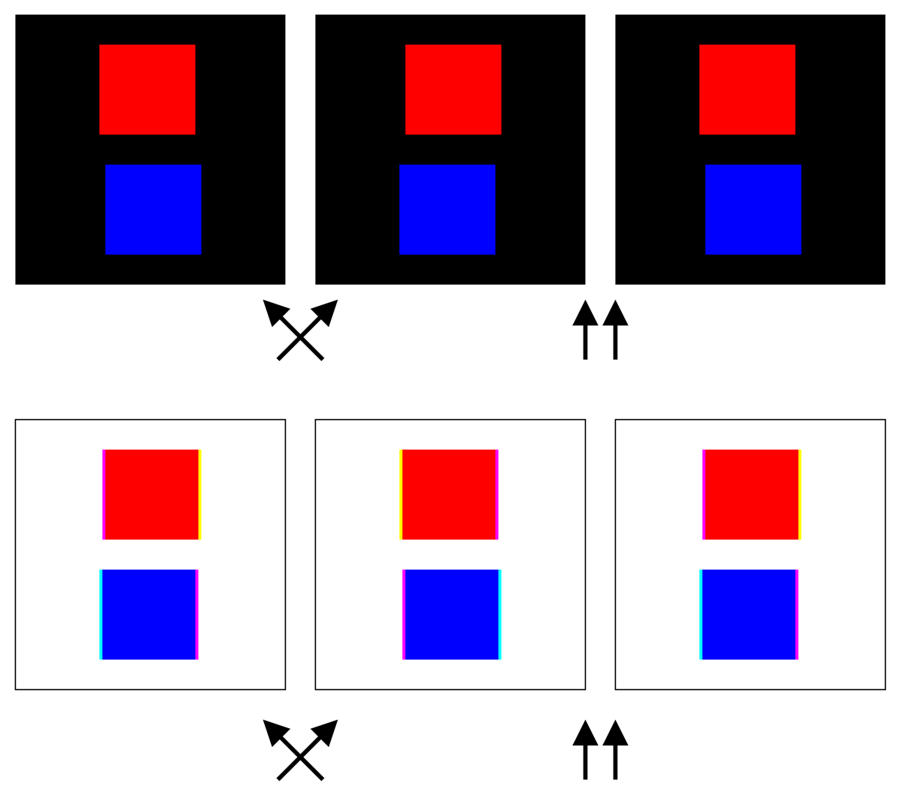
Kitaoka's explanation of the background luminance-dependent reversal
Copyright Akiyoshi Kitaoka 2013 (July 25)
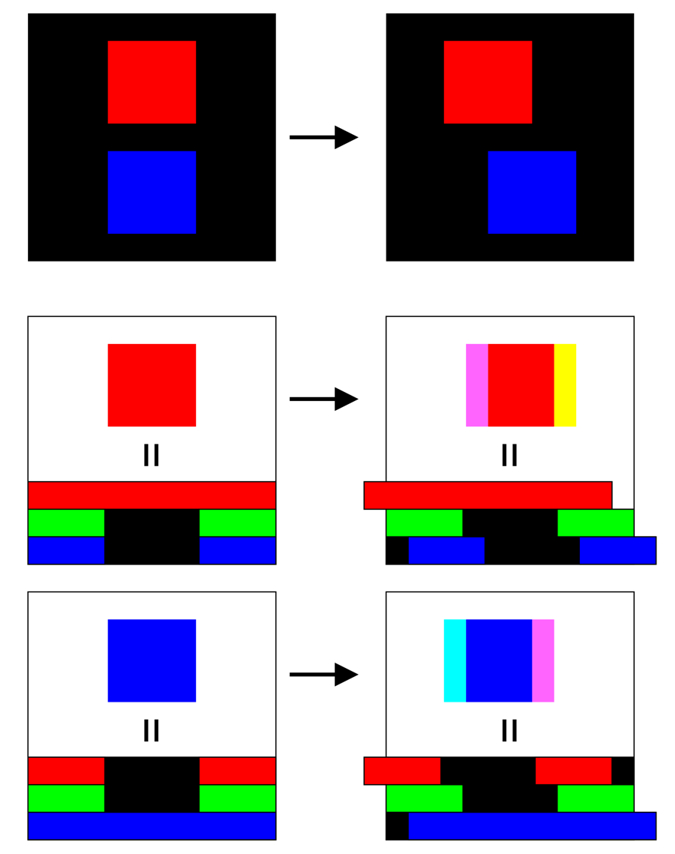
渦巻き錯視
Spiral illusion
同心円が渦巻きに見える。
Concentric circles appear to be spirals.
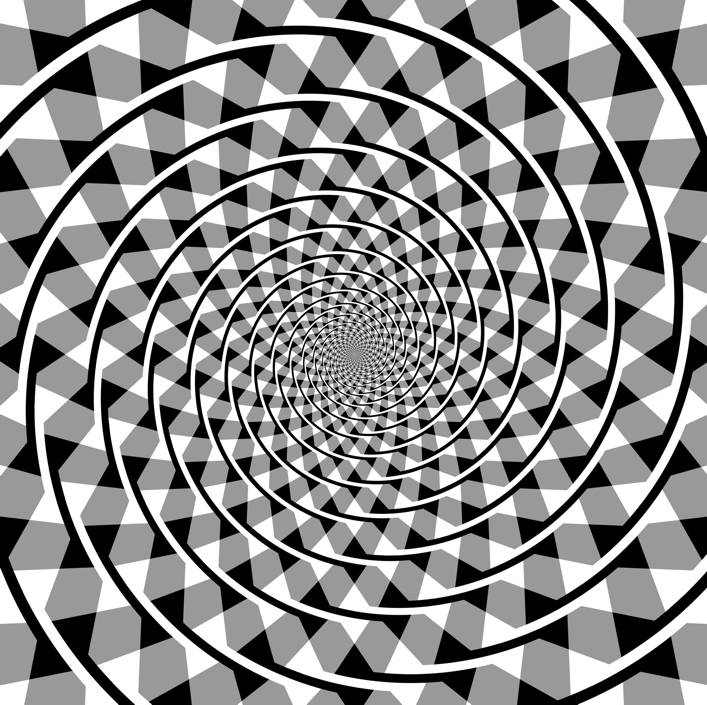
Fraser's spiral
The term "spiral illusion" had long referred to the spiral illusion of the Fraser illusion (Fraser, 1908) before we elucidated that any tilt illusion can form spiral illusion (Kitaoka, Pinna and Brelstaff, 2001). This page shows a copy of Fraser's spiral produced by PC programming. <2003/8/30>
Fraser, J. (1908) A new visual illusion of direction. British Journal of Psychology, 2, 307-320.
Kitaoka, A., Pinna, B., and Brelstaff, G. (2001). New variations of spiral illusions. Perception, 30, 637-646.
Catalogue of spiral illusions (in Japanese) (配布物)
北岡明佳 (2006) 渦巻き錯視のメカニズム じっきょう数学資料, 52, 13-15. PDF
"Spiral blood vessel"
Red concentric rings appear to be spirals.
Copyright Akiyoshi Kitaoka 2007 (June 26)
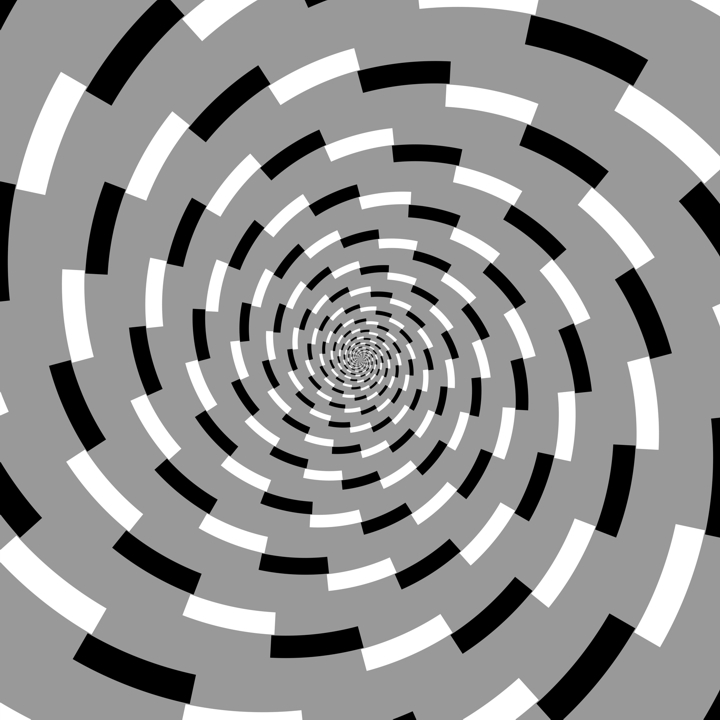
Simple version of the spiral illusion of the Fraser illusion
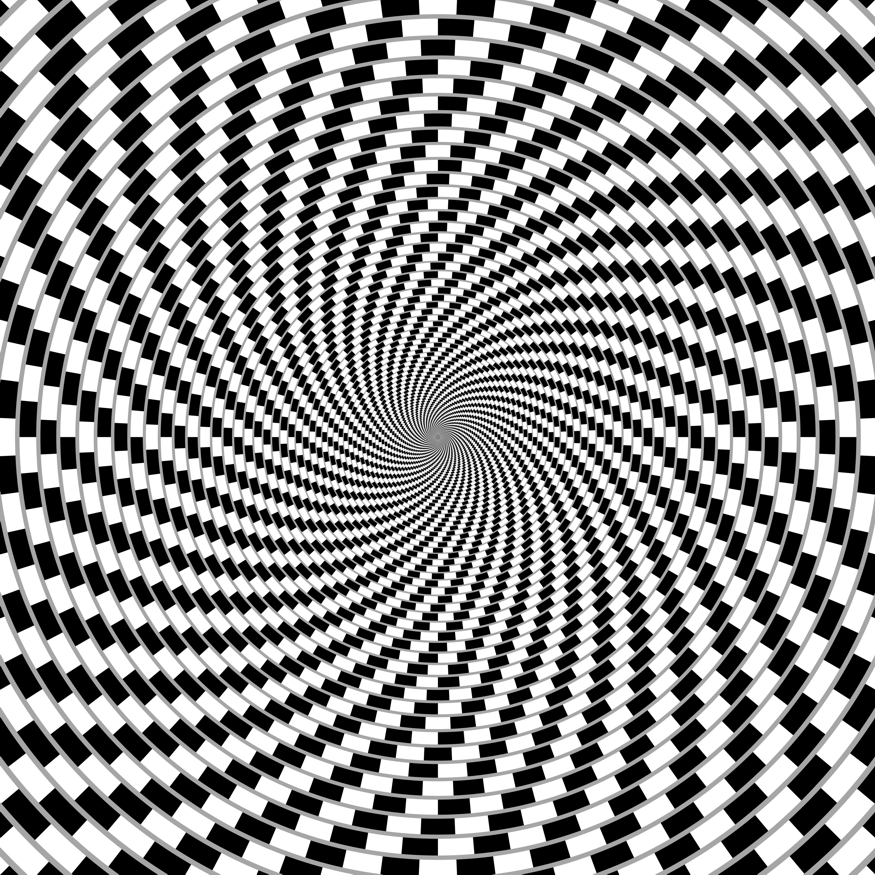
Spiral illusion of the Cafe Wall illusion

"Songs of
frogs"
(a remake)
Concentric arrays of dots appear to be spirals.
Copyright Akiyoshi Kitaoka 2008 (January 2008)
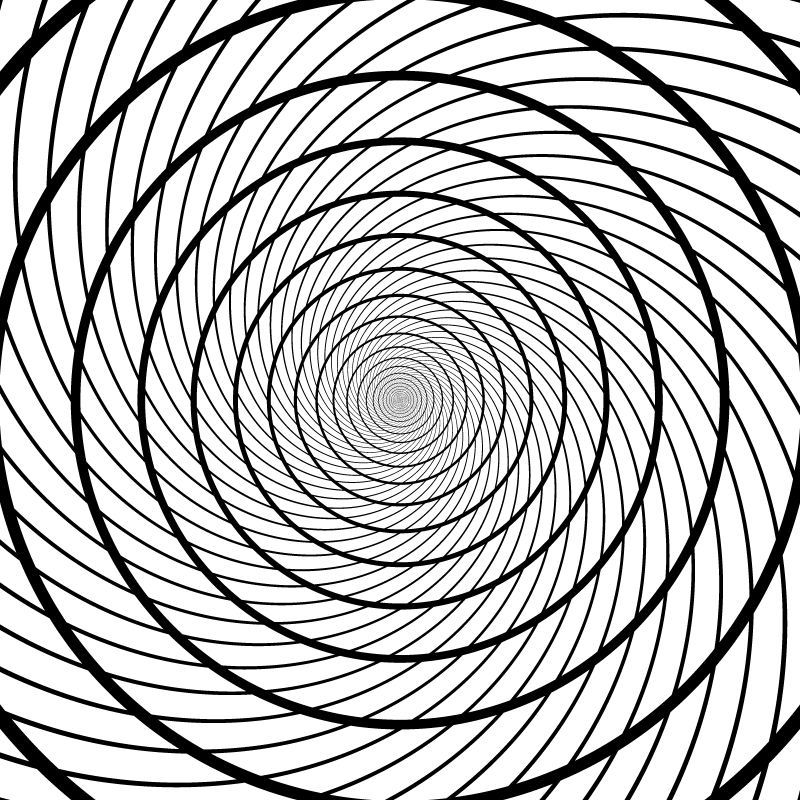
Spiral illusion of the Zöllner illusion
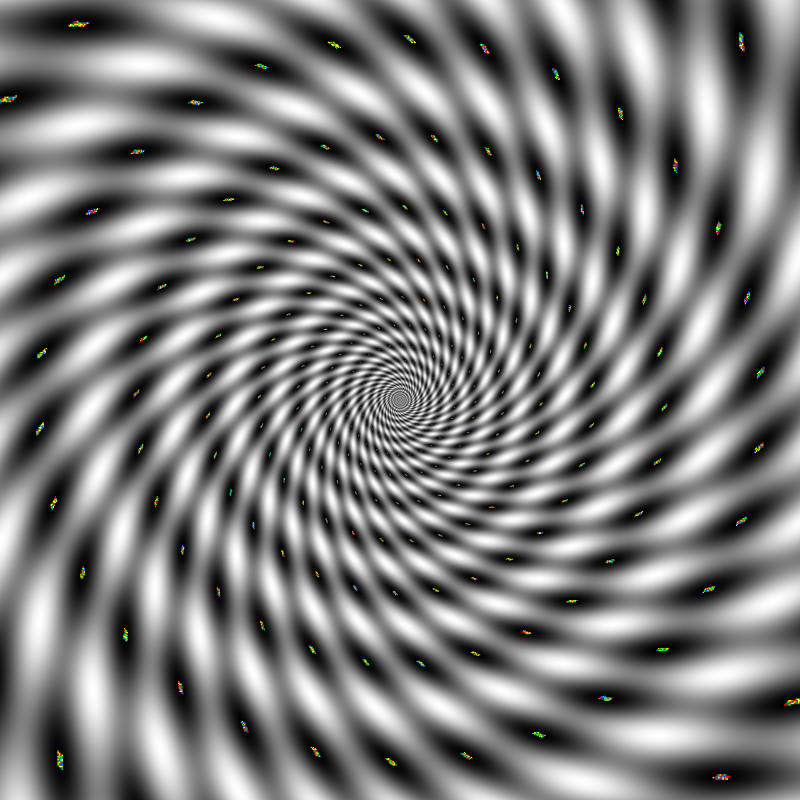
"Spiral warp"
Concentric rings appear to be spirals.
Copyright Akiyoshi Kitaoka 2007 (June 29)
equiangle = 45 deg
The spiral illusion of the Zöllner illusion:
Kitaoka, A., Pinna, B., and Brelstaff, G. (2001). New variations of spiral illusions. Perception, 30, 637-646.
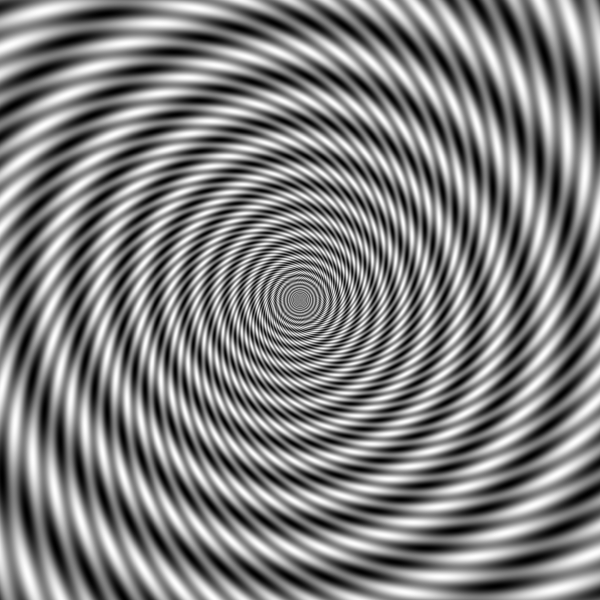
Spiral illusion of the Zöllner illusion
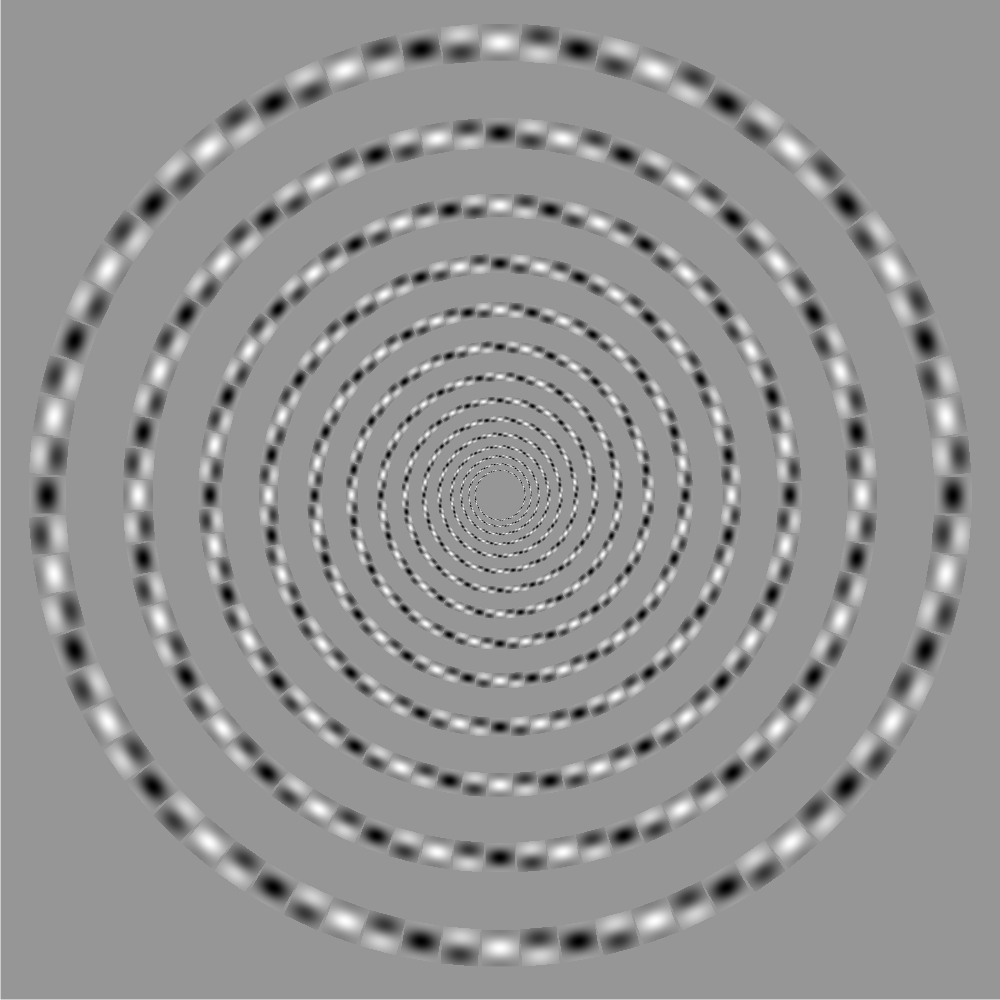
Spiral illusion of the Popple illusion
Copyright Akiyoshi Kitaoka 2007 (August 29)
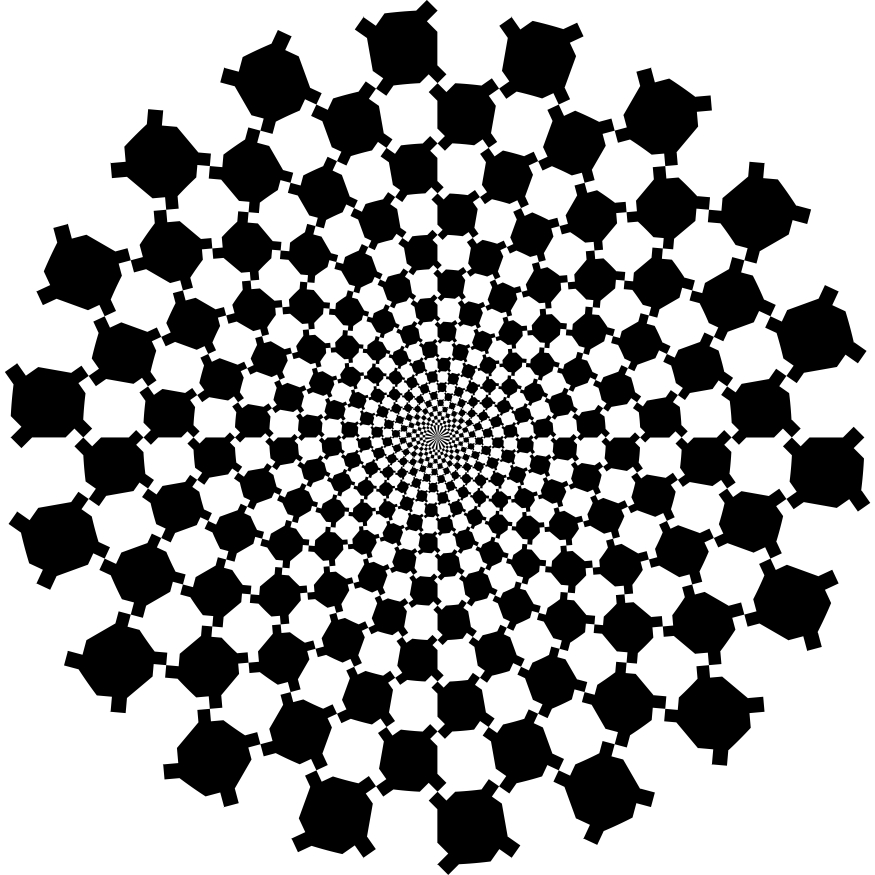
Spiral illusion of the illusion of fringed edges
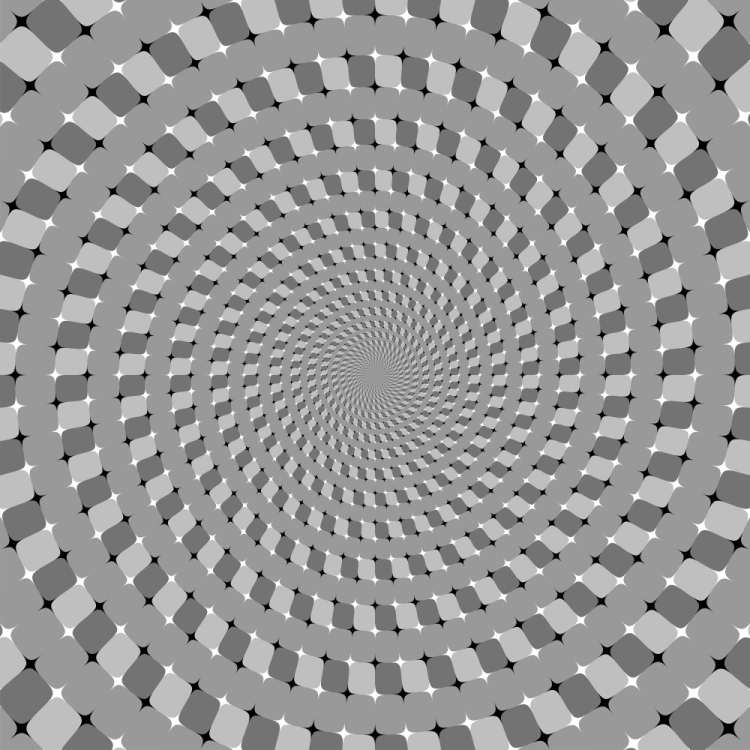
Spiral illusion of the illusion of Y-junctions
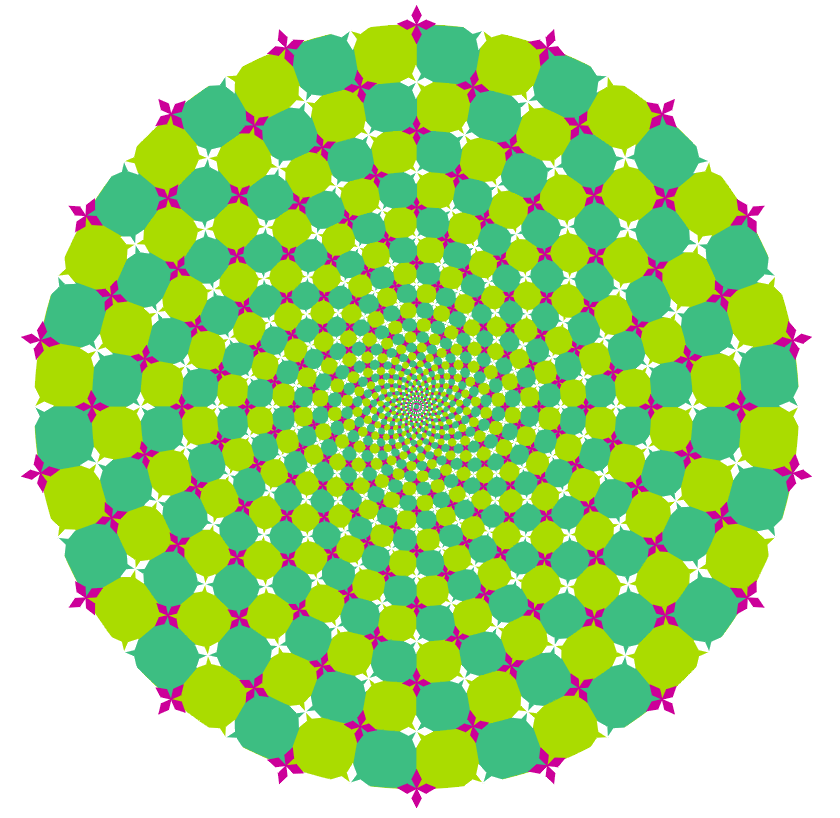
"Primrose's spirals"
Concentric arrays of "flowers" appear to be spirals.
Copyright A.Kitaoka 2002
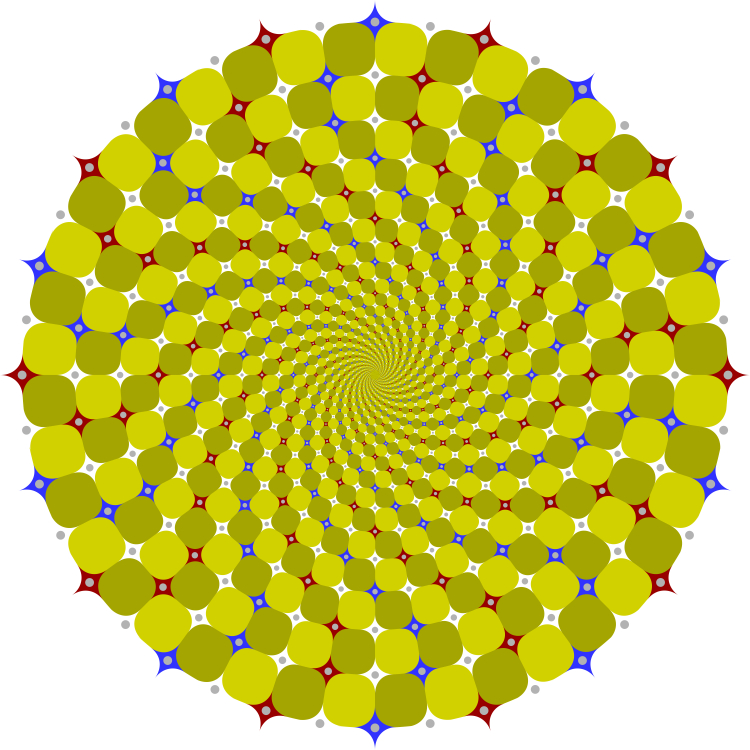
"Neural circuit spirals 2"
Concentric circles appear to be spirals (going to the center by rotating clockwise). Moreover, the inner part appears to rotate clockwise (counterclockwise) when observers approach (move away from) the image keeping their eyes fixed at the center.
Copyright Akiyoshi Kitaoka 2007 (August 7)
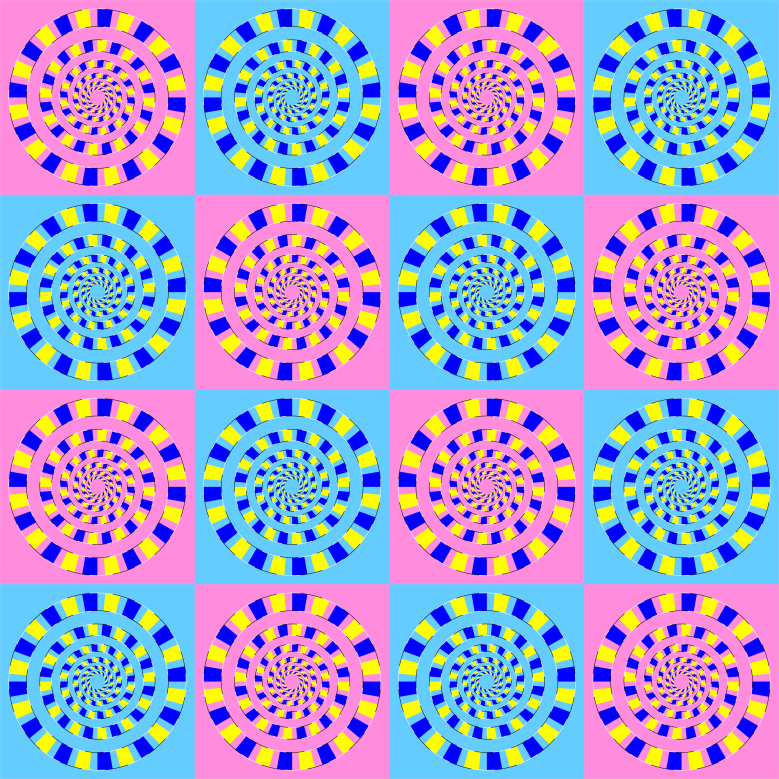
"Packed spirals"
Concentric rings appear to be spirals. Moreover, each set of rings appears to rotate.
Copyright Akiyoshi Kitaoka 2006 (June 13)
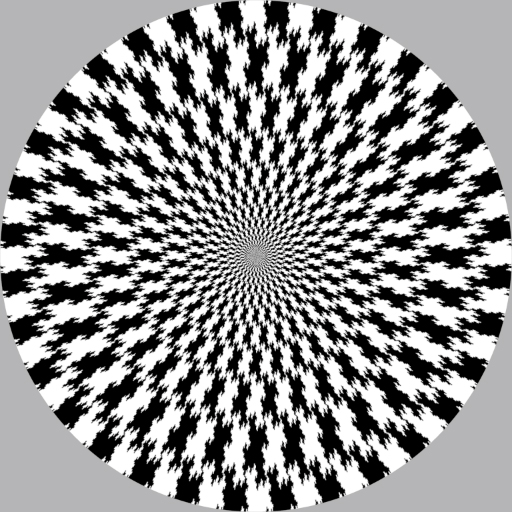
"Fractal spiral illusion"
Concentric rings made up of fractal islands appear to form spirals.
Copyright Hitoshi & Shinobu Arai
2007
from Professor Hitoshi Arai,
Graduate School of Mathematical Sciences, University of Tokyo, October 4,
2007
北岡明佳のコメント: 原理としてはフレーザー錯視のようですが、それよりもなによりも、世界初のフラクタル錯視図形 なのではないでしょうか!? 新井先生の視覚数学e研究室報告に、この錯視の論文が出ました。 <2007年10月4日>
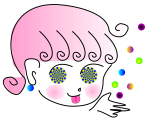 Suggested function
Suggested function
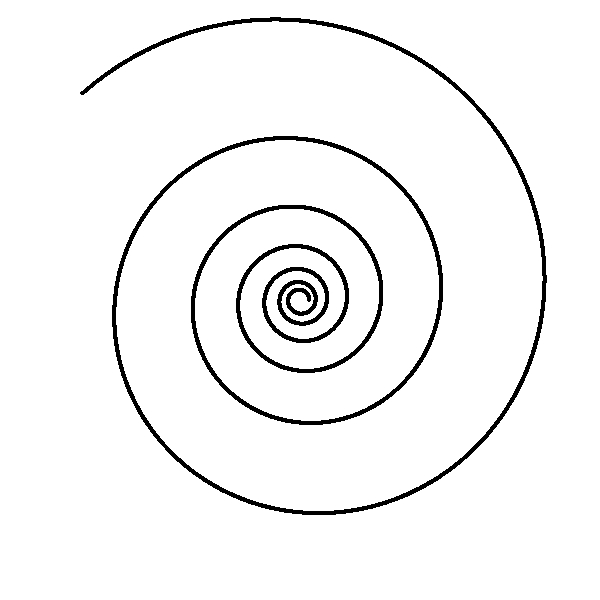
Bernoulli's spiral
r = a exp (k θ)
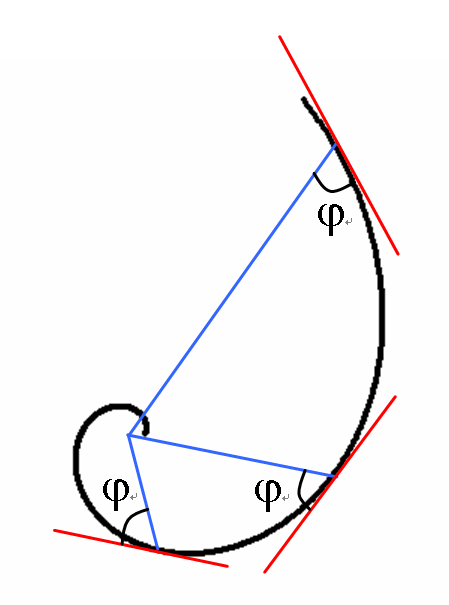
= equiangular spiral
k = 1 / tan (φ)
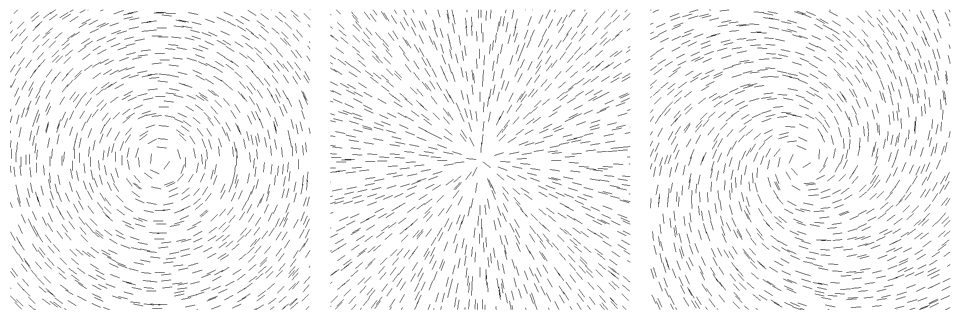
Concentric (φ = 90º), radial (φ = 0º), and spiral (0º < φ < 90º)
Kitaoka, A., Pinna, B., and Brelstaff, G. (2001). New variations of spiral illusions. Perception, 30, 637-646.
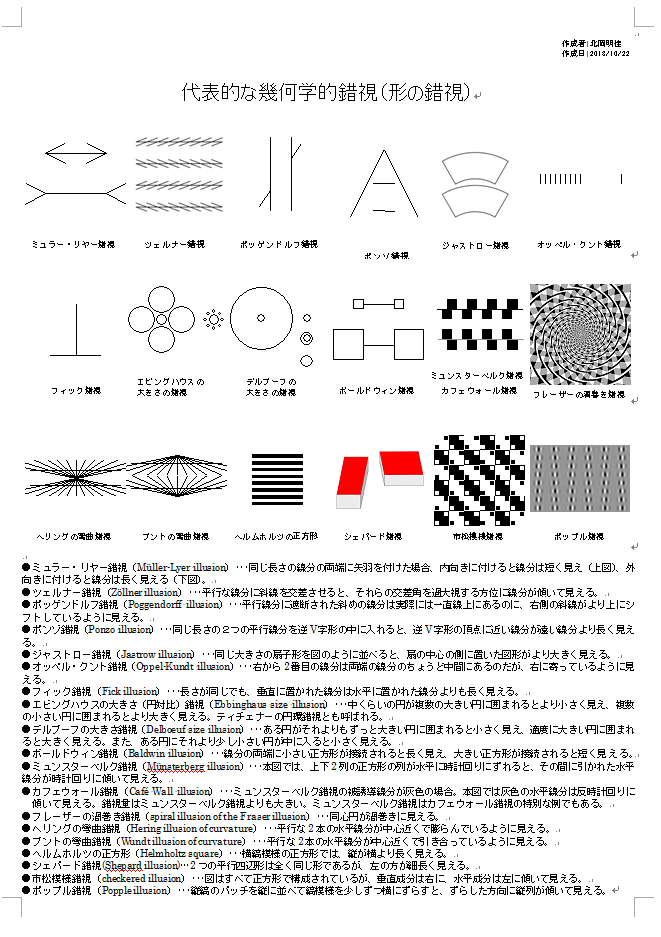
幾何学的錯視の一覧(Geometrical illusions)
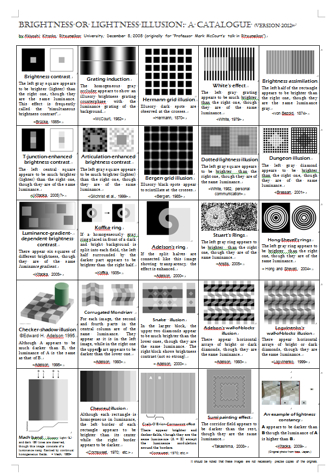
明るさの錯視の一覧(Brightness/lightness illusions)
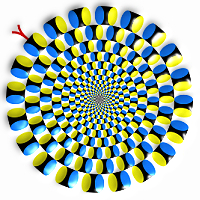
錯視とは何か、を考えさせるムービー: http://www.youtube.com/watch?v=z2B_OaEvq68
